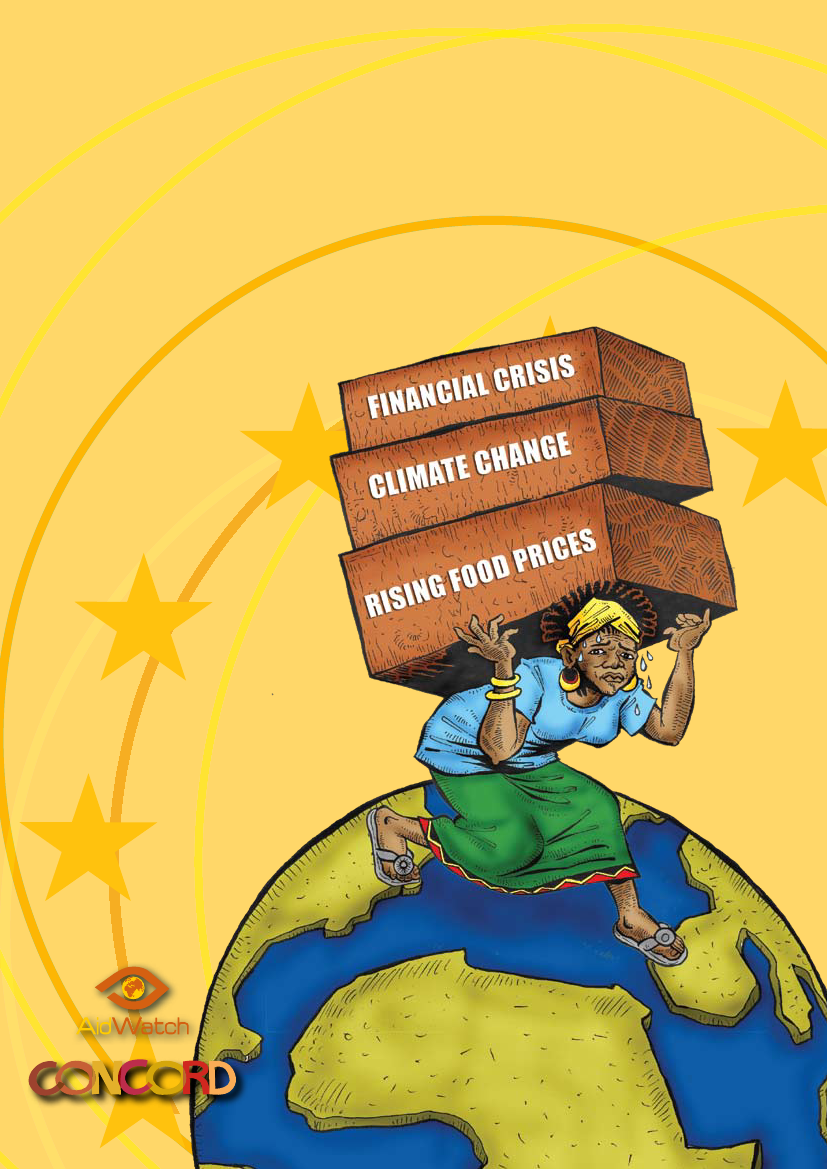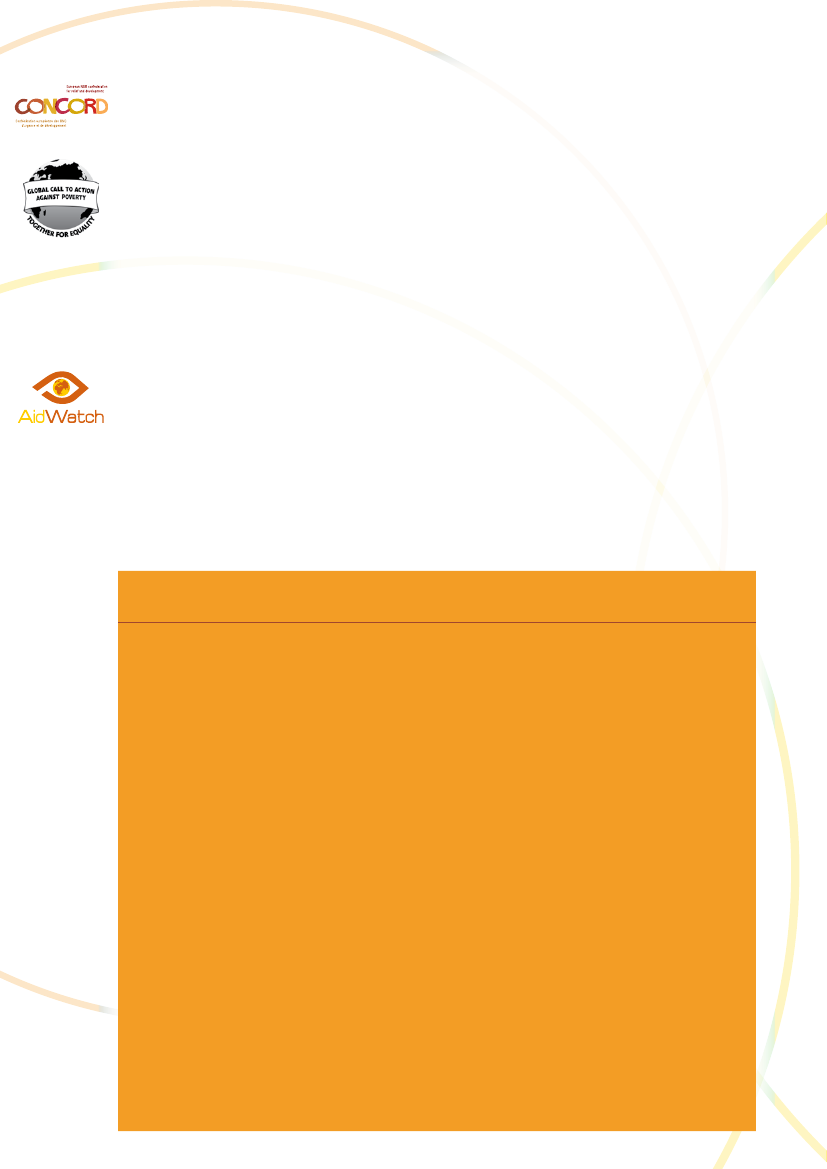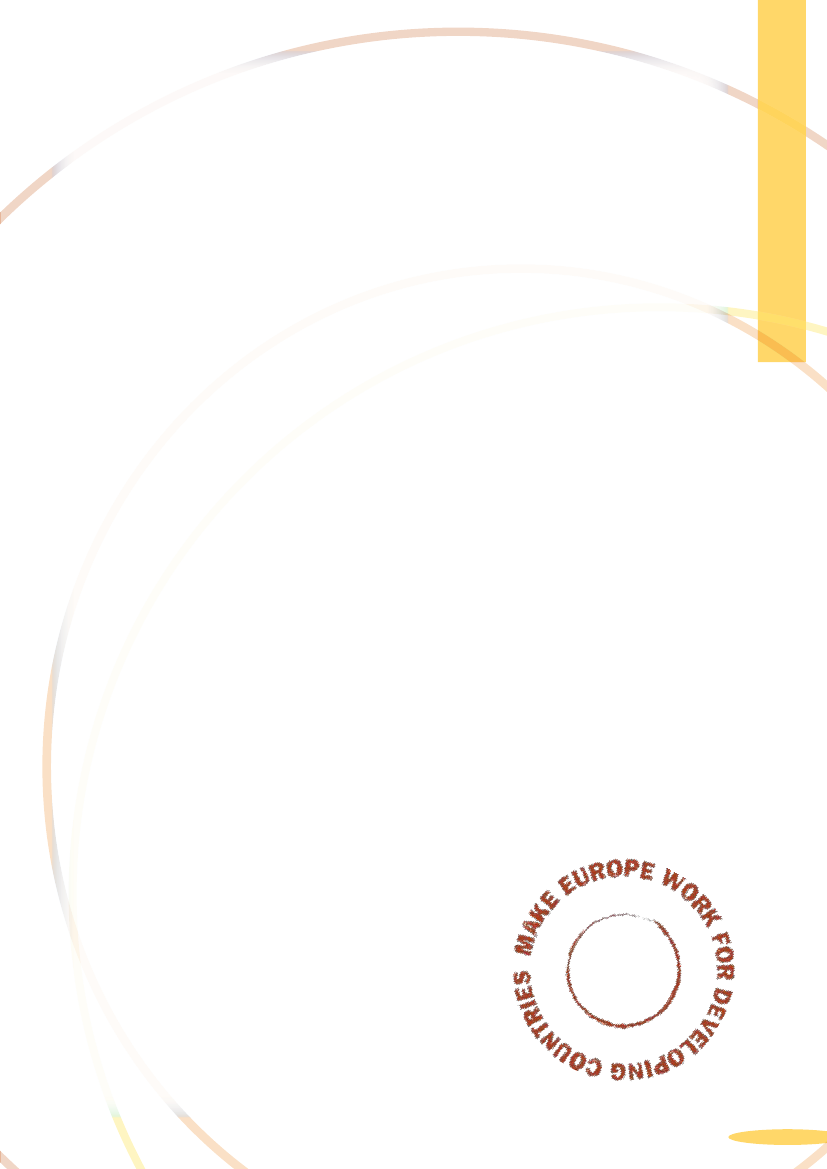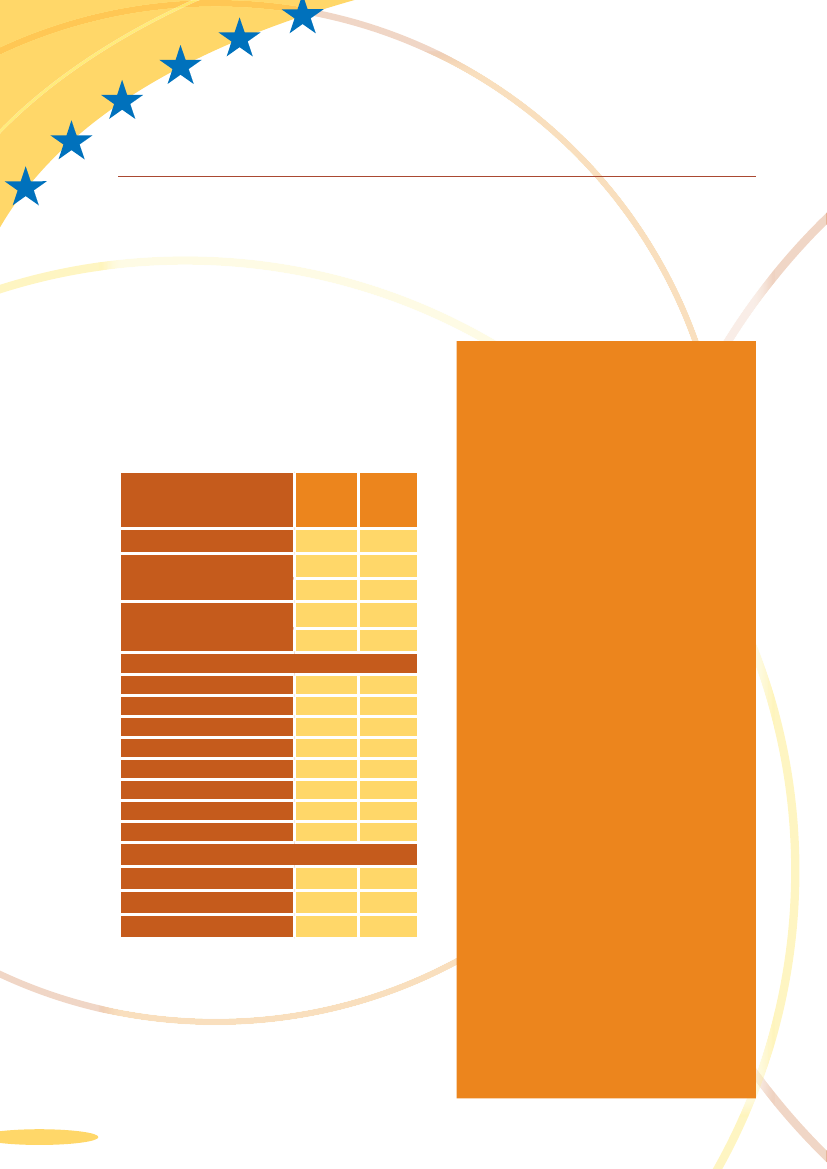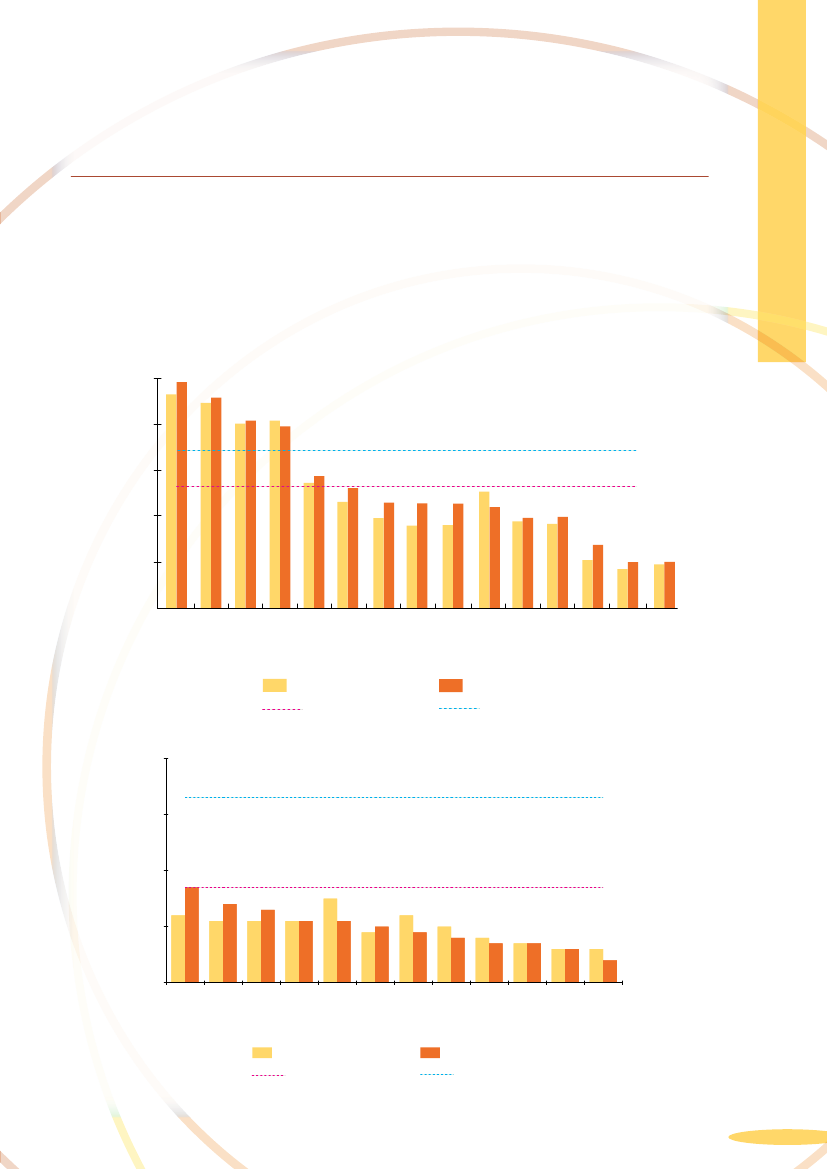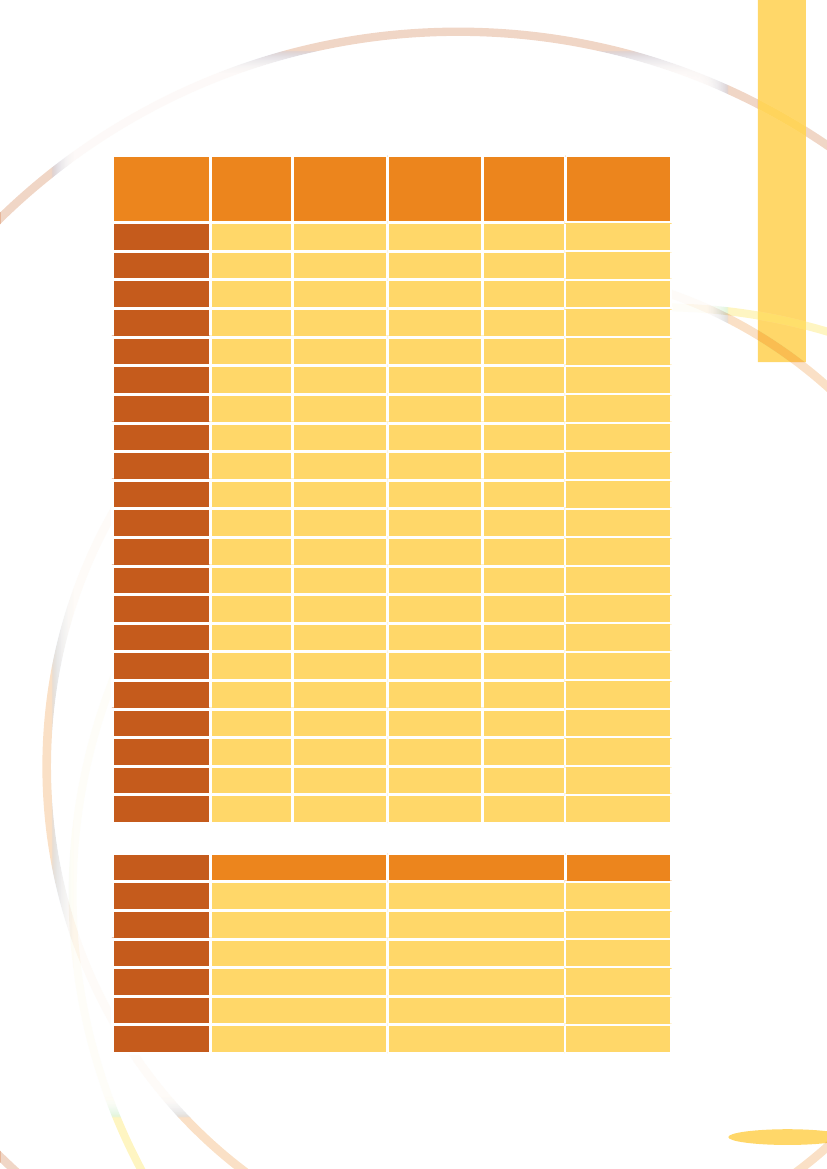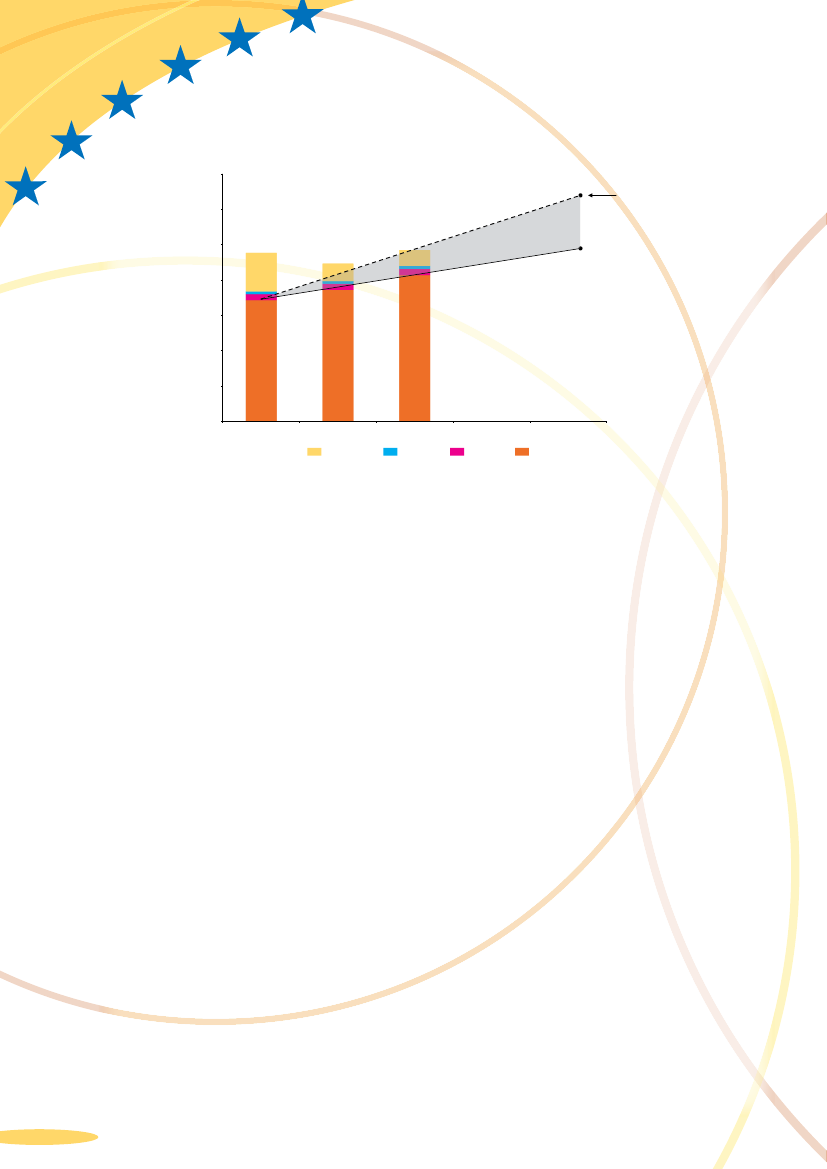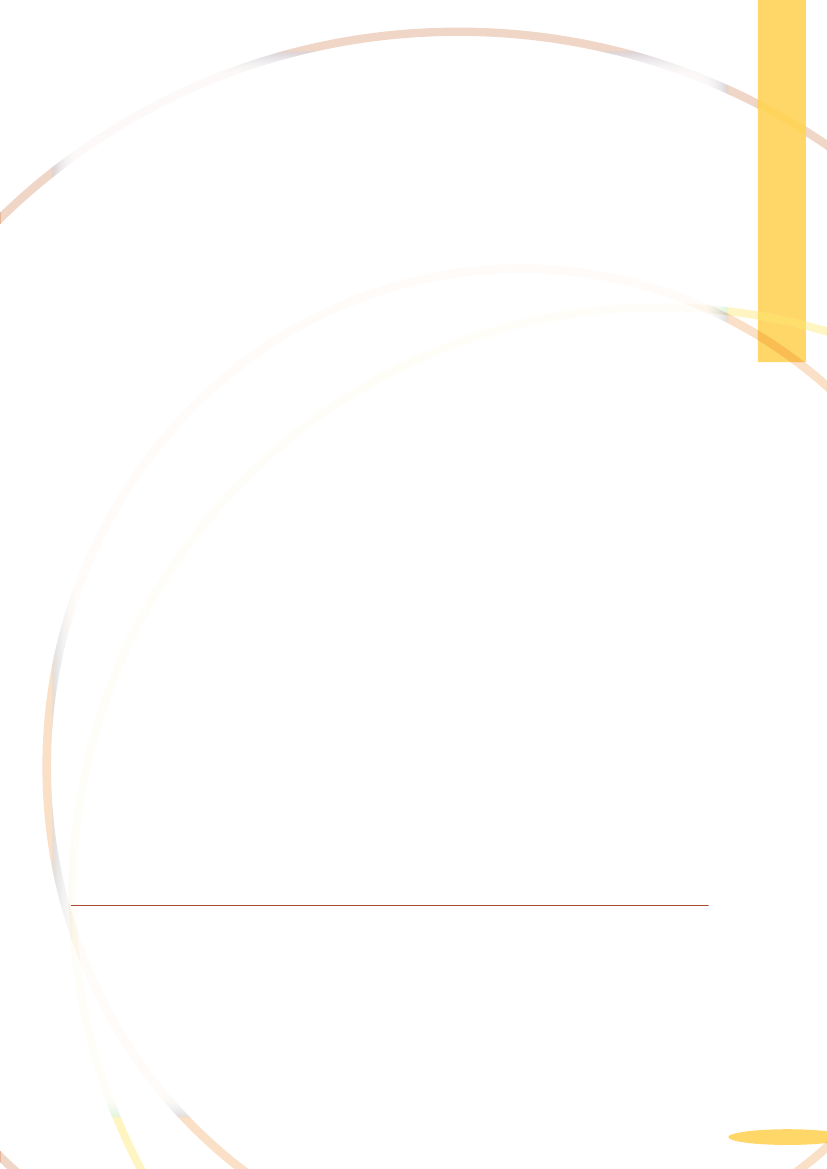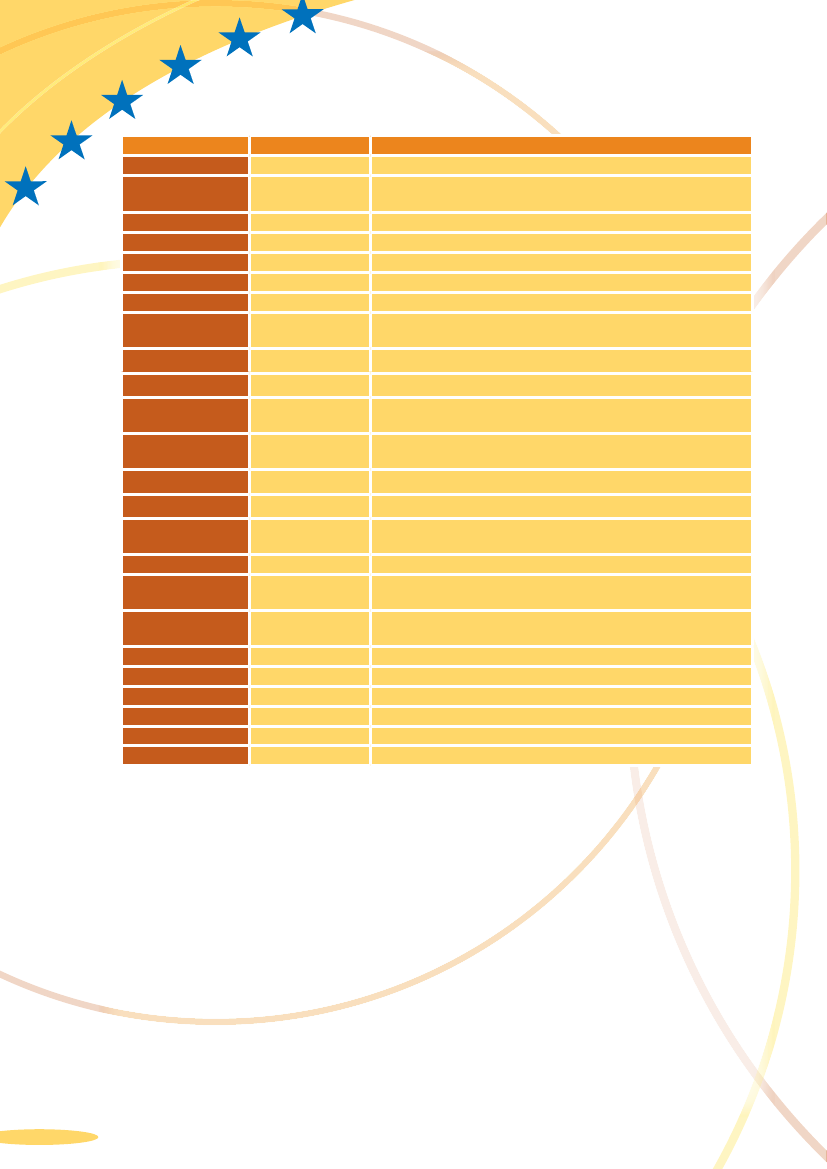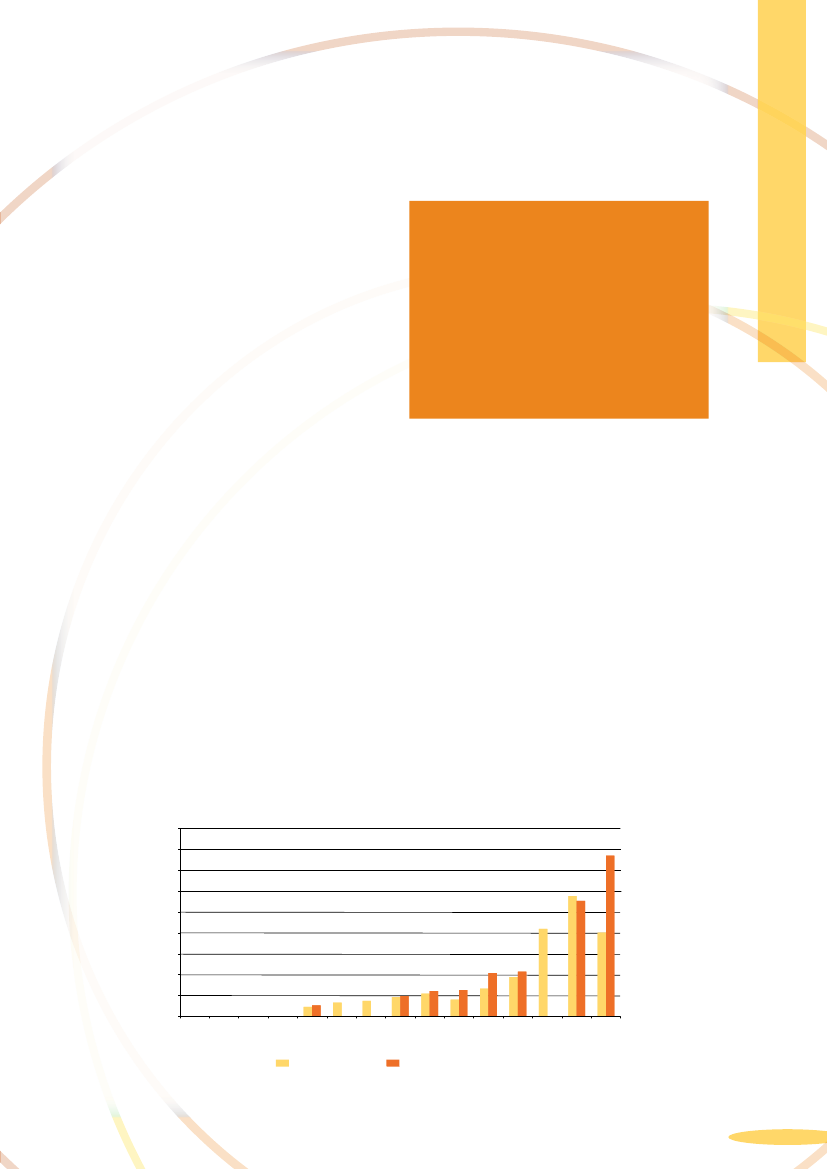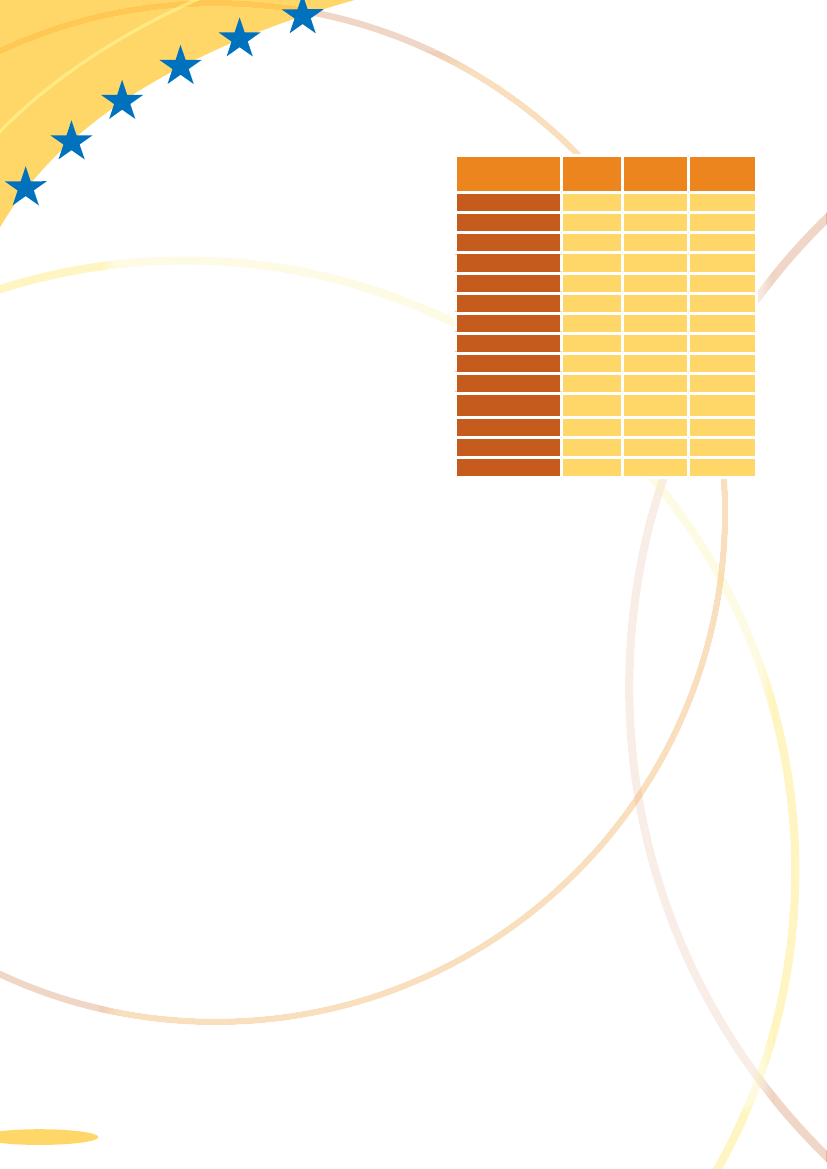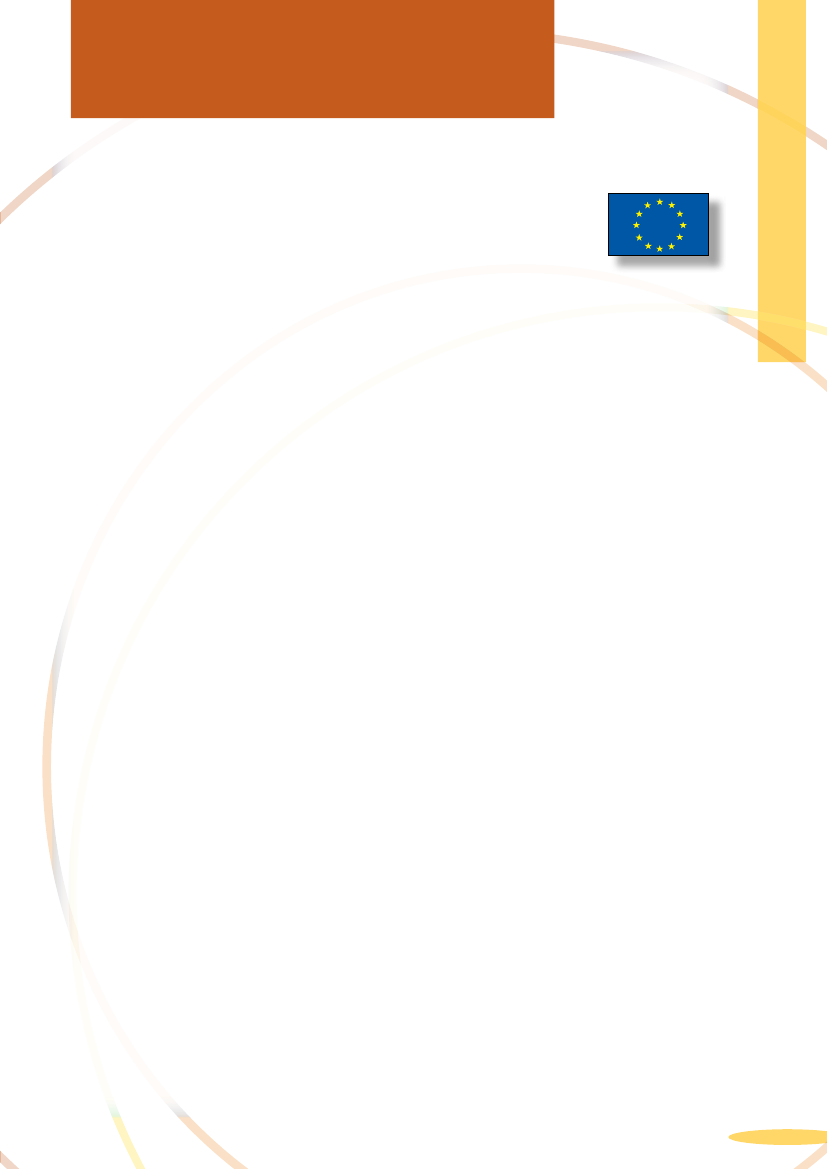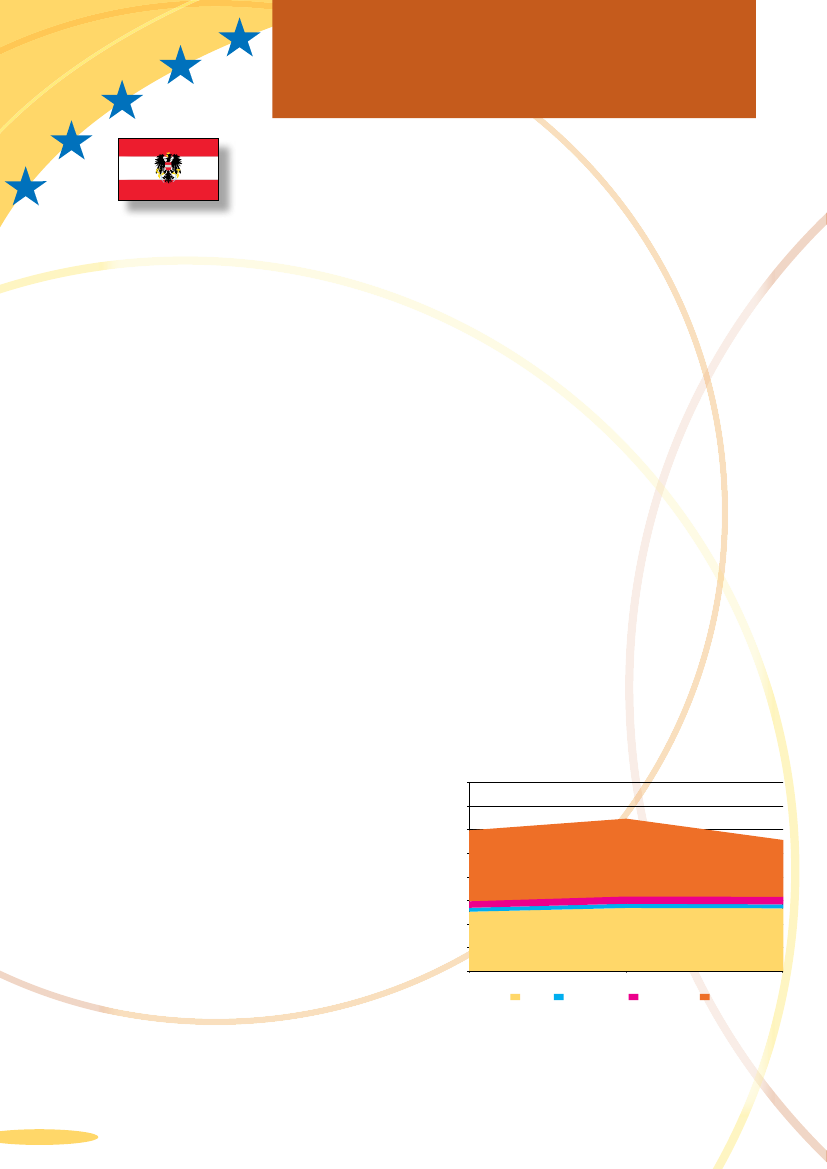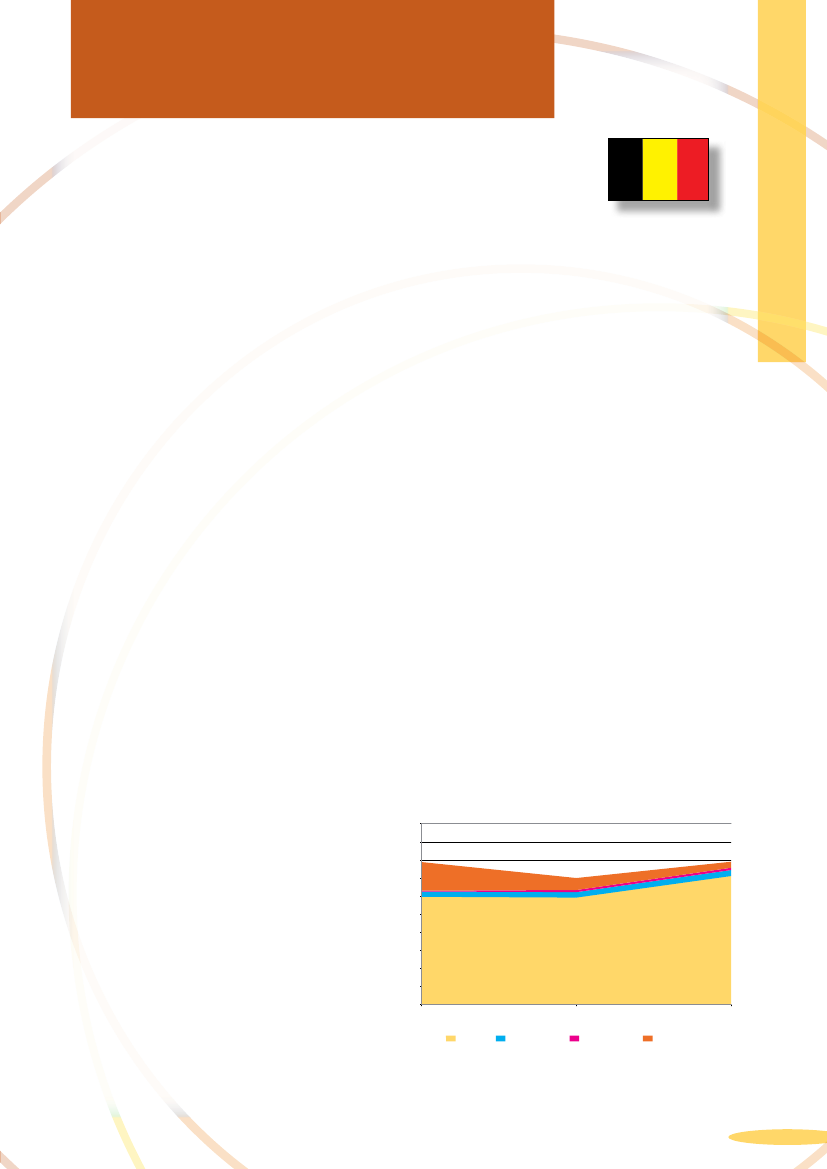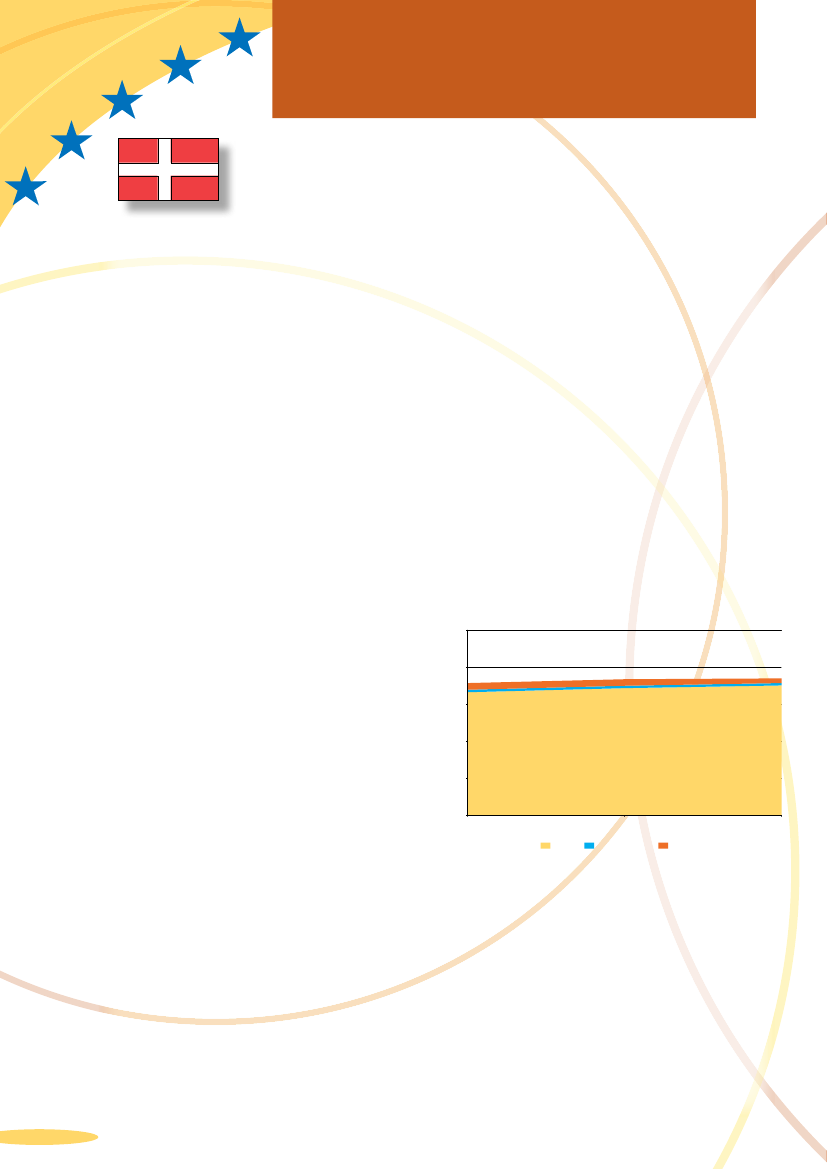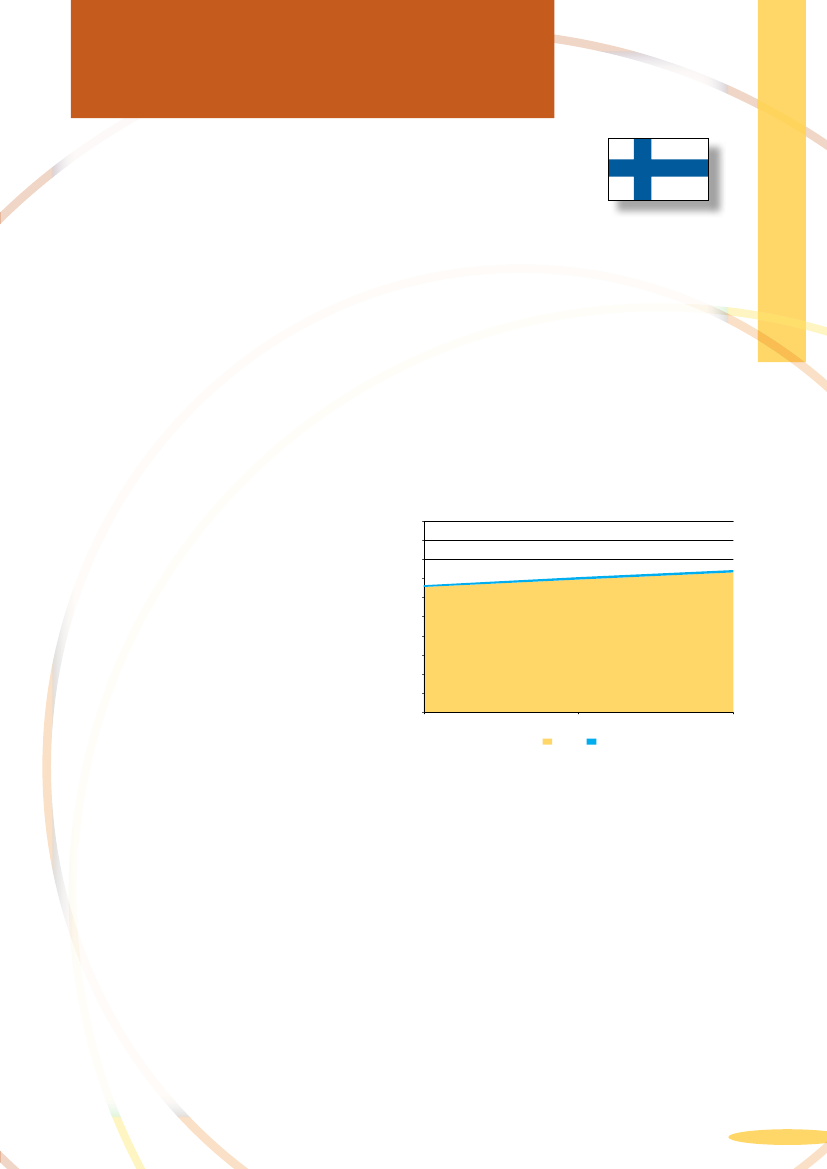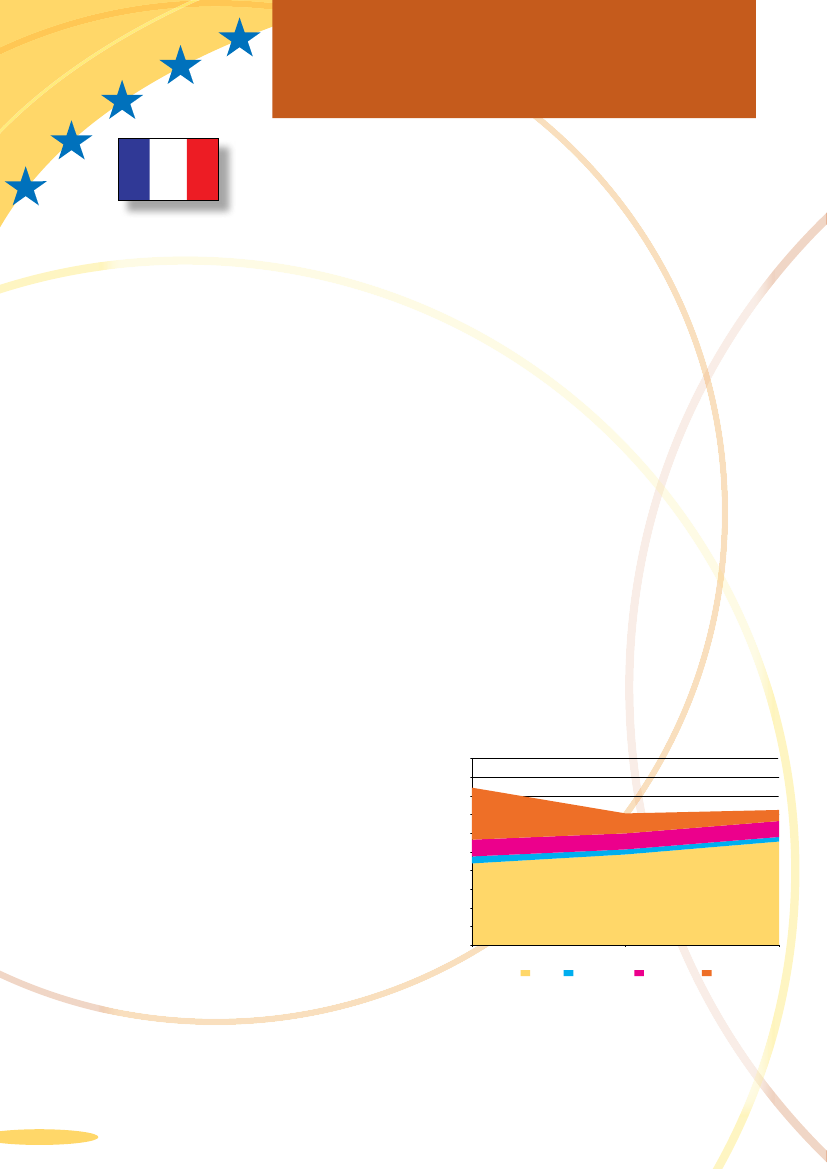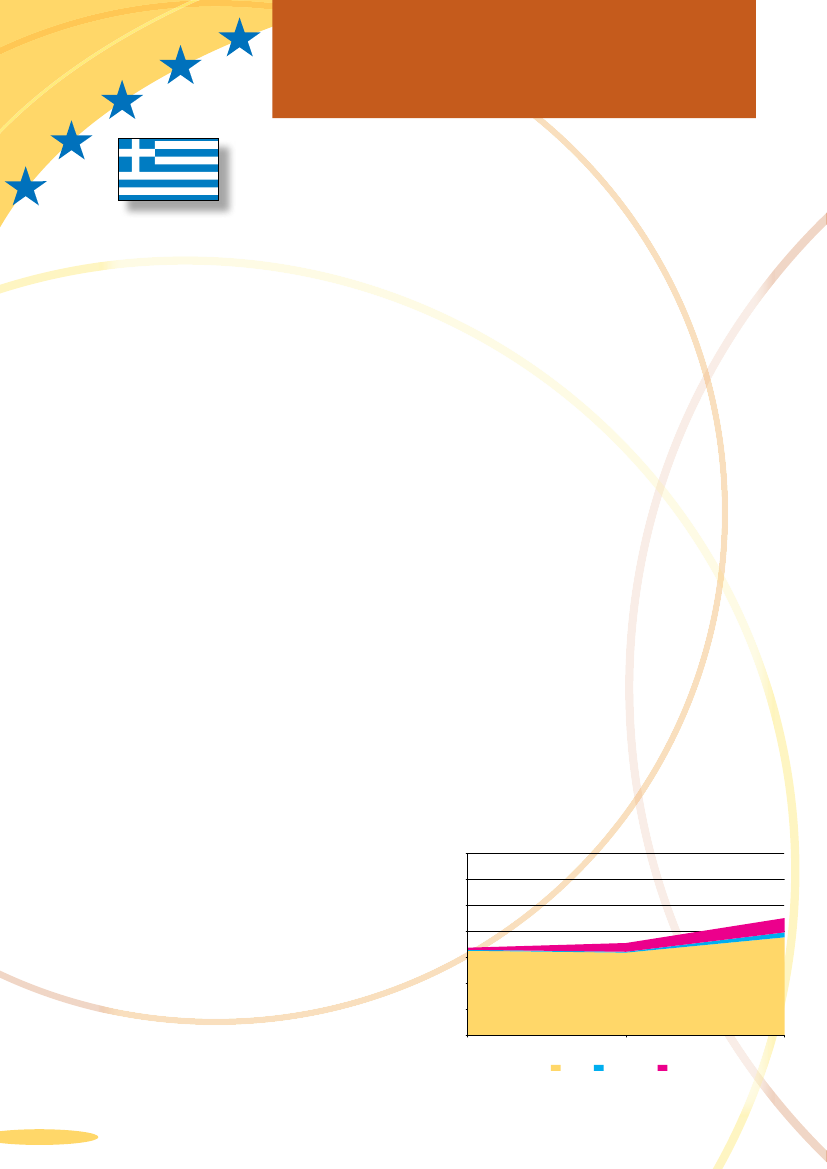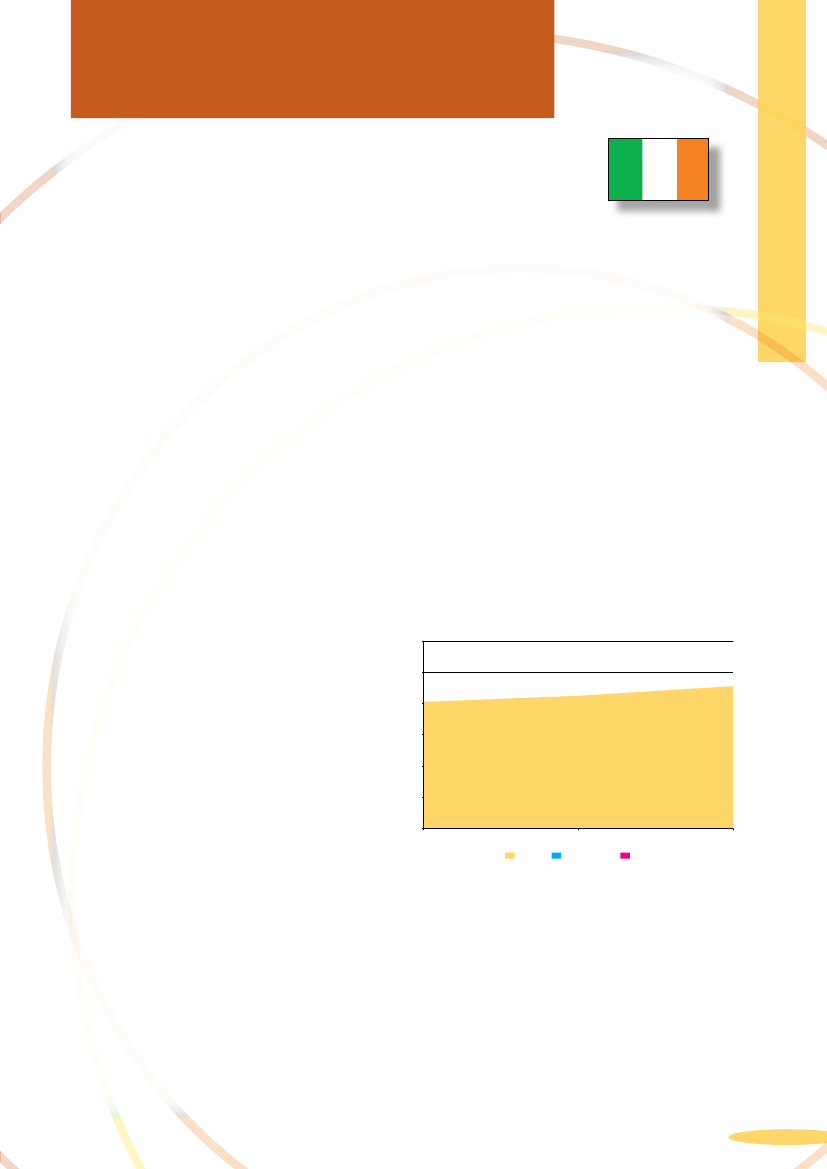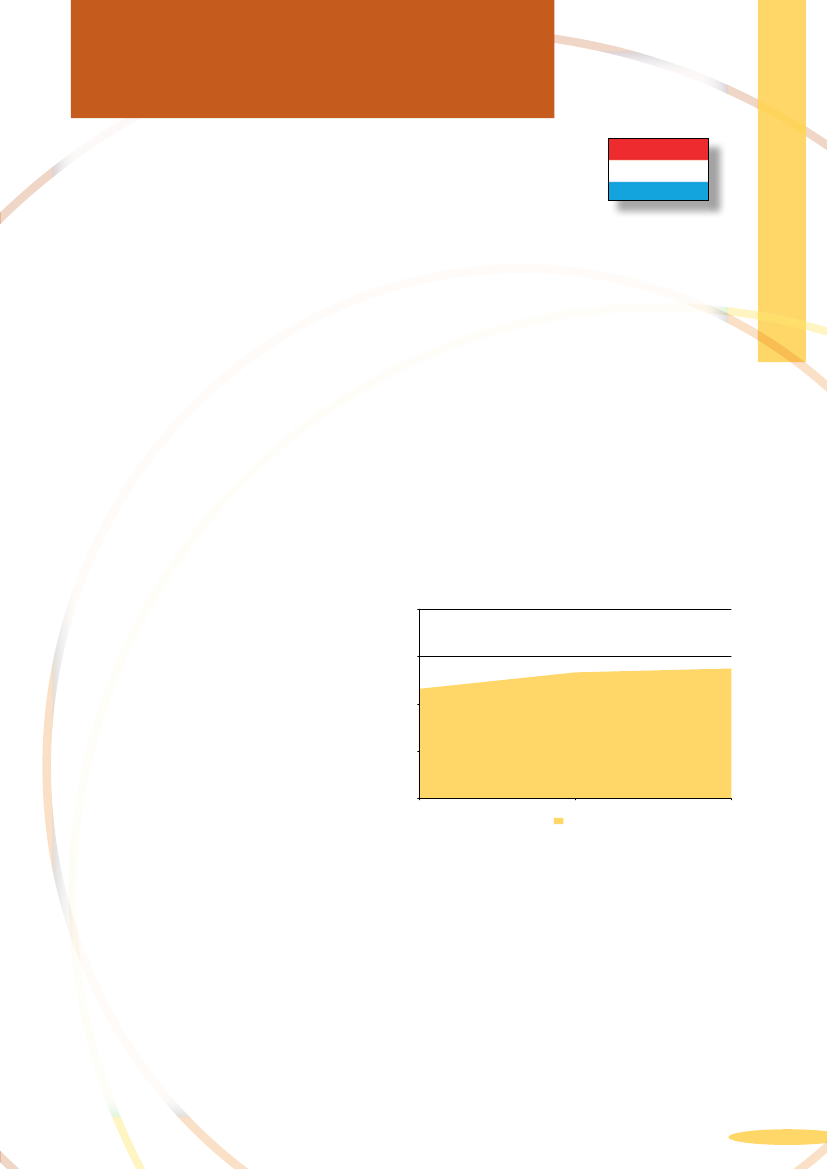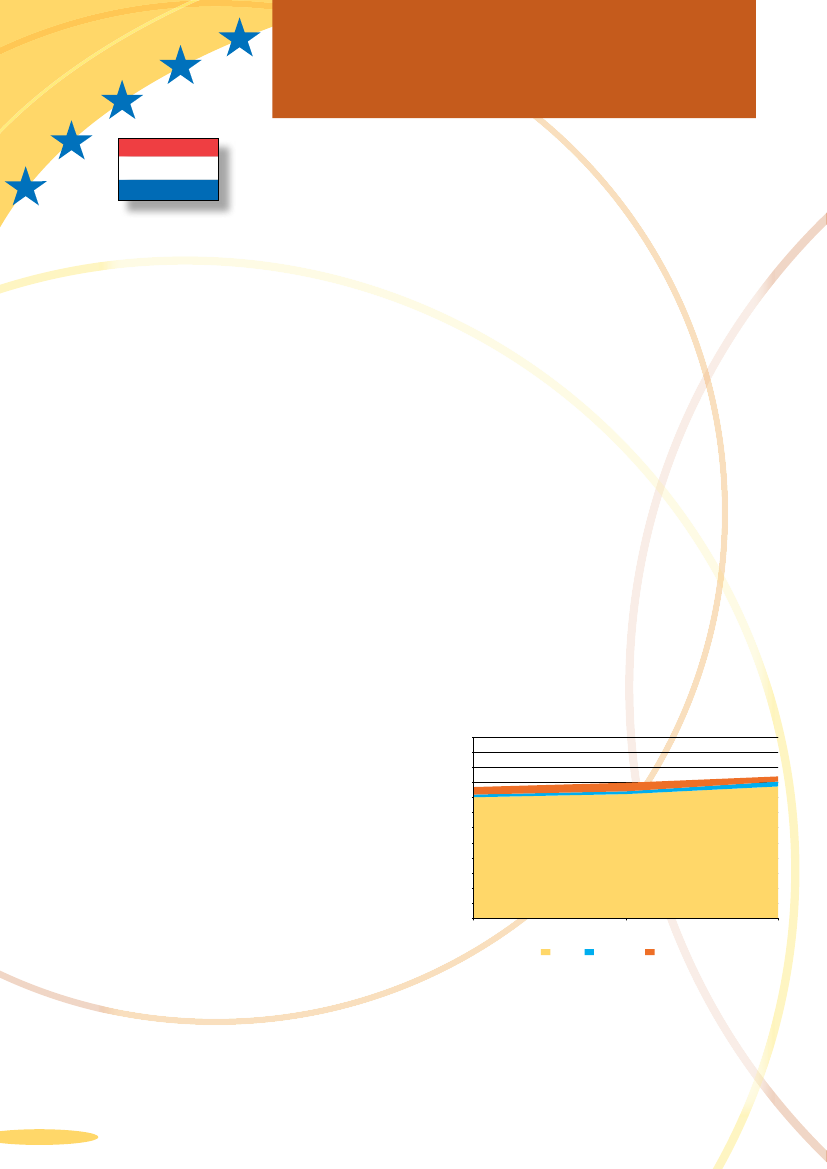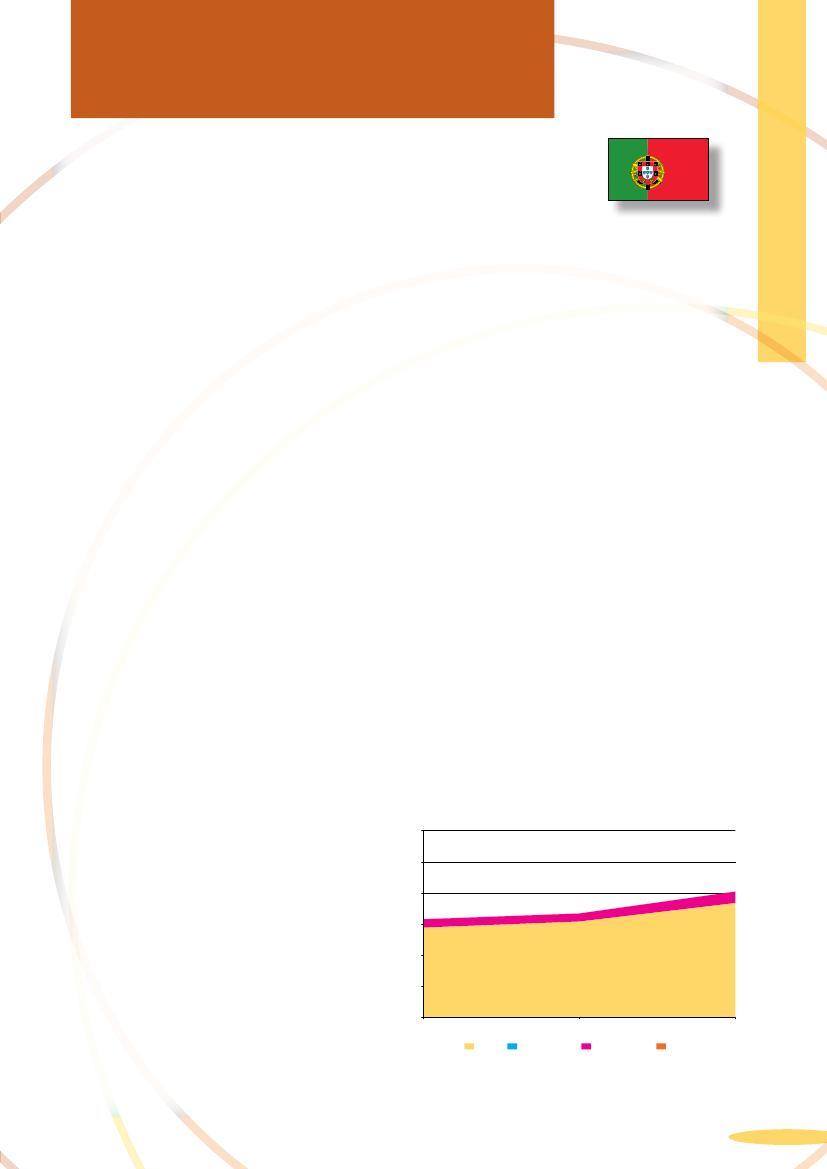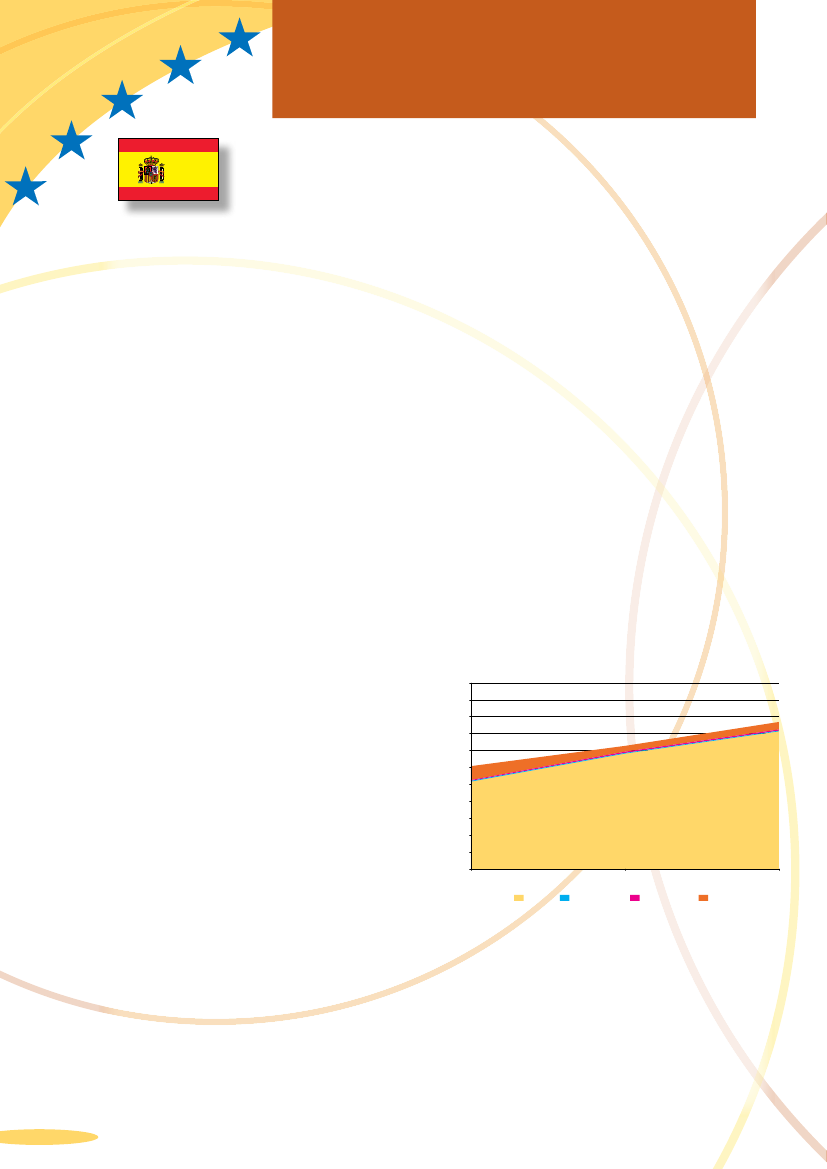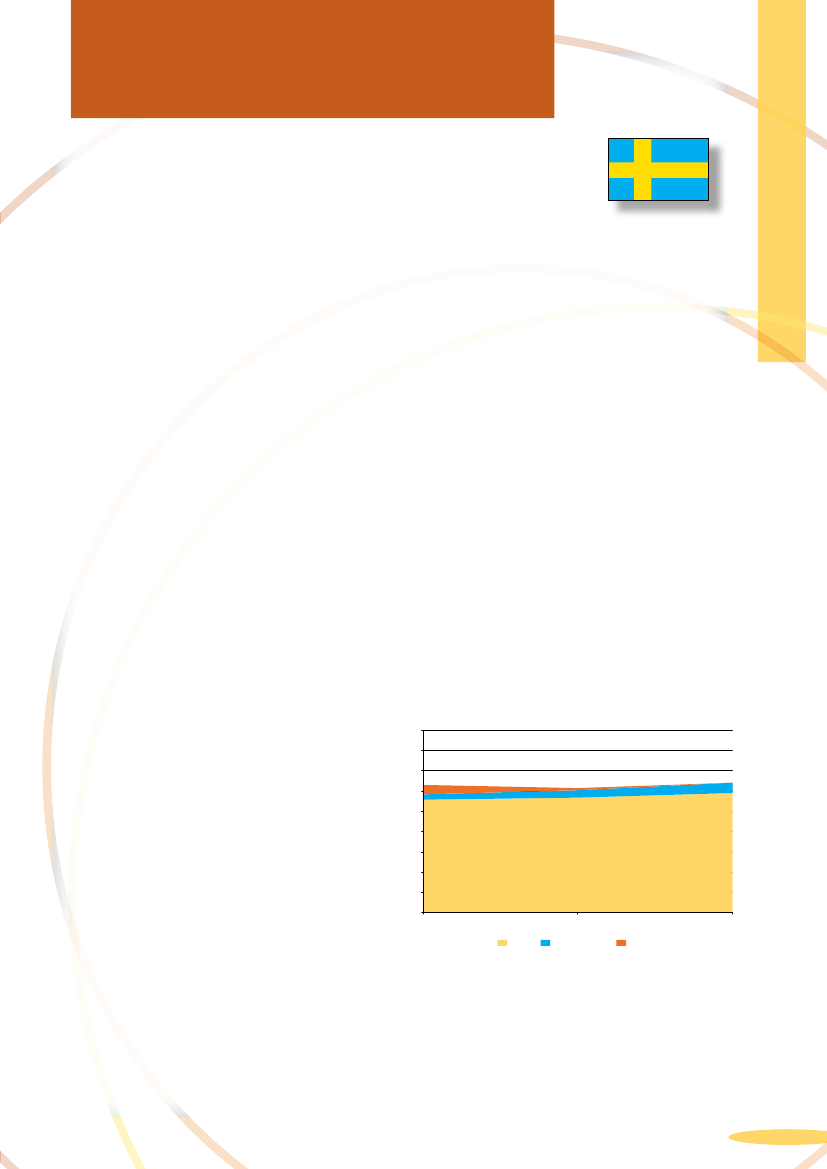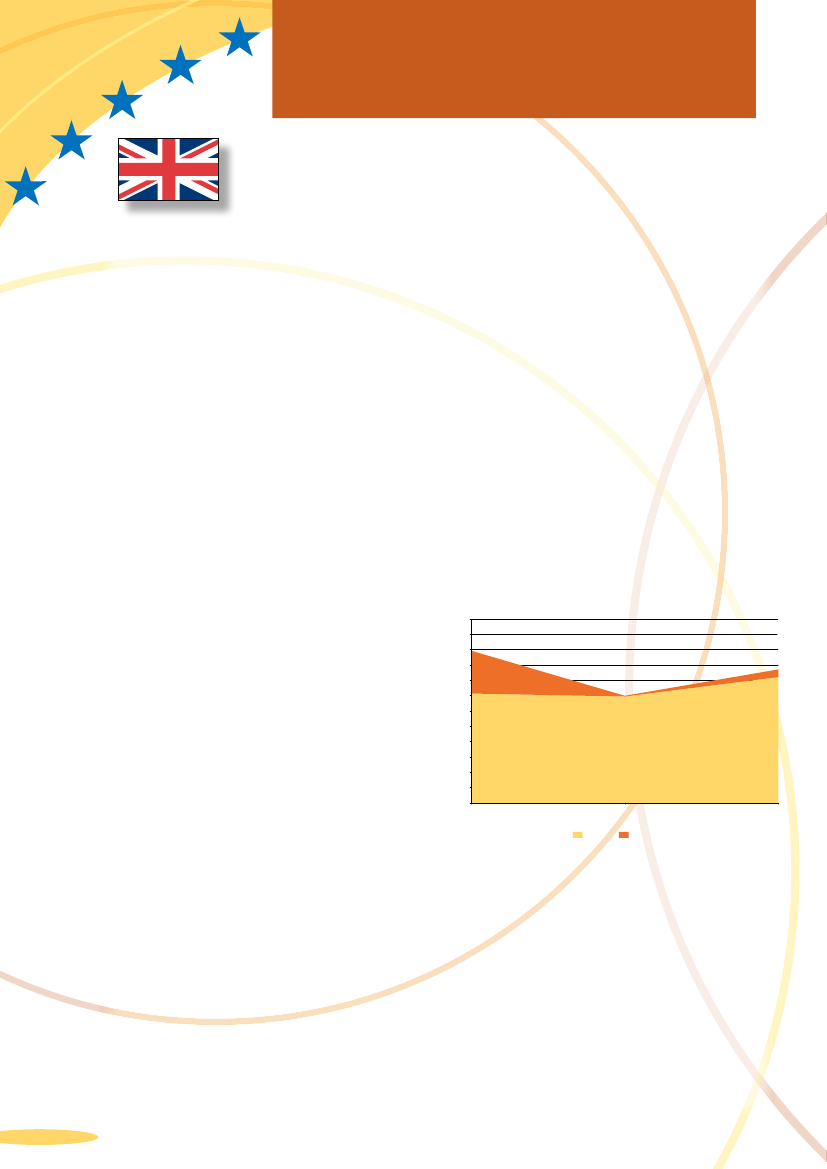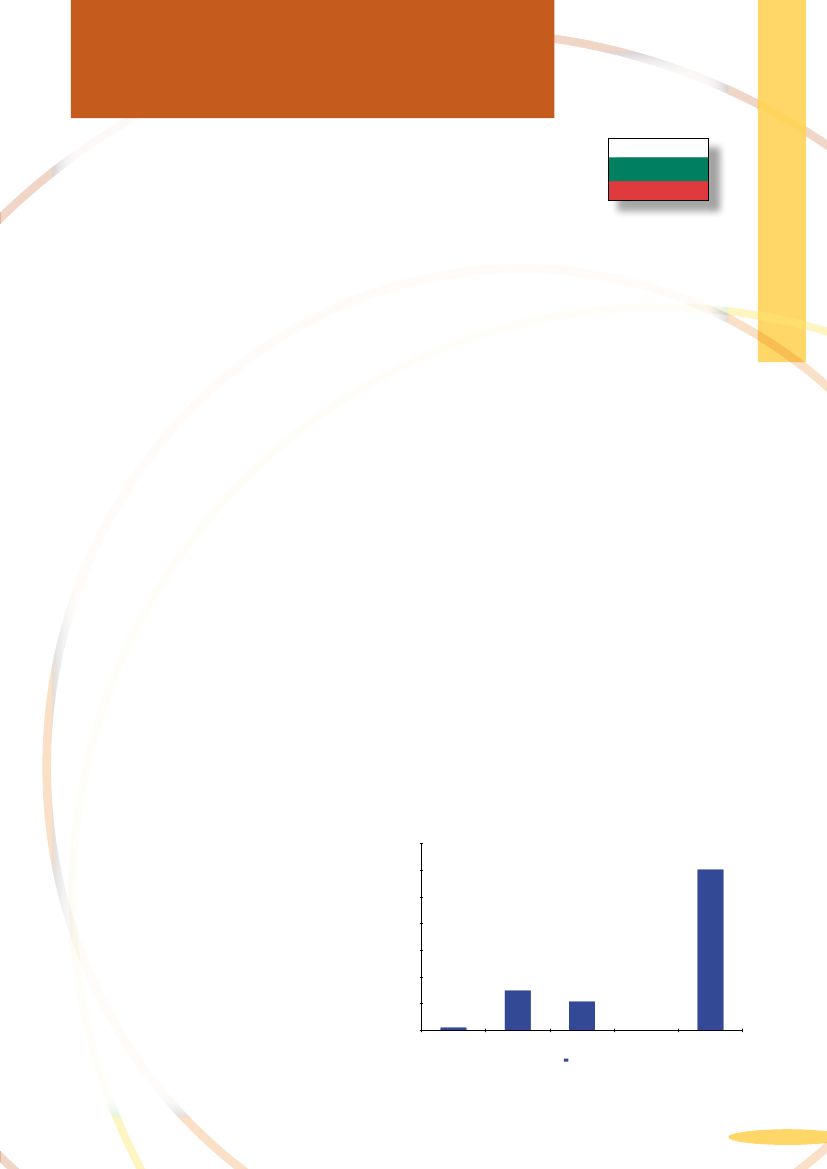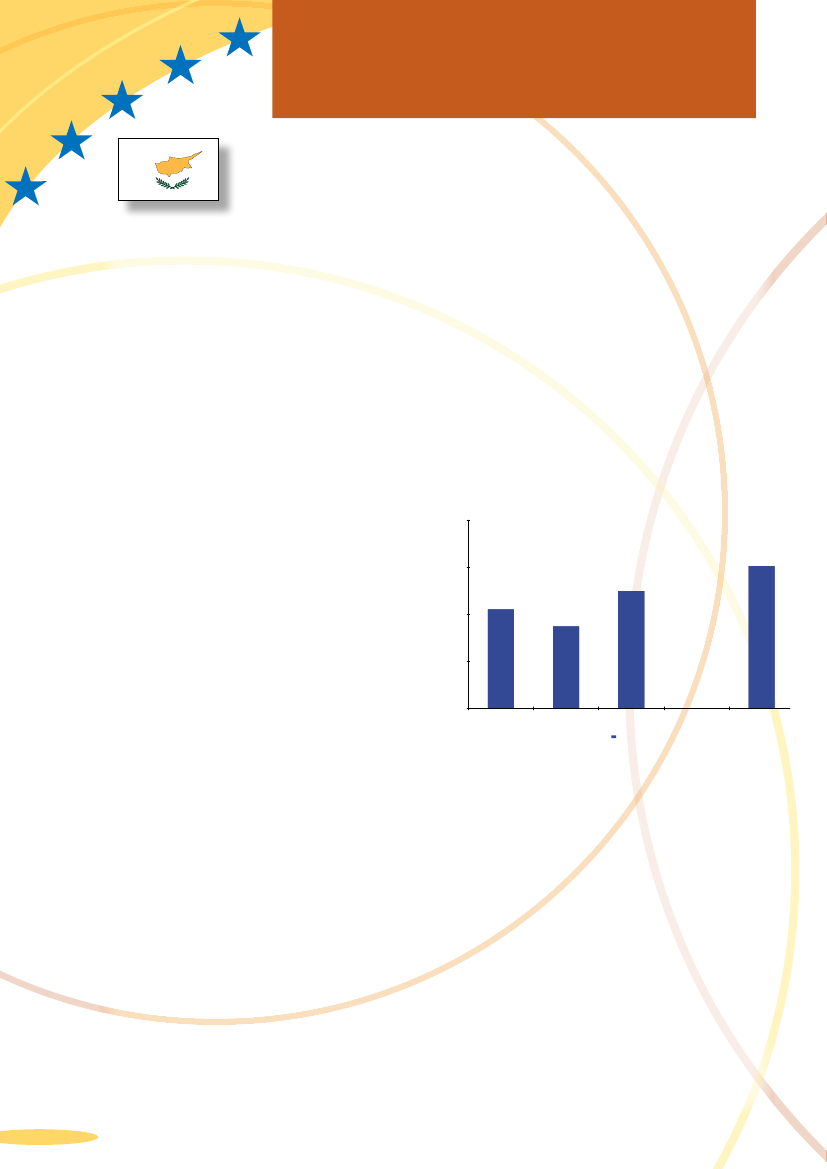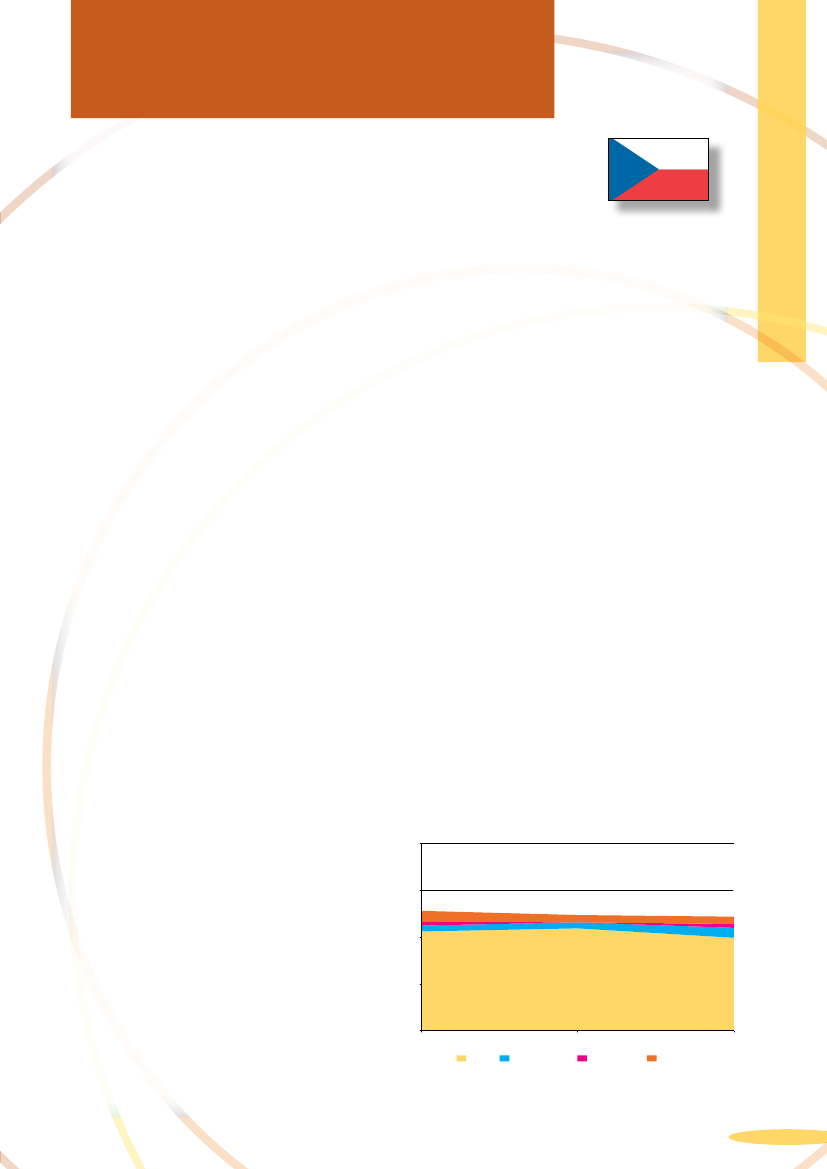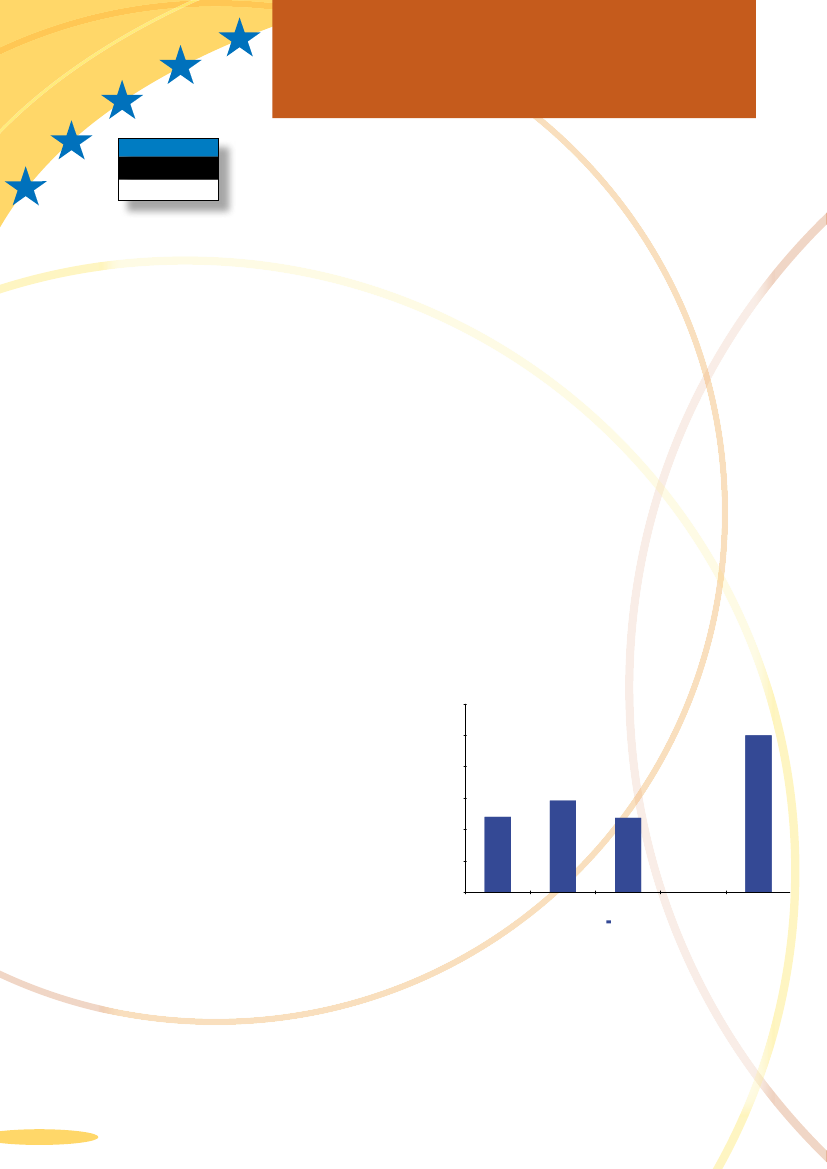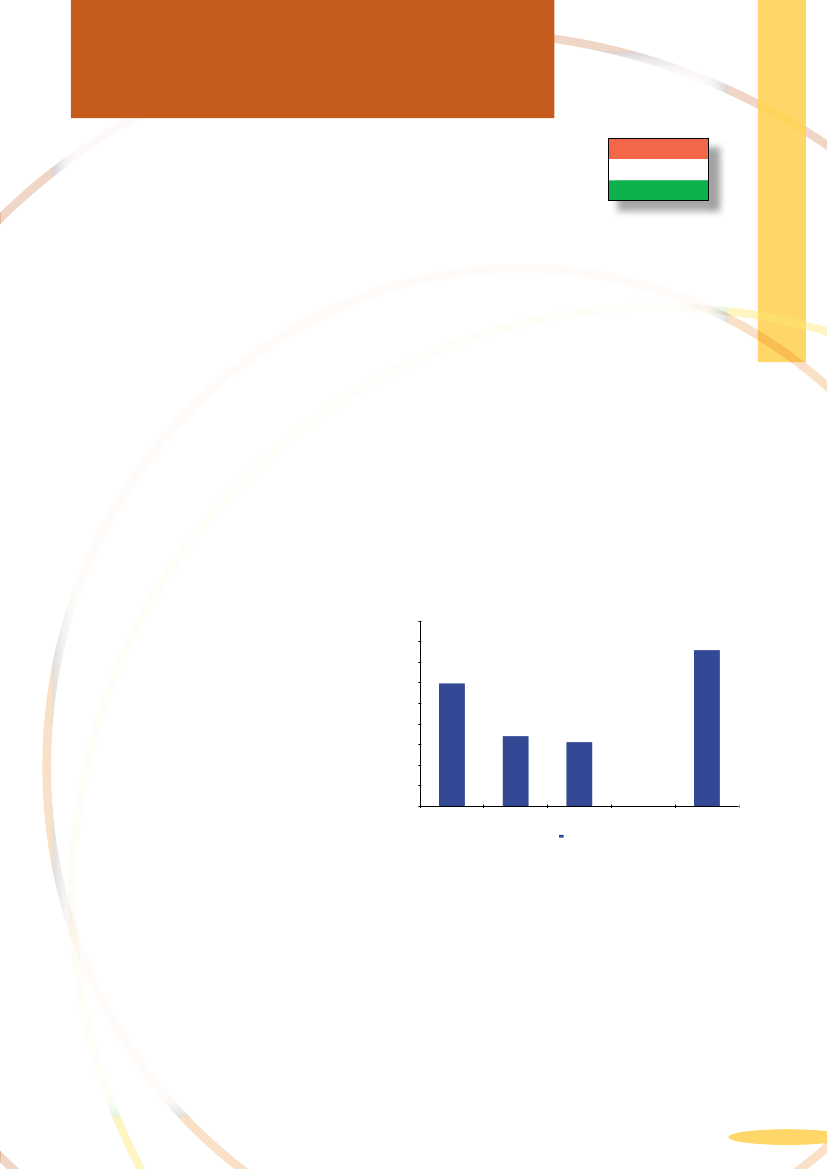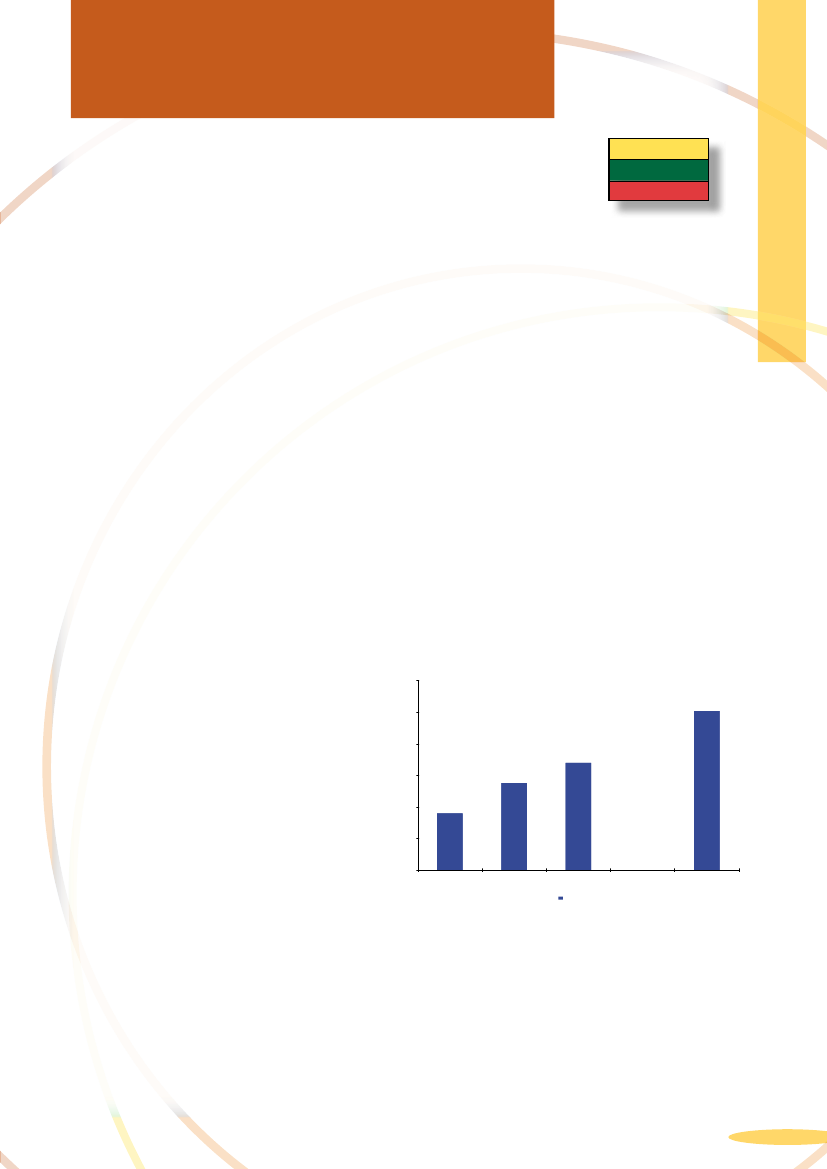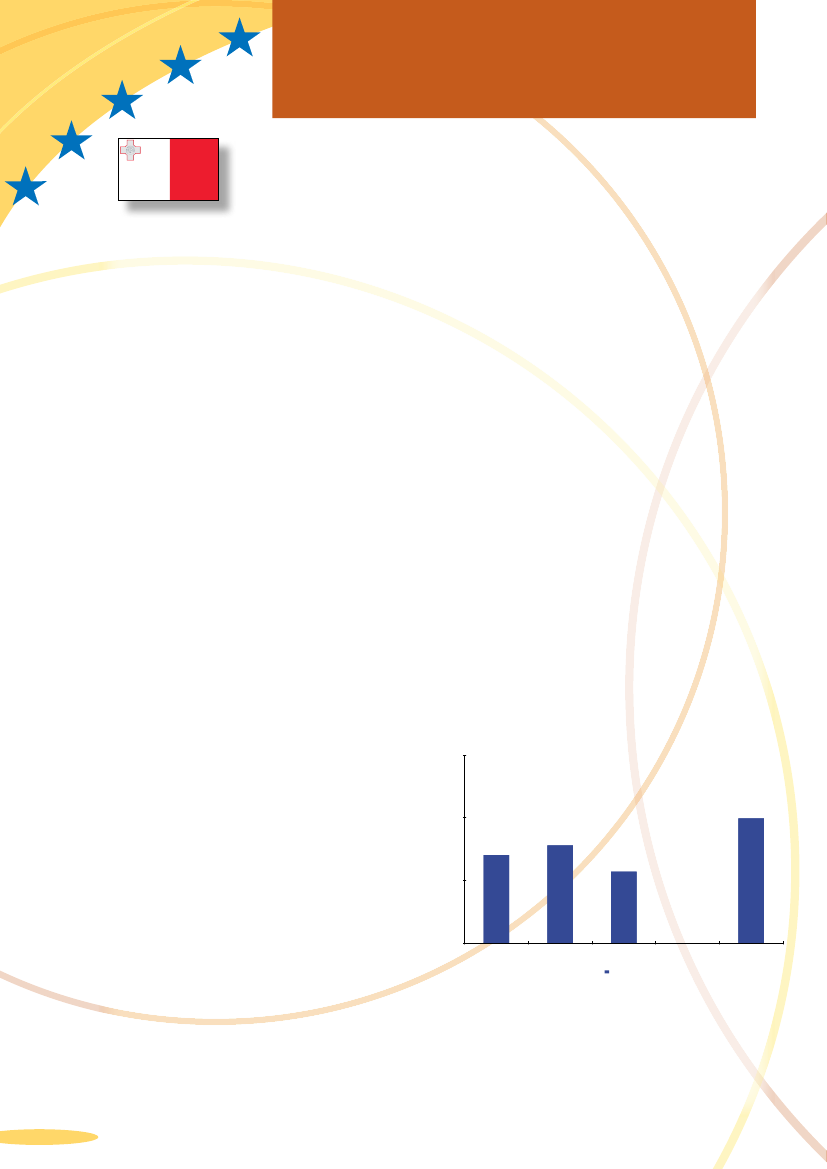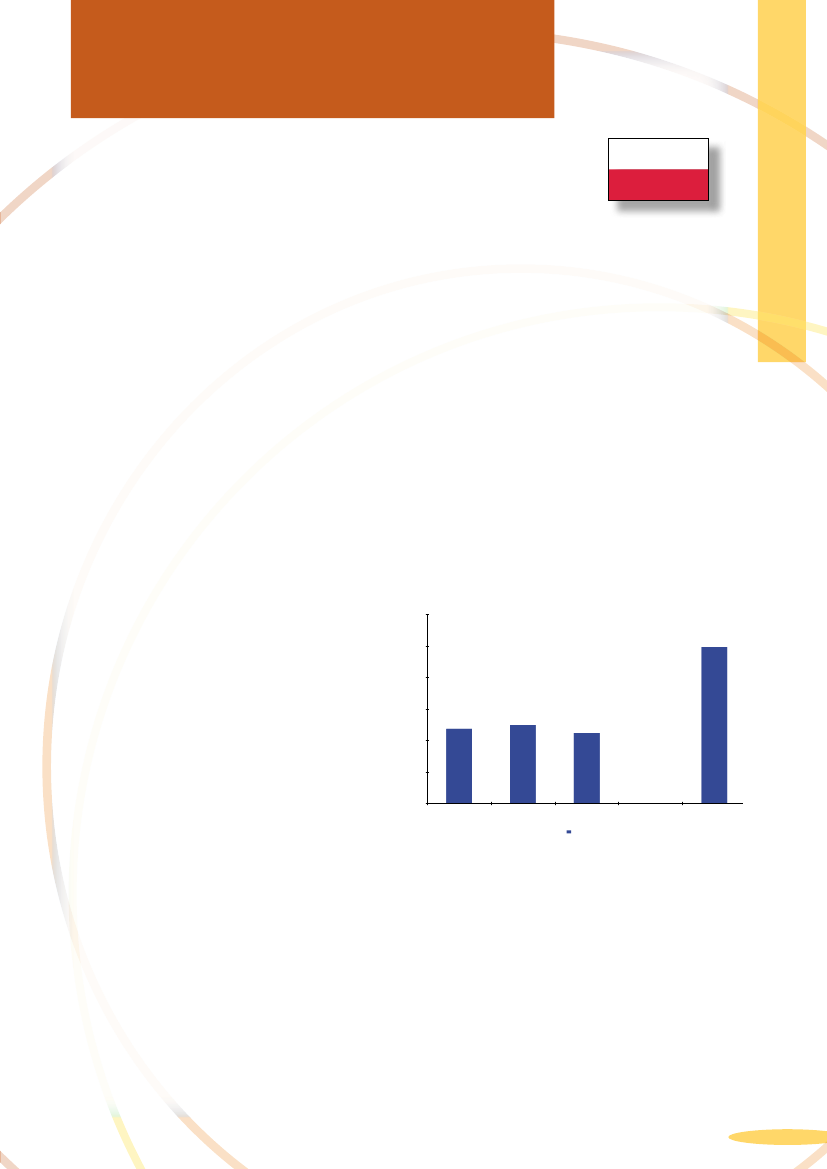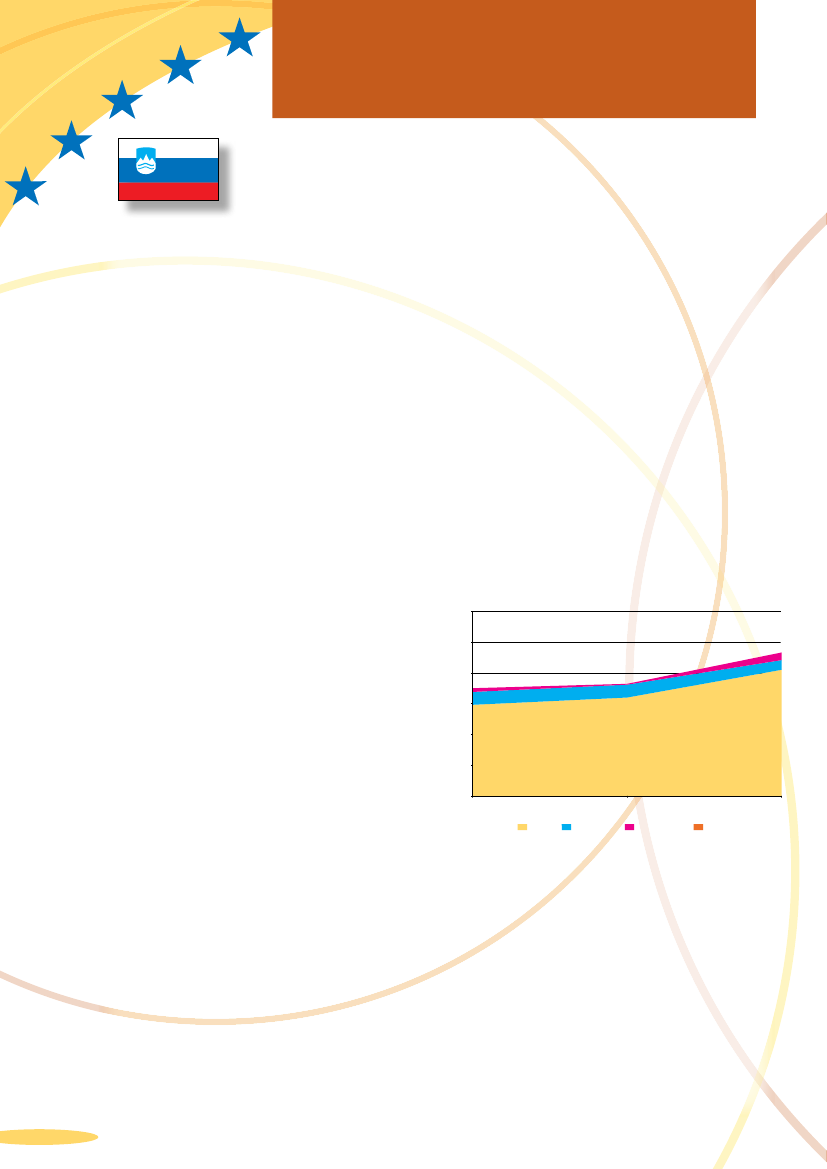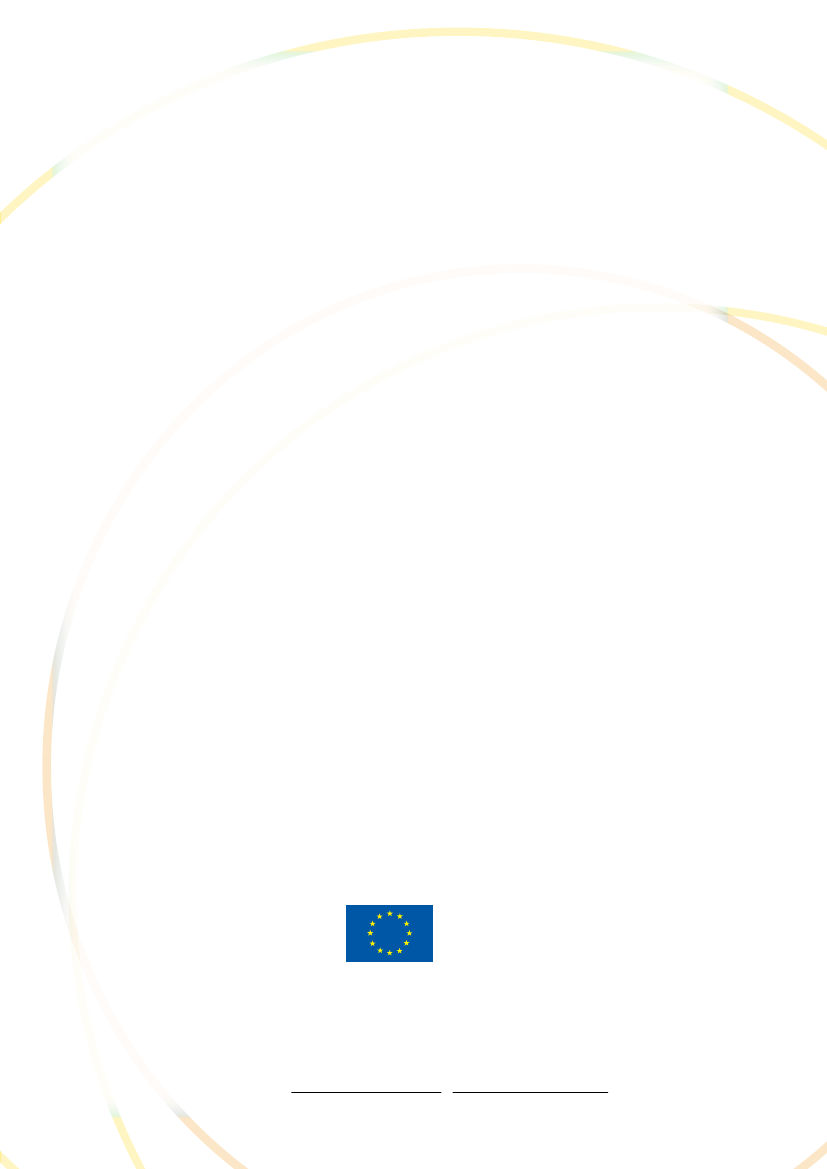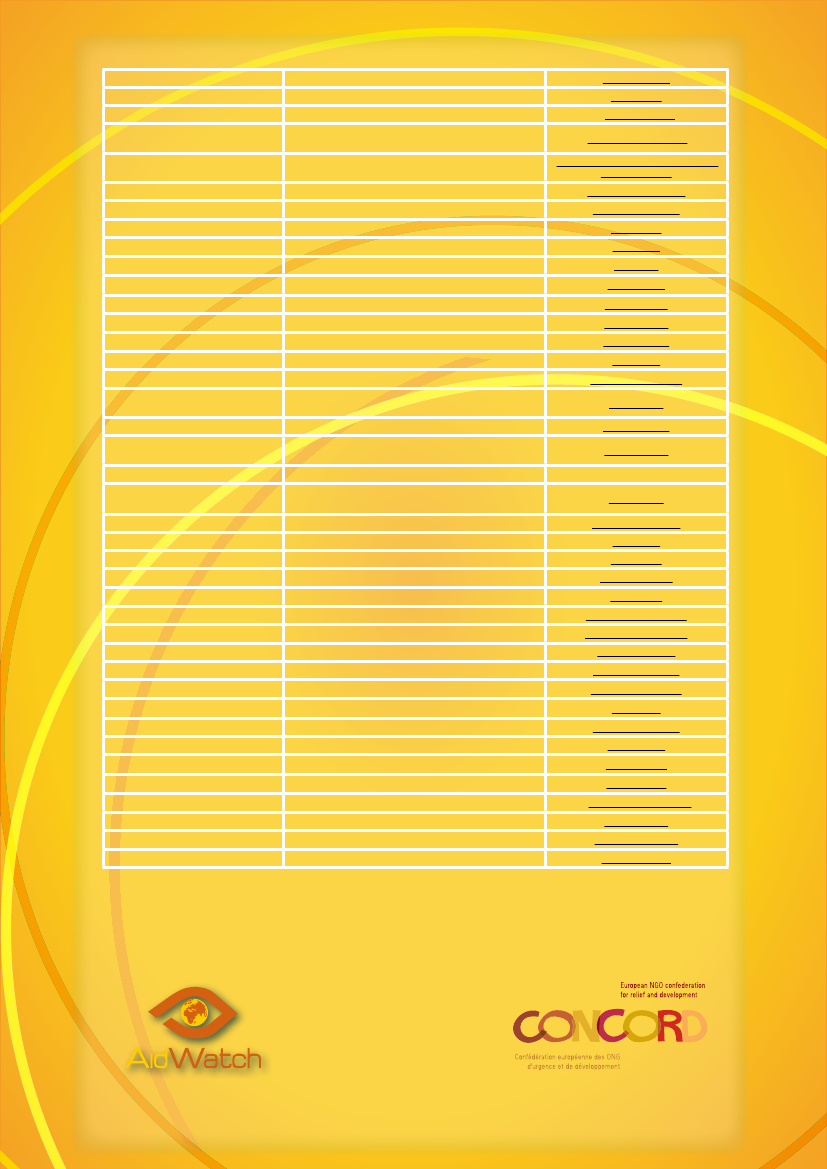Europaudvalget 2008-09
EUU Alm.del Bilag 392
Offentligt
European NGO confederation for relief and developmentConfédération européenne des ONG d’urgence et de développement
In a time of crisis, European aidhas never been more important
Lighten the load
1
•
About this report
•
Acknowledgements
This is the fourth year that development NGOs from all 27 EUcountries have come together through the AidWatch Initiative toproduce this report, under the umbrella of CONCORD, the EuropeanNGO Confederation for Relief and Development.CONCORD is the European confederation of 18 internationalnetworks and 22 national associations, representing more than 1600European development NGOs. CONCORD members are listed on theback page of the report. CONCORD is also a member of GCAP, theGlobal Call to Action against Poverty. GCAP is a worldwide campaigncommitted to influencing world leaders to live up to their promises,and to make a breakthrough on poverty: www.whiteband.orgThis report has been written by Javier Pereira and Jasmine Burnleyat CONCORD.
The production of this report has been made possible by the effortsof NGO coalitions across the EU, listed on each country page. TheAidWatch Advocacy and Report groups have also played active rolesin the production of the report. These groups are made up of thefollowing individuals representing their organisations:Ales Kranjc Kuslan, Ekvilib Institute; Aoife Black, Trócaire; BodoEllmers, EURODAD; Els Hertogen and Wiske Jult, 11.11.11; EsterAsin-Martinez and Agnès Philippart, CONCORD Secretariat; GaspardDenis, CNCD; Gideon Rabinowitz, UKAN; Hetty Kovach, Oxfam GB;Katia Herrgott, Coordination SUD; Iacopo Viciani and Luca de FraiaActionAid Italy; Luisa Antolin, WIDE; Louisa Vogiazides, Eurostep;Mario Gerada, SKOP; Michael Obrovsky, ÖEFSE; Peter Sörbom,CONCORD Sweden; Petra Krylova, Arpok; Rebecca Steel, TRIALOG;Terhi Ylikoski, KEPA; Verónica Hernández, Intermón-Oxfam.
•
European AidWatch Initiative
•
For more information
This report is part of a broader range of work being undertaken byEuropean development NGOs, to monitor and advocate on Europeanaid under the aegis of the CONCORD AidWatch Initiative. AidWatchactivities include lobbying and advocacy in Brussels and in EuropeanUnion (EU) member States, annual and policy specific seminars,capacity building for NGOs across Europe and ongoing research onEU aid.For more information on becoming involved in the AidWatch Initiative,please contact the AidWatch Coordinator: jasmine.burnley@concordeurope.org
More information available at: www.concordeurope.orgDesign and layout by: Altitude – Brussels: http://www.altitude.beThe cover has been drawn by Hamidou Zoetaba, a cartoonist fromBurkina Faso: [email protected].
CONTENTSExecutive Summary ............................................................................................................................................. 2Part I: Analysis of European aid quality and quantity ........................................................................................ 41. Aid in time of crisis ......................................................................................................................................... 4A financial tsunami: the impact on poor countries........................................................................ 4Poverty: the perennial crisis and the need for aid ......................................................................... 52. Europe’s aid commitments ............................................................................................................................. 6Getting more out of aid ................................................................................................................ 63. Aid progress in Europe: not making the grade ............................................................................................... 74. No cause for celebration: European aid inflation still a problem................................................................... 8Debt cancellation ...................................................................................................................... 10Refugee costs in Europe ........................................................................................................... 10Student costs............................................................................................................................ 11Climate change financing.......................................................................................................... 115. Aid effectiveness: unlocking the potential of aid? ....................................................................................... 11Transparency ............................................................................................................................ 12Gender ..................................................................................................................................... 13Ownership and conditionality .................................................................................................... 13Accountability of aid ................................................................................................................. 14Untying aid ............................................................................................................................... 14Technical assistance................................................................................................................. 15Predictability of spending ......................................................................................................... 16Security and migration: politically motivated spending .............................................................. 17Division of labour...................................................................................................................... 176. European NGO recommendations ................................................................................................................. 18Part II: Country Profiles ..................................................................................................................................... 19Note on methodology, data sources and acronyms ......................................................................................... 47Endnotes ............................................................................................................................................................ 48
Lighten the loadIn a time of crisis, European aid has neverbeen more important
1
Executive SummaryLast year poor people around the world endured the consequencesof the food and energy price crisis. Today, the global economiccrisis is inflicting serious damage on some of the most vulnerableeconomies in the world, and on the poorest people. In this time ofcrisis European countries should, more than ever, lighten the loadborne by developing countries.Together, European governments provided 60% of global aid flowsin 2008 and have committed to lead donor countries in their fightagainst poverty and inequality. In order to achieve this ambitious goal,European governments have promised to increase their aid levelsand improve aid quality by signing up to international commitmentssuch as the Paris Declaration. However, this report shows that theEuropean Union (EU) is failing to deliver on its pledges on aid quantityand quality, at just the time when poor families need it most.In 2008, Europe provided 0.40% of its gross national income (GNI) inaid. Although this is an increase of €4 billion (bn), in reality, a further€20bn is necessary over the next two years in order to meet itstargets. Current rises are clearly falling far short of what is needed,and according to official estimates by the European Commission,the EU will not reach its 2010 collective 0.56% of GNI target until2012. Many of the 15 old Member States (EU-15) will not hit theirindividual aid targets of 0.51% by 2010, and neither are the 12new Member States (EU-12) countries expected to achieve theirs of0.17% on time.In fact, if current trends continue, a maximum of only 10 countries willmeet their 2010 aid commitments. This means that Europe is wayoff-track on providing 0.7% of GNI in aid by 2015 - a promise madeby Europe in 2002, vital for meeting the Millennium DevelopmentGoals. Among the old member states, Austria registered the biggestdecrease, followed by a small drop from the Netherlands. In thegroup of the new member states, Bulgaria and Malta were by far theworst performers, with decreases of 27%. Hot on their heels wereEstonia, which dropped by 19%, Poland by 10%, Hungary 9%, andthe Czech Republic by 1%.Official aid figures therefore reveal that Europe will not live up to itsinternational commitments for 2010. But, these figures also concealfurther swathes of “inflated aid”. Out of the almost €50bn thatEuropean governments provided as aid in 2008, almost €5bn is debtcancellation, €2bn student costs and close to €1bn refugee costs.When these figures are discounted from the glossy official numbers,European aid for 2008 amounted to only 0.34% of collective GNI,nothing like the officially reported 0.40% and a very long distancefrom the 2010 target of 0.56%. If current trends continue unchanged,European countries will have failed to provide €39bn of promisedaid to developing countries by 2010, due to inflated aid practicesand missed official targets. This amount is more than two times thesize of Estonia's economy, and would be enough to increase by onequarter the daily income of the 380 million Africans living in absolutepoverty.Nonetheless evidence continues to demonstrate that where deliveredwell, aid saves and changes lives. In Zambia, aid from the UnitedKingdom and other donors has supported free health care in ruralareas, increasing the number of people using health facilities by50%. Aid is much more valuable when it is sustainable, long-termand characterised by genuine development motives. It is factorslike these which determine the effectiveness of aid. This year, withthe detrimental impact of the food and financial crises on the mostvulnerable, the quality of aid is even more crucial for developingcountries, and donors must deliver.Yet in contradiction with international commitments, aid continues tobe driven by donors’ own priorities, resulting in damaging in-countrypower imbalances and little developing country ownership of aidprocesses, which reduces overall levels of aid effectiveness. Manyof the core issues for aid effectiveness such as gender equality andtransparency have long been on the short-list of developing countryconcerns, but never fully addressed.This report also shows that some European countries continue todeliver aid based on their own priorities rather than those of the poor.A number of European countries such as Italy and Sweden havepronounced in favour of broadening the Organisation for EconomicCo-Operation and Development (OECD) reporting guidelines in orderto enable military and peace-keeping expenses to be counted as aid.Moreover, last year France brokered a deal in the European Councilallowing them to tie aid money to recipient countries’ co-operationon migration and repatriations. Many other European governmentssuch as Malta and Italy rushed to renegotiate their aid deals onthis basis. The use of aid as a political tool is unacceptable. Aid isabout poverty reduction and rights, not the diplomatic relations andinterests of rich governments in poor countries.Europe has proved capable of mobilising gargantuan amounts ofmoney for their banks. Over $150 billion was mobilised for NorthernRock and Dexia alone – more than double the amount of EU aid in2008. This shows that meeting the aid quantity commitments is notabout lack of resources, but about political will and prioritisation.Europe must respond to the every day crisis faced by poor peoplewith the same political commitment.History will judge Europe according to its actions now. If Europe failsto act we will be seen as having turned our back on the poorest intheir time of need, and missed the opportunity to deliver a genuineEU development legacy. But decisive action can still be taken. Europehas the unique opportunity to have a huge impact on the lives ofthe world’s poorest people, and to leave a development legacy thatturned the tide for poor families in a time of global crisis.
2
Executive Summary
The 1,600 organisations represented by CONCORD, theEuropean Confederation of Development NGOs call upon EUgovernments to demonstrate their leadership on developmentthrough:1.Meeting 2010 and 2015 European aid quantity targets withgenuine aid resources and ensuring there are no further cuts toaid budgets in the face of the financial crisis2.Agreeing binding year on year timetables which show howEuropean governments will reach aid commitments anddemonstrate with regular financial reports how they are beingimplemented3.Ending inflation of aid budgets with debt cancellation, refugeeand student costs and stopping discussions on widening thedefinition of ODA to include other items such as climate changefinancing, security or migration4.Demonstrating progress on European and international aideffectiveness targets by implementing the Accra Agenda forAction and Paris Declaration at the national level in consultationwith developing countries. European governments should alsotake forward the following specific recommendations:•Transparency: demonstrate how they will address theongoing problems with transparency of aid including:timely and accurate disclosure and dissemination ofinformation on development policies, negotiationsand procedures; and ensuring that information iseasily accessible for scrutiny by people in developingcountries. All European governments should sign upto the International Aid Transparency Initiative, anddemonstrate how they will implement its commitments•Gender: deliver on commitments to put genderequality and women’s empowerment at the centre ofdevelopment cooperation and the aid effectivenessagenda; and demonstrate how their aid programmeswill address gender equality and target women•Ownership: demonstrate how they will ensure aidis driven by the notion of democratic ownership;ensure that the voices and concerns of citizens andparliaments are central to national development plansand processes; and develop indicators for democraticownership with developing countries that go beyondmeasuring ownership through alignment with nationaldevelopment plans•Conditionality: make public all conditions attached to aid,and set out how they will phase out economic policyconditionality
•Accountability: radically improve accountability practicesby developing mutually agreed aid contracts to governaid relations between European governments anddeveloping countries; implement mutual assessmentsin all countries by 2010; and make sure that aid is beingindependently evaluated•Untying Aid: untie all aid including food aid and technicalassistance; give preference to local procurement; andimprove reporting on tied aid practices to the OECDDevelopment Assistance Committee (DAC)•Technical Assistance (TA): ensure that all TA is demand-driven and aligned with national strategies, and respectthe right of recipient countries to contract according totheir needs•Predictability: make multi-year commitments basedon clear and transparent criteria agreed with partnercountries and deliver those commitments on schedule;provide full and timely information to developingcountries on these commitments and disbursements•Politically motivated spending: ensure that no aid moniesare spent on activities which are not primarily focusedon reducing poverty, and regularly demonstrate that aidis not used as a political tool•Division of labour: demonstrate case by case howthis agenda is going to reinforce and not underminedemocratic ownership of aid5.Ensuring progress on aid commitments goes hand in hand withsystemic reform to the international financial and economicsystem by addressing flaws therein which impact so heavily onpoor countries6.Demonstrating how all European policies are coherent withdevelopment objectives, including in the crucial areas of trade,climate change, migration and food security
3
Part I: Analysis of European aid qualityPart I: Analysis of European aid qualityand quantityand quantity1. Aid in a time of crisisWe live in a world where poverty and inequality are alreadywidespread. Almost 40% of the world’s population live on lessthan US $2 a day.1In addition to this daily struggle, poor countrieshave been bearing the brunt of the food and fuel crises that haveleft 100 million more people hungry around the world.2They nowface a financial tsunami, which will have catastrophic human costsand will hit the most vulnerable in our society hardest, especiallydeveloping countries and their citizens. The World Bank estimatesthat in 2009 alone, the financial crisis could result in the deathsof between 200,000 - 400,000 more children below five, and if itcontinues an additional 2.8 million infant deaths by 2015.3Thoseleast responsible for the crisis will be the ones who will pay thehighest price, in many cases with their lives.Europe’s response to this crisis needs to address not just thesymptoms, but also the causes. This means building a more equitableand sustainable economic system that will deliver for all. But withexternal resources available to developing countries in free fall, itis clear that aid is more important than ever. Trade with developingcountries is collapsing; foreign direct investment and private financialflows are drying up, and much relied upon remittances are in decline.Aid flows must not go the same way. The last global recession in1993 saw a lost decade of development – with aid levels falling bymore than a quarter and not returning to their existing levels untilmore than ten years later.iEU aid levels matter. European governments currently provide overhalf of all global aid flows and are expected to contribute around60% of the aid needed between 2006 and 2010 in order tomeet global aid pledges.4They have proved capable of mobilisinggargantuan amounts of money for their banks. This shows meetingOfficial Development Assistance (ODA) commitments is not aboutlack of resources but about political will and prioritisation. Aid levelsare now under pressure again as global economic growth contractsand governments across Europe begin to cut their developmentbudgets: since December last year, Italy, Ireland and Estonia have allannounced cuts to their 2009 aid budgets, and Latvia has suspended100% of its development activities.History will judge Europe according to its actions now. If the EuropeanUnion (EU) fails to act we will be seen as having turned our backon the poorest in their time of need, and missed the opportunity todeliver a genuine EU development legacy.i
• A financial tsunami:the impact on poor countriesIn recent weeks a host of voices have sought to alert the world thatthe global economic crisis is inflicting serious damage on some ofthe most vulnerable economies in the world. Economic forecastsfrom the International Monetary Fund (IMF) for growth in developingcountries for 2009 have been revised sharply downwards, and theWorld Bank predicts that developing countries face a financing gapof US $270-US $700 billion as a result of the crisis.5One of the first impacts on developing countries has been thecollapse in commodity prices – on which much of their economicactivity depends. In recent months this has hit jobs hard: SierraLeone has sent home 90% of its diamond workers6and in Zambia aquarter of copper mining jobs have been lost.7Beyond this, world trade is slowing down and developing countrieswill have to face a decrease in overall export revenues, one of theirmain income sources. Foreign Direct Investment (FDI) in developingcountries, so dependent on the economic outlook of the North, hasdecreased by around 20% in 2008 and according to the UnitedNations (UN), “a further decrease in FDI flows can be expected in2009”.8Box 1 :The crisis is taking its tollin developing countries“I’ve two children aged 9 & 6 years. (Three years ago) I startedworking in the Katunayake Free Trade Zone in a gem-cuttingfactory. (…) Recently, the factory said that they were runningat a loss and retrenched 150 workers and I was also includedin that lot. (…) Now I’m 35 years of age, and I’m too old to joinanother factory.” Lalitha, 35, worker in a gem factory, free tradezone, Sri Lanka.“We’ve laid off all of our day labourers (…). Overall employmentis down by more than 80%. There are empty houses around thetown now. Everyone has gone back to the villages to farm, butit’s impossible to make a living from farming. There’s no creditto enable us to grow enough to have a decent business.” ChiefShaka “Mugabe” Sandi, chairman of the Sierra Leone IndigenousMiners’ Movement.Source: Oxfam International, March 09
The 1990 to 1993 global recession saw a far deeper and more sustained fall in aid levels. Aid fell by almost a quarter in real terms over a five-year period from 1993 to 1998 from US $59.4 billion to US 45.7 billion.Aid levels did not return to 1992 levels until more than a decade later in 2003.
4
Aid levels and quality
The impact does not stop there. As the crisis settles in the North,the banks restrain lending and private capital flows dry up. Privatecapital flows to emerging economies are expected to drop toUS $165bn in 2009. Many developing country economies are alsoheavily dependent on remittances – money sent back by workers totheir families. In Tajikistan remittances make up 45% of the country’sGross Domestic Product (GDP), in Eritrea 21% and in Senegal 8.2%.Due to the financial crisis, such remittances are expected to falldramatically: by 18%, 31% and 34% in these countries respectively,and this is just the tip of the ice-berg.9In the face of these effects, poor countries have few real optionsavailable to them. Developing economies are not backed by sufficientreserves to cope with times of trouble so they can’t rescue their owneconomies in the same ways that European governments can. As ofthe 18th of February, advanced economies had pledged to supportthe financial sector with up to 43% of their GDP.10This is over 100times the average European ODA levels for 2008 (0.40%).European Member States, as the major club of donors, should takethe lead in tackling the diverse effects of these crises in developingcountries, and start by delivering on aid quantity and quality. Now,more than ever, developed countries must live up to their promisesto the developing world.
Box 2 :Why aid matters: Education in GhanaAlmost half of Ghana’s population lives on less than US $1 a day,and until recently, only 62% of children of primary school agewere in school. However the Government of Ghana along withhelp from rich countries is taking action.In 2003 the Government of Ghana announced that it wouldabolish all primary school fees and provide a small grant to everyschool for each pupil to help cover the costs and encourage morechildren to go to school. The Ghanaian government dedicatedover one fifth of its national budget to education. However, asdomestic resources alone were not enough, the plan wassupported by much needed donor government aid.What has been the impact? Within the first year, the number ofprimary school aged children in education increased from 62to 69 per cent and over two academic years, 1.2 million morechildren were able to go to school in Ghana. Enrolment of girlsincreased more than that of boys after stagnating for the twoprevious years, which is vital as evidence shows that girls whoare educated are less likely to contract AIDS and earn moremoney in employment. The same experience has been repeatedwith great success in other countries that have removed schoolfees and made education free for all with the help of foreign aid.Oxfam International, case study, October 2008Such cases of success only go to show just how high the stakes are.Without much needed aid resources, stories like this one in Ghanawill cease to be told, and the good work done so far faces the riskof being reversed.Examples like this also show that aid works best when developingcountries can decide where to invest the critical aid injections theyreceive from foreign donors.Aid flows are small in comparison with other financial flows todeveloping countries, but this makes them no less vital to peoples’lives, given their focus on many of the poorest. As governmentsacross Europe announce future aid cuts on top of weak progressso far, one thing remains clear: the need for aid has never beengreater.
• Poverty:the perennial crisis and the need for aidThe impact of this crisis clearly shows that aid is more critical thanever. Evidence continues to demonstrate that where delivered well,aid has been crucial to improvements in the living conditions of poorpeople in many developing countries.Since governments agreed to meet the Millennium DevelopmentGoals (MDGs) in 2015, progress has been recorded on many fronts,showing just how important a role aid can play. In Zambia, the UKand other donors have supported free health care in rural areas,increasing the number of people using health facilities by 50%. Thescheme is also providing anti-retroviral treatment to almost 150,000people, a tenfold increase from 2003 figures.11At a global level, thenumber of children out of school has decreased from 103 million in1999 to 73 million in 2006.12Aid has played an important part in these achievements and yet,despite these successes, progress on the MDGs does remain fragile.Last year, the number of people suffering from extreme hungerincreased for the first time in two decades to the tune of 100 millionpeople (an increase of well over 10%).13People are also falling backinto absolute poverty by the millions.14With trends like this, Europeangovernments cannot afford to back down from their developmentpromises.
5
2. Europe’s aid commitmentsIn October 1970, members of the United Nations General Assemblycommitted to increase their Official Development Assistance (ODA)to 0.7% of their Gross National Income (GNI)ii. 39 years later mostcountries are still failing to honour this pledge.It was not until the signing of the 2002 Monterrey Consensus thatthe European Union (EU) as a block adopted a set of binding commontargets. In 2005, the EU Member States agreed to set interim targetsfor progress towards the 0.7% target, committing by 2010, to reach0.51% of GNI in the case of old Member States, and 0.17% in thecase of the new Member States. Other more progressive Europeandonors have added and to some extent met, more ambitious nationaltargets (see Table 1). The whole of the EU also committed to reach0.56% of GNI in ODA by 2010.committed to place democratic ownership at the heart of effectiveaid. Aid which is fully owned by the people it is intended to reach,results in better development choices and increased effectiveness.In the words of the President of the World Bank himself, “Whetheraid works can help determine whether the future is one of hopeor privation”. The consequences of getting aid right – or getting itwrong – are very real.”16
Box 3 :What governments agreed to in AccraAt the 2008 third High Level Forum on Aid Effectiveness, wheredonors met to advance on implementing the Paris Declaration, itwas revealed that progress across the board had been minimal.Where improvements had been made, this was largely on areassuch as technical assistance and untying aid where targets anddefinitions were unambitious or vague, and reporting practicespoor. Recognising the significant progress still to be made, donorsagreed an Accra Agenda for Action, setting out the areas wherethey intended to put their efforts between now, and 2010, thedeadline for meeting the Paris Declaration commitments. Someprogress was made, and donors agreed four commitments, forimmediate implementation. Apart from this, donors failed to settleon sufficiently specific or time-bound targets, which makes holdingthem accountable for progress difficult.Immediate-to-implement commitments agreed in the AccraAgenda for ActionAlignment:Donors will immediately start working on and sharing transparentplans for undertaking the Paris commitments on using countrysystems in all forms of development assistance. (…) Paragraph15dConditionality:Beginning now, donors and developing countries will regularly makepublic all conditions linked to disbursements. Paragraph 25bPredictability:Beginning now, donors will provide full and timely information onannual commitments and actual disbursements (…).Paragraph26bBeginning now, donors will provide developing countries with regularand timely information on their rolling three-to-five year expenditureand / or implementation plans, (…). Paragraph 26cUnfortunately, progress since these immediate commitments wereagreed has been weak, and it seems that until now, few governmentshave any plans on paper for making these promises happen.Following Accra, the EU set out its own top level priorities on theAid Effectiveness agenda: division of labour; country ownership-useof country systems; conditionality; predictability; untying;. Whilstthe focus on these priorities – some of them fundamental aspectsof the Aid Effectiveness agenda – is welcome, without havingimplementation plans for taking these priorities forward, their valueremains highly questionable.
Table 1. EU ODA quantity commitmentsTarget(ODA as %of GNI)EU collective targetEU – 150.56%0.51%0.7%0.17%0.33%0.7%0.8%0.7%1%0.8%0.7%1%0.7%When2010201020152010201520102010201220102010201220062013
EU – 12
Countries with more ambitious targetsBelgiumDenmarkIrelandLuxembourgNetherlandsSpainSwedenUK
Countries which have lowered their commitmentsEstoniaGreeceLatvia0.1%0.35%0.1%201020102010
• Getting more out of aidDonors are realising that when aid is imposed by external actors,it becomes less effective. Recognising that “aid effectiveness mustincrease significantly”, donor governments, including the EU, signedthe Paris Declaration on Aid Effectiveness in 2005, committingto “respect partner country leadership and help strengthen theircapacity to exercise it”.15By agreeing to this, donors effectivelyiiiii
The original commitment says Gross National Product (GNP), but the WB substituted this concept for GNI in 2001.The Paris Declaration is an agreement led by the Organisation for Economic Co-operation and Development (OECD).
6
Aid levels and quality
3. Aid progress in Europe:not making the gradeThe European Union (EU) is the world’s most important donor,providing over half of global aid flows. 2010 will mark an importantaid milestone for the EU as the world will scrutinise its performanceon moving towards the 2010 target for increasing its aid, to 0.56%of overall EU GNI.Sadly, the 2008 official aid figures suggest that Europe is set todisappoint. Last year, the EU provided 0.40% of its GNI in ODA.Although this is an increase of €4 billion (bn) over 2007, in realityan increase of a further €20bn is needed over the next two yearsin order for the EU to meet its aid targets. Current rises are clearlyfalling far short of what is needed, and according to official estimatesof the European Commission, the 15 old Member States (EU-15)will not reach its collective 0.56% target for 2010 until 2012. The12 new Member States (EU-12) countries are also not expected toachieve their common target of 0.17% on time.
10,930,980,810,8
Figure 1: EU-15 2008 Official aid figures0,910,92
0,60,550,580,47
0,810,80
0,8
2
% GNI
8
0,380,3
0,3
0,3
0,3
7
6
70,3
0,40,20nrgrkand
3
0,43
0,43
0,43
0,4
0,500,42
0,3
9
9
0,2
2
0,2
7
00,20,16
m
SpUnited ainKingdomAustriaFranceGermanyPortugalGreece
s
Finland
therland
Swede
mbou
nma
Irel
Luxe
De
Ne
Be
lgiu
2007 ODA in % GNI
Target 2010: 0.51% GNI0,40,30,20,17
2008 ODA in % GNITarget 2015: 0.7% GNI
Figure 2: EU-12 2008 Official aid figures
% GNI
0,110,11
0,11
0,11
0,11
90,10
0,0
0,0
0,1
9
0
0,10,0
0,1
0,1
2
3
0,1
4
5
0,1
0,1
2
8
0,0
0,0
8
7
7
0,0
0,0
0,0
7
6
6
0,0
0,0
0,0
6
Cyprus
SloveniaLithuaniaCzechRepublic
Malta
lic
nia
nd
ary
nia
Latvia
ub
Pola
Esto
Hung
Rep
ma
2007 ODA in % GNITarget 2010: 0.17% GNISource: OECD online database, OECD (2009) and European Commission (2009).
Slovak
2008 ODA in % GNITarget 2015: 0.33% GNI
Ro
Bu
lga
ria
0,0
4
Ita
ly
0,1
90,20
7
Europe has committed to lead donor countries in the fight againstpoverty, but it is failing to maintain support just when poor countriesneed it the most. The financial crisis will be felt with greater intensity,and for longer in developing countries. Instead of stepping up theirefforts, European countries are starting to walk away from the world’spoor. Even if we assume that EU donors will meet their aid targets,the impact of the economic downturn on European economies willreduce the amount of aid they deliver by €12bn between 2008 and2010. This is because EU targets are expressed as a proportion ofnational income, and therefore the real volume of aid will diminish inline with the shrinking size of European economies. In addition, withrecent 2009 aid cuts announced by several European donors, theimpact of the crisis on aid is certain to hit on a number of differentfronts.2008 saw ten out of the twenty-seven European countries eitherdecrease or fail to raise their aid levels in relation to GNI. Amongst theEU-15, Austria recorded the biggest decrease. However, even withinother EU-15 countries progress towards achieving the 0.51% GNIwas negligible for many. Greece has already thrown in the towel andlowered its target for 2010 to 0.35% GNI. If current trends continue,Greece will fail to meet even this drastically reduced commitment.Germany, France, Italy, Portugal and Belgium are other members ofthe club showing little hope of hitting their targets.
Half of the EU-12 decreased their aid levels and a further two didnot register any improvements on last year’s figures. Amongstthe new Member States, Bulgaria and Malta are by far the worstperformers, with decreases of 27%. Hot on their heels were Estonia,which dropped by 19%, Poland by 10%, Hungary 9%, and the CzechRepublic by 1%. Looking at the individual commitments, the pictureis even darker. Only three countries in the EU-12: Cyprus, Sloveniaand Lithuania, are on track to meet their targets.As in previous years, progress has been seen under the usual (good)suspects - Denmark, Sweden and Luxembourg. The Netherlandsalso provide over 0.7% in aid, although they show a small drop fromthe 2007 levels. But aside from these consistently good performers,only Spain, Finland and the UK are showing real commitment bysteadily increasing their aid figures.This year’s official analysis shows that EU aid quantity is simply notincreasing at a sufficient rate to meet the targets committed to inthe European Consensus on Development. Only six years away fromthe MDGs, this lack of commitment on aid figures signals furtherconcerns that these monumental objectives will not be met. We havenow reached a crossroads on aid and European countries must putin place binding aid delivery timetables to demonstrate that they areserious about their aid promises.
4. No cause for celebration:European aid inflation still a problemOfficial aid figures reveal that many European countries will notmeet their commitments for 2010. But these figures also concealfurther swathes of “inflated aid”. Out of the almost €50bn thatEuropean governments provided as aid in 2008, almost €5bn is debtcancellation, €2bn student costs and close to €1bn refugee costs.When these figures are discounted from the glossy official numbers,European ODA amounts to only 0.34% of collective GNI, nothinglike the officially reported 0.40% and a very long distance from the2010 target of 0.56%.This is also a tiny increase against the 0.33%level of genuine aid provided in 2007. Current aid levels meanthat European countries would need to dramatically increase theirgenuine aid flows in the next two years to meet their aid promises.Though difficult, amounts pumped into bank bail-outs this year showjust how much money governments can mobilise if they feel thecause is worth it, and just how feasible it would be to meet the aidtargets governments set for themselves back in 2002.Debt cancellation figures have decreased by half a billion as expectedsince the explosion of spending on debt relief in 2005 and 2006.Conversely, student and refugee costs have increased by 4% and11% respectively, showing that most European donors have decidednot to follow UK and Luxembourg and end the practice of countingstudent and refugee costs as aid.If the countries are ranked again according to their genuine aid, wecan see that Sweden, Luxembourg, the Netherlands and Denmark’said levels continue to surpass the 0.7% mark. But overall, a verydifferent picture is painted in many countries when we carry out ananalysis of “genuine” aid going direct to the poor. With aid inflationtaken into account, Austria is by far the worst performer. Its share ofinflated aid is even larger than its genuine aid, and represents 52%of its total ODA. Other countries with large chunks of inflated aidare the Slovak Republic (33%), Germany (26%), France (23%), Italy(21%), Czech Republic (18%), Greece (16%), Slovenia (13%) andBelgium (10%).
8
Aid levels and quality
Table 2. Snapshot of genuine and inflated aidCountryGenuine aid% GNI0.92%0.90%0.78%0.75%0.58%0.43%0.42%0.41%0.41%0.30%0.28%0.24%0.20%0.17%0.16%0.13%0.12%0.09%0.07%0.06%0.06%Total ODA (€m)Inflated aid (€m)Genuine aid(€m)28330261841450791414867774339746558237123386557401244240.8441194413.688Will they meettheir 2010 targetswithout inflation?LikelyUnlikelyUnlikelyYesUnlikelyNoYesLikelyLikelyNoNoUnlikelyNoNoNoLikelyNoUnlikelyNoNoNo
LuxembourgSwedenDenmarkthe NetherlandsIrelandBelgiumFinlandSpainUnited KingdomFranceGermanyPortugalAustriaGreeceItalyLithuaniaSloveniaCzech RepublicSlovak RepublicLatviaRomania
28332861941484891816517904635791975969644425116548030814151146651494
02601003414165132964541773252139608796390.2*727210.4*6*
Countries where reporting practices limit inflated aid analysisGenuine aid % GNICyprusMaltaEstoniaHungaryPolandBulgaria0.17%0.11%0.09%0.07%0.08%0.04%Total ODA (€m)276147226413LikelyUnlikelyUnlikelyUnlikelyNoNo
*Actual figures could be higherSource: CONCORD calculations based on OECD DAC (2009) and EC (2009)
9
Figure 3: Trends of EU 15 genuine aid. Will they meet their 2010 targets?
70,00060,00050,000€ m (2006 constant)40,00030,00020,00010,000020062007Debt cancellation2008Refugee costs2009Student costsReal aid20102010 target€64bn*Trend required€39bn missingCurrent trend
*This target of €64bn takes into account the OECD’s calculations revising down aid volumes as a consequence of the impact of the financial crisis on European economies.Source: CONCORD calculations based on OECD (2009), EC (2009), OECD Creditor Reporting System and Eurostats
If current trends continue unchanged, European countries will havefailed to provide €39bn of promised aid to developing countries by2010, due to inflated aid practices and missed official targets. Thisamount is more than two times the size of Estonia’s economy, andwould be enough to increase by one quarter the daily income of the380 million Africans living in absolute poverty.European NGOs are extremely concerned about new non-aid expensesbeing reported as ODA. Denmark is already reporting climate finance asaid and, looking to the future, will not be the only one. Other countriessuch as Malta and Lithuania are very likely to even now be reporting thecosts of reception centres for migrants. Many European countries arealso considering reporting peace-keeping and police missions as partof their development aid, despite the total absence of any guaranteethat this money will go anywhere near poverty alleviating activities. In2007, Spain funded police missions in Senegal and Mauritania withaid money, and the Slovak Republic recently attempted to report somecosts of North Atlantic Treaty Organisation (NATO) security missions asaid meant for the poor.This analysis of inflated aid reveals that Europe is not doing enoughto honour its promises. EU governments continue to artificially boosttheir aid figures, and instead of phasing out this practice, are nowpushing for a “widened ODA agenda”. Climate finance features at thetop of this agenda together with security and migration spending. IfEuropean countries pad out their aid figures like this, they risk loosingall their credibility, and Europe’s claim to be a leader on developmentwill be null and void.•Debt cancellationLast year almost €5bn was reported by European donors in debtcancellations. Whilst this amount is lower than previous years, itstill accounts for a whopping 9% of European aid flows. EuropeanNGOs welcome debt cancellation to developing countries, but believethat it should not be counted as official aid. Crucially, reporting debt
cancellation together with aid flows misleads the public because itmoves donors closer to their targets without ever increasing theamounts of aid they deliver to poor countries.When donors provide debt relief, they can count not only the amount ofthe debt forgiven, but also the interest they are owed now, and in thefuture. This allows donors to effortlessly note down numbers on theiraid balance sheets and appear more generous than they really are.In the Monterrey consensus, European countries made a commitmentthat debt relief would not divert money from the aid made availableto developing countries17. Despite this commitment, debt cancellationonce again accounted for a significant share of EU aid flows, withnotable examples being Austria (43%), the Slovak Republic (26%), Italy(20%), Germany (19%) and France (8%).In addition, donors can report the cancellation of export creditdebts as part of their ODA spending. Export credits are provided byspecialised export credit agencies in developed countries to backnational companies who want to export to so-called riskier developingcountries. When local companies in developing countries fail to payup, the exporter in the developed country claims back its costs from itsnational export credit agency. The export credit agency then pursuesthe government of the developing country for the debt, and the amountis added to the national public debt of the developing nation. Whenthese debts are cancelled, they are counted as ODA even though theoriginal purpose of the investment may never have been developmentrelated.
• Refugee costs in EuropeSpending on refugee cost in donor countries inflates aid figuresbecause it does not reflect a real transfer of resources to developingcountries. The money stays in the donor country and is in no waydirectly connected with any development or poverty reduction goal.
10
Aid levels and quality
Refugee costs represent a significant share of aid flows in the CzechRepublic (9%), Sweden (8%), Slovenia (7%), Belgium (4%), Greece(4%) and France (3%). However, European NGOs are concerned thatcurrently reported levels of refugee costs counted as aid may notreflect the real extent of the problem. There is a growing tendencyamongst European governments to politicize ODA spending, especiallyaround migration issues and immigrant arrivals in many Mediterraneancountries. Some European governments are also likely to be reportingpart of their refugee costs within other OECD Development AssistanceCommittee (DAC) categories. Spain, for example reported as “housingpolicy and administration management” a project related to migrants’housing. Moreover, there are clear gaps on donor country reportingand detailed breakdowns of spending on refugees are rarely available.This problem is especially relevant in some of the new Member States,such as Malta and the Slovak Republic, where the OECD DAC reportingguidelines are not yet fully implemented and local NGOs believe thatnot only refugee costs, but also money spent on migrant detentioncentres and repatriations may be being reported as ODA.
According to the latest figures and information from the nationalplatforms, we estimate that student costs reported as aid, increasedby 4% in 2008, reaching €1.9bn or over 4% of total European ODA.This figure is significantly higher in some countries such as France(12%), Greece (12%), Portugal (9%), Germany (7%) and Austria (6%).There have already been some discussions within the OECD onchanging the ODA reporting in order to avoid inflation in this area byending the practice of counting student costs.18European NGOs arein favour of this and strongly encourage the OECD to move forwardwith this initiative.
• Climate change financingClimate change is universally recognized as a global threat which will havedire consequences for the environment and the international economy.19,20It is expected to have a greater impact in developing countries, many ofwhich lie in more vulnerable areas and / or lack sufficient resources totake effective actions to alleviate the consequences of climate change.Developed countries must take action to support developing countries todeal with these damaging impacts on the basis of their capabilities, andtheir past and present responsibility for contributing to climate change.Given the current inability of many European Countries to fulfill their aidtargets, there is great concern that not only will European governmentsfail to effectively meet their climate change commitments, but that theywill also take the opportunity of using critical climate change finance tofill out their meagre aid budgets.The EC has recognized the importance of increasing support todeveloping countries during the financial crisis and made climate changeadaptation a priority sector. On the other hand, it has failed to commit toprotecting already weak development aid budgets, instead announcingthat “Creative means should be however sought to make sure thesecommitments (ODA) are respected (innovative sources of financing, e.g.Global Climate Financing Mechanism).”21It is crucial that climate changefinancing is additional to existing ODA commitments. This year’s highprofile discussions on climate change in the lead up to the UN meetingin Copenhagen, will be a test to see if donors are serious about tacklingthe challenges of poverty reduction and climate change.
• Student costsThe role of developing individuals’ skills in creating wealth, reducingpoverty and empowering people to access their rights has long beenrecognised by aid experts and local civil society actors alike. But formany European governments, the line between spending on creationof skills in developing countries, and subsidising higher educationinstitutions in their own countries has been blurred. Many donorcountries report as development assistance the money spent oneducating foreign students within their own borders.ivSome benefitsmay be gleaned from this process, but there is nowhere any guaranteethat this money ever contributes to poverty reduction in developingcountries. It also means that in reality, the government does no morethan make a direct transfer of funds from one ministry to another.By funding foreign students, donors can also fuel the “brain drain”phenomenon, by perpetuating policies which encourage skilledmigrants to stay and use their valuable skills in rich countries,rather than their own. This is rarely combined with fair and equitablemigration policies which allow for economic migrants with or withoutsought-after skills to enter European borders.
5. Aid Effectiveness:unlocking the potential of aid?Historical experience has shown that aid can make a clear andvaluable difference to people’s lives, when it is sustainable, long-term and characterised by genuine development motives. It is factorslike these which determine the effectiveness of aid. Aid effectivenessalso gives better value for money. The European Commission itself haspointed out that the costs of not applying fully the aid effectivenessagenda amount to a massive €5 to €7 billion per year.22Yet in contradiction with international commitments, aid continuesto be driven by donors’ own priorities, resulting in damaging in-country power imbalances and little developing country ownershipiv
of aid processes, which reduces overall levels of aid effectiveness.Many of the core issues for aid effectiveness such as gender equalityand transparency have long been on the short-list of developingcountry concerns, but never fully addressed. Gender equality is abasic human right central to aid effectiveness which has not, todate, been given a sufficient level of priority by development actors.Today, there are many more illiterate women than men in the leastdeveloped countries and a woman’s risk of dying from treatableor preventable complications of pregnancy and childbirth over thecourse of her lifetime in sub-Saharan Africa is 1 in 22, comparedto 1 in 7,300 in the developed regions.23-24, Transparency, another
The costs reportable as ODA are the percentage of the tuitions costs (official expenditure on education) that corresponds to the percentage of the student body that is accounted for by students from developingcountries.
11
Table 3. Aid transparency in the EUCountryBelgiumDenmarkEstoniaIrelandNetherlandsSwedenUnited KingdomAustriaCyprusCzech RepublicFinlandFranceGermanyLithuaniaLuxembourgPolandPortugalSpainItalyGreeceLatviaBulgariaSlovak RepublicSlovenia
Overall transparency*GoodGoodGoodGoodGoodGoodGoodAverageAverageAverageAverageAverageAverageAverageAverageAverageAverageAveragePoorPoorPoorVery poorVery poorVery poor
What are the main problems?Policy conditions for disbursements not disclosedNo disclosure of policy conditions, insufficient timeframes for consultation on availableinformationNo evaluation mechanisms in placeData needs to be made more easily accessible to partner countriesStill insufficient levels of detail in information availableInformation provided to the OECD DAC is not easily availableSome information is not systematically available and policy conditions are not yet disclosedInformation is not released in timely manner and key documents such as aid policies orfinancial agreements are not availableNot enough information on aid assessments, procurement procedures and conditionsNo information released ex ante and no evaluation reports availableImportant decisions related to development policy have been made by the governmentwithout proper consultationData presented in a way which is incomparable with other sources, no disclosure of policyconditionsNot enough information available on aid flows, procurement procedures and aid evaluationsLittle detailed information available, no information provided ex anteNo formal channels for requesting and disclosing information, information on use of policyconditions unavailableNot enough and insufficiently detailed informationInformation on aid is not centralised and detailed information can only be obtained fromindividual ministries and departmentsInformation provided to the public is not detailed enough and is only available in Spanishmaking accessibility for aid recipients an issuePoor national information gathering and not enough information availableOverall access to information poor, and not available in a timely and regular mannerTransparency is poor and needs to be improved, especially with regards to bilateral aidInformation is very poor and there are no mechanisms for automatic disclosureInformation is very poor and there are no mechanisms for automatic disclosureInformation is very poor and there are no mechanisms for automatic disclosure
*Based on an index compiled through questionnaires completed by NGOs. See note on methodology for further information. No data is available for Hungary, Malta and Romania
issue on which effective and accountable aid is founded, has stillnot been effectively addressed by donor countries. Despite repeatedcalls from development actors, donor countries remain reluctant toopen up their aid budgets to wider public scrutiny, thereby reducingthe scope for mutual accountability and democratic participation inaid processes.Some international commitments have tried to address these andmany other aid quality issues. The Paris Declaration was a boldattempt, but it has fallen short of being a comprehensive solution.This year, with the detrimental impact of the food and financial criseson the most vulnerable in developing countries, the quality of aid iseven more crucial, and donors must deliver.
aid transparency and accountable donor-recipient governmentrelations. But beyond this snapshot of aid relations, there is a biggerpicture. Good aid transparency is critical for improving democraticaccountability mechanisms at the country level through enablingcitizens and parliaments in donor and recipient countries to fightcorruption, ensure aid is spent on its intended purposes and holdtheir governments to account. By reinforcing the role of citizens andparliaments, aid transparency also helps democratic ownership ofaid policies and processes.CONCORD AidWatch asked civil society organisations in all 27Member States to rank their governments on transparency arounddevelopment assistance according to range of criteria. They lookedat how much and what kind of information on aid is disclosed in eachcountry and made available to the public. European donors expecta high degree of transparency and accountability from Southerngovernments in relation to aid but the results of our analysis showthat when it comes to transparency, many European governments donot practice what they preach.
• Aid TransparencyAid transparency is central to the debate on aid effectivenessand all the available evidence suggests a clear link between good
12
Aid levels and quality
The better performers on aid transparency include Belgium,Denmark, Estonia, Ireland, the Netherlands, Sweden and the UK, buteven in this leading category, problems remain: it seems that nogovernment proactively discloses its policy conditions despite thecommitment made last year by governments in Accra, and the clearcall from developing countries to do so.What the table below really makes clear, is that transparency rarelyfilters down to the people who matter most: those citizens in poorcountries for whom the aid is actually intended. Information is rarelyreleased in a timely and accessible manner and the necessary detailis usually insufficient. In practice, this can mean trying to analyseinformation in the wrong language, with confusing terminology andgaps in the information provided.In Accra, some progress was made on aid transparency. ManyEuropean governments also became signatories of a new InternationalAid Transparency Initiative. Governments are now reporting back onthis in the framework of Paris, but as a voluntary exercise it onlypartially covers the European region. All European governmentsshould sign up to the International Aid Transparency Initiative, anddemonstrate how they will implement its commitments.
as Spain have recently agreed gender strategies, but are not yetimplementing them. Many of the new Member States have onlyrecently joined the donors’ club and most of them only mentiongender as one of many aspects of their aid policies. Conversely,countries like Germany and Austria do have gender strategies inplace, but without sufficient financial resources to carry them out.Box 4 :Investment in women's education essential fordevelopment:A one-year increase in the schooling of all adult females in acountry would result in:• an increase in GDP per capita of around US$700• an increase in the share of industry and services in economicactivities of 0.3% and 0.8%, respectively, and a reduction in theshare of agriculture of 1%• an increase in female formal sector labour force participationrates of 0.7%• a reduction in children's labour force participation of 1.4percentage points• an increase in contraceptive use of 4.5 percentage points• a 4.3% increase in the proportion of females continuing on tosecondary school• an increase in female and male life expectancy of 1 year• an increase in the share of the population with access tosafe water and sanitation of 3.7 and 5.4 percentage points,respectively an increase in GDP per capita of around US $700.4World Bank28
• GenderGender equality is a crucial component for breaking through thedevelopment barrier, and yet women are denied their rights incountless contexts across the world. Women currently represent70 percent of those living in poverty and two thirds of the world’silliterate.25In addition, women in poor countries grow more than60% of the food but own less than 2% of the land.26,27It is patentlyclear that almost all development goals will not be achieved, nor willaid be at its most effective without addressing women’s rights andgender equality. Gender inequalities are reducing the effectivenessof aid and as such must be acknowledged by donors and dealt within aid programmes and activities, particularly by ensuring that aideffectively targets women as its primary beneficiaries.The majority of the world’s governments and all EU MemberStates, have signed up to a number of international agreementsand committed to work for gender equality through the 1979 UNConvention on the Elimination of All Forms of Discrimination againstWomen (CEDAW), the Beijing Declaration and Platform for Actionand the Millennium Development Goals. While many donors anddeveloping country governments pay lip service to the importanceof gender and of supporting women’s rights, in practice, the waythat aid decisions are made and aid is disbursed on the ground dolittle to translate these words into reality. It is difficult for Europeangovernments to claim any improvements on aid effectiveness whenthey have been unable to achieve progress on commitments towomen since 1979.European governments are making very unequal progress towardsimplementing comprehensive gender equality and women’sempowerment strategies in development. Only a few Europeancountries such as Denmark and the Netherlands, have genderstrategies and assessment mechanisms in place. Others such
• Ownership and conditionalityOwnership is acknowledged to be the central pillar of aideffectiveness, and yet remains the area on which there has beenleast progress, and where donors are least interested in committingto moving forwards. In signing the Paris Declaration, governmentsrecognised the need to end the practice of prescribing their ownsolutions for development and put Southern countries in the drivingseat. Last year saw governments meeting in Accra at the High LevelForum on Aid Effectiveness reaffirm their commitment to a limitednotion of ownership, defined only by alignment with Southern countrydevelopment strategies. Although an essential part of ownership,this understanding falls far short of the broader notion of democraticownership which is fundamental to the quality of aid.Democratic ownership means that all actors have the option ofparticipating in national policy development, implementation andmonitoring, and that the voices of these actors are made central tonational development processes. The role of donors is to support,and not undermine these democratic processes but time and timeagain, research shows that Northern governments play active rolesin directing Southern countries’ development choices.An illustrative example of this problem is that donors are stillattaching harmful economic policy conditions, and this can meanforcing vulnerable economies to open their markets or dictatingcuts in vital public spending, which can be even more damagingduring times of crisis. This undermines democracy because it means
13
policies are determined by donors not citizens telling recipientgovernments what to do.In Sierra Leone, the results framework against which the donors andthe government monitor progress sets out 106 benchmarks andconditions. Moreover, the government agreed a “governance andaccountability pact” with donors which stipulated another set of 10governance reforms and 35 related targets. In addition, there areanother 32 conditions attached to the Multi-Donor Budget Supportframework, which are directly linked to money disbursements.29Thisis a clear case of donors continuing to set a country’s developmentagenda. If ownership is to be translated from rhetoric to reality, suchuse of policy conditionality must end.The European Commission recently published "April Package" ondevelopment cooperation,30found that only five Member Stateshave actively reduced the number of their policy conditions; thirteenare not doing so at all, and the rest have failed to even report ontheir use of conditionality. Most also continue to impose economicpolicy conditions through funding they give to International FinancialInstitutions. The World Bank and the IMF usually set the standardsused by donors to rank poor country economies, yet only theNetherlands is currently against this form of conditionality. Irelandis currently reviewing the situation in relation to conditionality andNGOs hope that the country’s position will be made much clearer asa result of the review. However, the fact remains that most Europeangovernments are making few efforts to improve the democraticownership of their aid, As long as donors continue to imposeconditions on aid, developing countries will remain unable to freelyand democratically choose their own development paths.Box 5 :Laying the foundations of democratic ownership:• Developing countries are able to determine their own policieswithin a democratic process• Policies are designed so that they do not undermine domesticdemocratic accountability systems• Ensure that the voices and concerns of citizens andparliaments are central to national development plans andprocesses• Produce indicators for ownership that are more than ameasure of alignment with national development policies• Eliminate harmful economic policy conditionality• Ensure that all European government policies are coherentwith development goals and objectives and aligned withinternational agreements
to donors for 700 projects managed by 56 separate offices.31Bycontrast there are no robust mechanisms in place to hold donorsaccountable on their aid commitments to any developing country.In the Paris Declaration aid actors committed to implement mutualaccountability mechanisms, but so far this is the area where the“thinnest reporting and progress” has been achieved.32This verdictfrom the donors themselves says much about their commitment tobe genuinely accountable in countries where they provide aid.A limited number of European governments have developed nationalaccountability mechanisms, but not one of them has carried out anyassessment of whether these are sufficiently robust or genuinelyaccountable. No donor is currently taking proactive steps toimplement effective mutual accountability mechanisms. Greece anda significant proportion of the new Member States do not even havesystems in place to evaluate their aid projects.2008 represented a real opportunity for rich governments to addressthe power asymmetries in their aid relations with developing countries.At the high level meeting on aid effectiveness in Accra, governmentsagreed to ensure both that mutual assessment reviews were in placeby 2010, and that developing countries and donors would jointlyreview and begin to strengthen existing international accountabilitymechanisms by the end of 2009. But since last September, little haschanged. Few donors have made any real changes to their relationswith Southern aid recipients, and the plans to strengthen internationalmutual accountability mechanisms seem to have fallen at the firsthurdle. Work being taken forward on this by the OECD remains atthe level of the technical not the political and Southern governmentinvolvement has been minimal.The continued use of economic policy conditionality underminesaccountability even further. If donors are making the decisions onpolicy in developing countries, it makes it even more difficult forcitizens to hold their governments to account. If good quality aid is tobe a feature of future development cooperation, donor governmentsmust take seriously their commitments on accountability. This meansdeveloping mutually agreed aid contracts in an international frameworkwhich can oversee the roles of all donors in providing aid to the poor.
• Untying aidThe continued use of tied aid is a common complaint of developingcountry governments, citizens’ groups, civil society and parliamentsalike. Defined by the EU as “aid given on the condition that thebeneficiary will use it to purchase goods and services from suppliersbased in the donor country”33, tied aid fails to boost demand andcreate jobs in recipient countries. Tied aid also decreases the realvalue of aid because it makes it more expensive. The OECD estimatesthis difference is somewhere between 15% and 30% for most aiditems and around 40% for food aid.34These figures may easilyunderestimate the real extent of the problem as donor countries donot have to report the tying status of technical assistance, food aidand administrative costs. A case study recently carried out in Ghanashowed that in fact, the real figure is likely to be around 50% and thatthe extra costs of tied aid amounted to a reimbursement of around10% of the total bilateral inflows from bilateral donors.35
• Accountability of aidAid has long been characterised by unequal power relations betweenrich Northern donors and Southern countries receiving aid money.Without accessible information on donor activities, an absence ofpublic and parliamentary scrutiny and a failure on the part of donorsto conduct adequate evaluations of their development aid, Europeangovernments have rarely been held accountable by recipient countriesfor their mistakes. Yet along with democratic ownership, ensuring thatassistance is accountable is the key pillar of effective aid.Southern governments have many requirements placed on them tobe accountable to donors. In 2005 alone, Tanzania had to account
14
Aid levels and qualityAid levels and quality
There are also many indirect costs associated with tied aid such asspending on transport, and inefficient allocation of resources linked tolimited procurement options, since the most adequate option may notbe among those available in the donor country. Although these effectsmay be hard to quantify, the impact they have on the real value of tiedaid cannot be dismissed.The Paris Declaration features a weak commitment asking thatgovernments make “continued progress over time” on their tied aidpractices. Unfortunately, this limited target fails even to reflect theOECD recommendations to untie aid to the Least Developed Countries(LDCs) made in 2002, which was extended in 2008 to Heavily IndebtedPoor Countries (HIPCs). Because these only apply to the poorest andmost indebted countries, they do not address the full problem.According to the EU’s recently released “April Communication ondevelopment cooperation”30, Europe is leading on the untying of aid,and yet this document contains no mention of the Accra commitmenton encouraging local procurement – which is vital for reducing tiedaid. In addition, OECD data continues to show that few Europeandonors have decided to follow even the limited recommendationagreed in 2002, which means that the Commission’s ambitious self-assessment may be more rhetoric than reality.The official figures reveal that Greece is the country with the highestshare of tied aid (58%), followed by Portugal (42%), Italy (40%), theNetherlands (19%) and Austria (13%). However, these figures includenon-genuine aid items and when tied aid is calculated as a percentageof genuine aid, many countries reflect a gloomier picture with tied aidfigures increasing significantly in Italy, Belgium, Austria, Denmark andthe Netherlands. Italy takes over the first place as worst performerfrom Greece, with its tied aid representing a massive 71% of genuineaid. Germany and Greece show better results when genuine aid ismeasured because they are correctly reporting de facto tied expenses,such as student or refugee costs, as aid which is tied.Even if donors are more active in taking forward the commitment tountie aid, the differences between official and genuine tied aid figuresshow that the OECD DAC guidelines still leave too much room for
manoeuvre, allowing donors ample space to play with the figures.Monitoring donors would be much easier with stricter guidelines onreporting, and the OECD needs to ensure this.Box 6 :Italian tied aid:emergency food aid or subsidies for business?In 2005 Italy sent 80 tonnes of Parmesan cheese worth 700,000Euros to Armenia and Georgia as food aid during an emergency.Just one year later, the World Food Programme received adonation from Italy, with a specific request to purchase Italianrice for Uganda and Burkina Faso. At the time, Italian rice costUS$527 per tonne, whilst Thai or Pakistani rice cost only US$200per tonne. These examples give a clear indication of Italy’spreference to buttress its own industries through tied aid over itssupport for the goals of poverty reduction.Italy and the fight against world poverty – ready for the G8? ActionAid Italy
• Technical assistanceTechnical assistance (TA), long heralded as an ineffective and costlyform of aid, “is the provision of know-how in the form of personnel,training, research and associated costs.”36The real volume of TA isprobably underestimated as governments do not record TA which ispart of project or programme aid, but according to OECDvestimates,it makes up around 40% of total ODA flows.37The overall weightof TA as a development instrument and the opaque nature of thefigures, have made TA the subject of fierce criticism.Donors have a long history of being particularly untransparent aboutthe real costs of TA. Even when TA is coordinated, the informationshared by donor countries tends to be incomplete, leaving recipientcountries in a weak position if they want to compare alternativesources and negotiate with other partners.38The restricted flowof information also makes it impossible to know TA’s real value formoney, fuelling the criticism of TA being expensive and overpriced.In addition, TA is occasionally used as a form of conditionality andrecipient countries accept it “as a condition for accessing much-needed financial resources”.39Further conditionality may be exerted
Figure 4: Many European governments continue to tie their aid90%80%70%60%50%40%30%20%10%0%
urg
om
lgiumAustriaNetherlandsPortugal*Greece
ark
ny
n
France*
nd
nd
Swede
gd
ain
rma
bo
Finla
Irela
nm
Luxem
Kin
Sp
De
Un
ited
Tied aid in % commitments
Ge
Genuine tied aid in % commitments
*Insufficient government reporting practices to report reliably on genuine tied aid — Source: CONCORD calculation based on OECD DAC data and information from the national platformsv
The OECD prefers to use the term "technical co-operation", but many donors refer to it as "technical assistance". On consistency grounds, we use the term technical assistance as it is the most widely used.
Be
Ita
ly
15
by the consultants themselves, who through their work, may influencethe policy outcomes. Moreover, recipient countries are occasionallycompelled to accept TA, and as many of the procurement proceduresused by donors favour using companies from their own countries, TAoften ends up being effectively tied as well as imposed.A 2006 review of the Paris Declaration highlighted TA as one of the sixpriority areas that needed immediate attention from policy makers.40Two years later the second OECD review surprisingly found that donorswere on track.41However, on closer analysis, it becomes clear that thisis not the result of genuine progress, but as the OECD itself points out,instead “is due, in part, to a definition (or a target) for “co-ordinatedtechnical co-operation” that could have been more ambitious. The 2005baseline, at 48%, was already very close to the 50% target.”42This,combined with a very vague understanding of the term “TA”, led thedonors themselves to admit that “numbers generated by the surveytherefore include technical co-operation efforts that are co-ordinatedin a relatively loose sense.”43The fact remains that European countries are failing to truly coordinatetheir TA with partner country priorities. Most European countries suchas Finland and Cyprus do not have guidelines in place to improve TAcoordination. In Denmark this aid modality is being centrally selectedand managed by the programme directors, leading to unilateraldecisions on TA, a problem which has also been noted in Finland. Adifferent problem highlighted in Estonia is that TA is usually providedad hoc rather than on a long-term sustainable basis. Even countrieswith progressive policies on TA, such as the UK, are still far fromachieving real coordination. The last annual report from DFID (the UK’said agency) stated that 81% of DFID’s procured activities, most of it TA,went through British companies.Donors must ensure that all TA is demand-driven and aligned to nationalstrategies, and respect the right of recipient countries to contractaccording to their needs. They must also recognise that sometimesthe regional or local reality may require skills or approaches in whichinternational experts may not be trained. In the absence of local experts,TA should be demand driven and allow partner countries to first explorethe possibility of hiring consultants from other Southern countries.These changes need to be reflected in European governments’ policiesand approaches to TA. Without an agenda for implementation, it will bea case of more fine words with no action to match.
Predictability results from the PD Survey*2010TargetAustriaBelgiumDenmarkFinlandFranceGermanyIrelandItalyLuxembourgthe NetherlandsPortugalSpainSwedenUK62%66%73%65%65%74%81%54%71%76%71%63%74%73%Progress2005-200713%7%5%8%13%7%2%19%-21%2%32%8%7%14%Distance totarget26%27%22%27%22%20%17%27%41%19%24%30%20%13%
* Percentage of aid disbursed as scheduledSource: OECD 2008 Paris Declaration Monitoring Survey
Donors are not only failing to deliver on their commitments, but alsoto address a much simpler issue: that of sharing information on aidflows with recipient countries. A recently released OECD report showedthat some donors “share the information on an informal, non-committalbasis; yet others do not share the information, or share it only withselected partners or in relation to budget support.”45The reluctanceof donors to release this information shows a fundamental lack ofunderstanding of development issues and disregard for partnercountries’ governments and citizens.European analysis shows that predictability is still a major aideffectiveness problem for many European governments. Multi-yearcommitments remain uncommon, and where they do exist, don’talways have the intended impact of increasing aid predictability. Austria,Belgium, Denmark and the UK make long term commitments to partnercountries, which in the case of the latter can extend as far as 10 years.Unfortunately, these commitments are only indicative: In 2007 the UK,for instance, failed to disburse 40% in time and according the agreedschedules (see table on predicabilities).In New Member States aid predictability is very low and funds arenormally provided on an annual basis. One reason behind this is thatmany of these countries are still developing their own basic legal andpolitical frameworks for development cooperation. In some cases,the problem is more systemic than others. In Poland for example,the current budget processes fail even to provide a clear timelinefor disbursements.The crisis has also brought about another problem for predictabilityof aid. Financial instability has also triggered acute exchange ratefluctuations, which effect the market value of aid in-country. Sincemid-2008, the pound has lost over 20% of its value against thedollar, which means in real terms, that the money received bydeveloping countries has also decreased by almost one quarter.
• Predictability of spendingOvercoming poverty requires long term sustained planning. Withoutreliable and predictable aid flows, recipient countries’ governmentscannot elaborate accurate budgets and make the long term investmentsrequired for poverty reduction. In the Paris Declaration (PD), donorscommitted to “provide reliable indicative commitments of aid over amulti-year framework and disburse aid in a timely and predictablefashion according to agreed schedules”.44Despite their commitments, donors continue to provide highlyunpredictable aid. The last survey of the Paris Declaration showed thatonly five donors are likely to meet the commitments on predictabilityand another three are within reach of the targets provided they makeexceptional efforts.
16
Aid levels and quality
These fluctuating levels impact on aid predictability, making it harderfor governments to plan spending to vital services such as healthand education.International Financial Institutions continue to play a strong rolein levels of bilateral aid predictability. The International MonetaryFund (IMF) is considered by donors to be a watchdog of economicsoundness. When the IMF operates in a developing country, bilateraldonors tend to link their aid disbursements to recipient countriesbeing on track with the IMF’s programme. The problem is that theIMF focuses on economic indicators and overlooks poverty reductiongoals. In times of crisis now very familiar, recipient countries caneasily go off-track. Donors then have the option of discontinuing theiraid flows, with an immediate impact on the poor who are most relianton regular inflows of aid to maintain basic services.46
conflict resolution activities as development.
• Division of labourEvidence shows that aid is becoming deeply fragmented: worldwidethere are “225 bilateral and 242 multilateral agencies fundinghundreds of thousands of activities each year. In 108 countries,more than ten EU donors are providing country programmable aid.EU donors fund around 60,000 projects.”47In addition, aid is notdistributed evenly and many countries, mainly fragile states, receiveless aid than other countries with similar development levels, theseare the so called “aid orphans”.Division of labour is heralded as the solution to these problems andhas been placed at the top of Europe’s development agenda after theEU adopted the Code of Conduct on Division of Labour in 2007. Thiscode asks European governments to focus on a number of specificsectors where they have a comparative advantage, or hand overtheir activities to other donors that do. With either option the donormust ensure the aid recipient government takes the lead. Donors arealso asked to work together at the international level to address theproblem of aid orphans.Although it is still early days for this exercise, a number of developingcountries have been vocal in stating their concerns over an initiativethat is once again driven primarily by donors. Division of labourrequires significant donor coordination and assessment on theirindividual comparative advantages. But combining this process withdeveloping country leadership of development processes poses abig challenge. The OECD has already forewarned that “excessivepriority to harmonisation among donors is seen as running counterto ownership”.48European governments have yet to demonstrate how in practice theyintend to carry out division of labour without undermining democraticownership of aid by developing countries, but there is little evidencethat this or other aspects of the agenda are being embraced withenthusiasm by European donors. The Spanish government forexample expressed confusion over the aims of the division of labouragenda or how to implement it, and ultimately has not producedany plans for taking it forward.49The European Commission itselfrecognised that European countries are also reluctant to implementdivision of labour because they wish to remain engaged in politicallyattractive sectors, do not want to loose visibility by delegating andbelieve that coordination is time-consuming and not cost-effective.So far, only Belgium has shown interest in implementing the code ofconduct, by deciding to select a maximum of three priority sectors ineach partner country. In theory the sectors will be chosen accordingto recipient government priorities, but Belgian NGOs are scepticalabout how this will be put into practice.Division of labour is a complex instrument and implementing itwithout real dialogue could easily mean encroaching upon manyfundamental aid effectiveness principles. European governmentsneed to clearly demonstrate case by case how this agenda is goingto reinforce and not undermine democratic ownership of aid.
• Security and migration:politically motivated spendingSome European countries continue to deliver aid based on their ownpriorities rather than those of the poor. Several conflicts have brokenout in recent years and European governments have deployedsignificant numbers of troops abroad. Against this backdrop, anumber of countries such as Italy and Sweden have pronouncedin favour of broadening the OECD reporting guidelines in orderto enable these expenses to be counted as ODA. While in somecases the troops may be carrying out emergency relief, looseningthe guidelines would give donors more leeway to further inflate aidfigures. In addition, analysis shows that many of the current peacemissions have been dispatched on political grounds and not on thebasis of poverty reduction goals. Counting military spending as ODAwould make it much easier for European countries to meet their ODAcommitments, but mixing political and security incentives with theaim of reducing poverty and empowering people to claim their rightscreates the potential to undermine the entire argument for aid.Spending on immigration in Mediterranean countries under OECDguidelines has already swollen ODA refugees spending figures(further analysis in the “inflated aid” section above). Exposed tosignificant migration flows, these countries have put forward a policywhich should let them tie ODA money to recipient’s countries’ co-operation on migration and repatriations.viThe main advocate of thiswas France, which during its presidency of the EU, fostered a pact onmigration and asylum allowing Member States to negotiate bilateralagreements against co-operation on migration issues. Soon after,other supporters of the initiative rushed to pass their own regulationson the issue. In Italy the government has tabled a proposal tospeed up cooperation interventions with countries willing to signrepatriation agreements. Similarly, Malta has chosen its prioritycountries according to migration patterns and concerns.European governments must be crystal clear in recognising that theuse of aid as a political tool is unacceptable. Aid is about povertyreduction and rights, not the diplomatic relations and interests ofrich governments in poor countries. It is crucial that Europe takesa strong stance on this issue, blocks any further widening of thedefinition of aid, and takes a step back from labelling its security and
vi
UN (2002) Monterrey Consensus, chapter II. Monterrey, Mexico, 18-22 March 2002
17
6. European NGO RecommendationsThe financial crisis, as well as the food and energy crises, illuminatemore than ever, the intertwined economic fates of the developing andthe developed world. Poverty reduction goals require rich and poorcountries to work together to address current imbalances. On thisglobal stage, Europe has set itself the ambitious goal of playing theleading light. In 2008 European countries have made some progresstowards the 2010 targets designed to reflect this leadership role,but it is no secret that this progress has far from justified the labelof leading donor: progress on aid quality commitments has beenpoor, and at their current pace most European Member States willcompletely miss their 2010 aid quantity targets.Already in 2006, when the first edition of this report was published,European NGOs warned that European governments were a longway off from meeting their aid pledges. The clock is still ticking andthe poor cannot wait any longer.The 1,600 organisations represented by CONCORD, theEuropean Confederation of Development and Relief NGOs callupon European governments to demonstrate their leadershipon development through:1.Meeting 2010 and 2015 European aid quantity targets withgenuine aid resources and ensuring there are no further cuts toaid budgets in the face of the financial crisis.2.Agreeing binding year on year timetables which show howEuropean governments will reach aid commitments anddemonstrate with regular financial reports how they are beingimplemented.3.Ending inflation of aid budgets with debt cancellation, refugeeand student costs and stopping discussions on widening thedefinition of ODA to include other items such as climate changefinancing, security or migration.4.Demonstrating progress on European and international aideffectiveness targets by implementing the Accra Agenda forAction and Paris Declaration at the national level in consultationwith developing countries. European governments should alsotake forward the following specific recommendations:•Transparency: demonstrate how they will address theongoing problems with transparency of aid including: timelyand accurate disclosure and dissemination of informationon development policies, negotiations and procedures; andensuring that information is easily accessible for scrutiny bypeople in developing countries. All European governmentsshould sign up to the International Aid Transparency Initiative,and demonstrate how they will implement its commitments•Gender: deliver on commitments to put gender equalityand women’s empowerment at the centre of developmentcooperation and the aid effectiveness agenda; anddemonstrate how their aid programmes will address genderequality and target women.•Ownership: demonstrate how they will ensure aid is drivenby the notion of democratic ownership; ensure that thevoices and concerns of citizens and parliaments are centralto national development plans and processes; and developindicators for democratic ownership with developing countriesthat go beyond measuring ownership through alignment withnational development plans.•Conditionality: make public all conditions attached toaid, and set out how they will phase out economic policyconditionality.•Accountability: radically improve accountability practicesby developing mutually agreed aid contracts to govern aidrelations between European governments and developingcountries; implement mutual assessments in all countriesby 2010; and make sure that aid is being independentlyevaluated.•Untying Aid: untie all aid including food aid and technicalassistance; give preference to local procurement; andimprove reporting on tied aid practices to the OECD DAC.•Technical Assistance (TA): ensure that all TA is demand-drivenand aligned with national strategies, and respect the right ofrecipient countries to contract according to their needs.•Predictability: make multi-year commitments based onclear and transparent criteria agreed with partner countriesand deliver those commitments on schedule; provide fulland timely information to developing countries on thesecommitments and disbursements.•Politically motivated spending: ensure that no aid moniesare spent on activities which are not primarily focused onreducing poverty, and regularly demonstrate that aid is notused as a political tool.•Division of labour: demonstrate case by case how this agendais going to reinforce and not undermine democratic ownershipof aid.5.Ensuring progress on aid commitments goes hand in hand withsystemic reform to the international financial and economicsystem by addressing flaws therein which impact so heavily onpoor countries.6.Demonstrating how all European policies are coherent withdevelopment objectives, including in the crucial areas of trade,climate change, migration and food security.
18
European Commission
“We know what we must do: meet our aid targets, advance our money to have an impact when it is mostneeded, refocus our existing programmes to tackle the crisis and then make every Euro count”Louis Michel (8 April 2009)
Part II Country ProfilesPart II ::Country ProfilesEuropean CommissionIn 2008, the European Commission (EC) was instrumental in ensuringthe European Union acted as a leading force in the international aidagenda. Recently, the European Commission agreed its annual “Aprilpackage" on development, which though ambitious in places, fallsfar short of what is needed for Europe to maintain its role as leader.To keep this guiding position, the EC must ensure it steps up tothe plate and continues to demonstrate its leadership through theimplementation of progressive policies.Civil society organisations have observed a consistent gap betweenEC stated objectives and policies, on the one hand and the realityof the implementation and resources actually devoted on the other.There is a particular concern about the Commission's rhetoric onPolicy Coherence for Development (PCD). Reducing poverty willmean tackling all the policies which impact upon development, butno decisive action has been taken by the Commission to shift thecurrently unfair European policies on agriculture or on bilateral tradeagreements. Other key development areas where the EC needs tostep up efforts are gender equality commitments, the poverty focusof EC aid and aid effectiveness.On the implementation of gender equality commitments, despitethe EC’s 2007 ‘Communication on Gender Equality and Women’sEmpowerment in Development Cooperation’ and the related CouncilConclusions, there is still no progress on establishing the EU ActionPlan on Gender Equality and Women’s Empowerment in Externalaffairs. The Action Plan is critical for the EU's implementation ofthe Accra Agenda for Action (AAA) in which Gender is one of the 3specific themes.The Poverty focus of EC aid has also been found to be a problemfor the European Commission. Under the Development CooperationInstrument (DCI), 100% of the EC’s geographical aid to developingcountries in Latin America, Asia and South Africa, must be used forrecognized development purposes. However, for some countries aidwas not primarily motivated by the aims of poverty eradication andthe EC has proposed supporting some activities that do not meetODA criteria. The European Parliament has been examining how thismight be achieved without allowing EU budget resources intendedfor development to be used for non ODA activities.Aid effectiveness is an area on which the European Commissionhas demonstrated good progress in comparison to other donors,by producing an implementation framework. However, there areconcerns that this work overemphasizes division of labour – justone of many core aid effectiveness commitments agreed to. Forexample, transparency and ownership of EC aid are also in need ofimprovement. NGOs’ assessment of the process establishing currentCountry Strategy Papers (CSPs) for 2007-2013 concluded thatengaging civil society and the accessibility of information enablingsuch engagement tended to be ad hoc and incomplete. The EC hascommitted to increase engagement with civil society organisations(CSOs) but mechanisms for doing this remain unclear.Accountability of EU aid is compromised by the separation of theEuropean Development Fund from (EDF) the general EU budget.At present there is no recognized role for the European Parliament(EP) to exert democratic oversight over EC cooperation withAfrican, Caribbean and Pacific (ACP) countries. Moreover, thereis little involvement of national parliaments in partner countries inestablishing and implementing the EU’s development cooperationprogrammes in their countries.The EC has sought to increase multi annual commitments througha form of long-term budget support, oriented towards MDG-basedoutcomes, or “MDG contracts”. In principle these MDG-contractsimprove predictability and possibilities for better planning. To datethe EC has signed MDG contracts with 8 countries. However,monitoring the use of resources through budget support, which iscritical for effective democratic accountability, is difficult. Withoutsuch accountability in partner countries, budget support can increaseaccountability towards donors, undermining ownership. Moreover,there is little evidence of any comprehensive assessment of the EC’sminimum conditions for budget support to be considered, includingdemocracy and respect for human rights, and identifying whetherthese are being met in countries where budget support has beenagreed.
European NGOs call on the EC to:•Effectively disseminate relevant information and make documentseasily accessible at all stages of their production.•Establish more quantifiable indicators to assess the effectivenessof EC aid and to focus evaluations of EC Development cooperationon its impact on poverty reduction.•Accept democratic oversight by the European Parliament over allEU aid and promote national parliamentary scrutiny in developingcountries.•Ensure that non ODA activities are not financed from budgetsdesignated for development.•Promote effective democratic accountability of budget supportstrategies.•Deliver the EU Gender Action Plan no later than 2010 throughan inclusive process involving permanent and structured policydialogue with all stakeholders.
Organisations consulted: Eurostep, ActionAid, CIDSE, WIDE
19
"We decided a few years ago to provide 0.51% in 2010.(…) This, because of the crisis is not feasible –neither in 2010 nor in 2011.”Michael Spindelegger, Minister of foreign affairs
AustriaHas Austria established a timetable to reach the target of 0.51% by 2010?NOWill Austria meet the 0.51% target without inflating its aid?NGO prediction: NOAustria is the only country which cut development assistance in2008 to 0.42% of GNI (compared to 0.50% in 2007). This decreaseis mainly the consequence of a fall in debt relief when compared tothe previous year. However, Austrian ODA is still heavily inflated withdebt relief (more than 40% in 2008), student and refugee costs.Neither genuine, nor inflated aid figures reflect Austria’s economicposition in the European Union. The government has failed to providebudget increases to meet the 2010 commitments, and with the newlyintroduced four year budget scenarios, it is also clear that there areno planned aid increases in the future. Austrian NGOs thus expectfurther drops as debt cancellation fades out and the government failsto mobilize fresh money.On conditionality, the government believes that economic andfinancial conditions are necessary to a certain extent, and favorsthe use of joint and streamlined conditions. On reducing conditionsused by International Financial Institutions however, the governmentstates that multilateral conditions have already been sufficientlyrationalized, and that it is not willing to advocate for further changes.This is a disappointing position for the Austrian government to take.General predictability has improved with respect to the ODA managedby ADA but as the agency only oversees 8% of the funds, this does notapply to the majority of Austrian aid. The newly reformed budget law(mentioned above) does increase predictability across governmentspending by introducing a four year budget perspective, however, thegovernment has not included any ODA increases in this.
• Aid qualityDevelopment aid is not a priority for the Austrian government. Aidquality is affected by high inflation, and only a modest proportionof the overall budget is managed directly by the developmentagency. The distribution of responsibility between policy makingand implementation on development cooperation also needs to beclarified.Despite having a gender strategy for development cooperation, thelack of resources impedes full implementation (for example thereare no funds available for gender analysis and program design).Evaluating gender aspects of Austrian aid remains a big challengeas the government has not devised a set of gender-based indicators.Outside the Austrian Development Agency (ADA), there are no fundsearmarked for gender equality and women empowerment. However,gender budgeting has been made a binding principle acrossgovernment.The government needs to step up its efforts and to focus moreon transparency and accountability than on public relations. Keydocuments such as policy papers are not always available orreleased in time.Ownership is recognized as a core aid principle. However, inreality, implementation of the ownership principle is weak. At thenational level, development organizations are generally included inconsultations, though there is room for improvement. At partnercountry level however, civil society organizations (CSOs) are notconsulted. There are plans to address this issue, but due to the lackof funds they are far from being made real.
Austrian NGOs call on their government to:•Share international responsibility in accordance with Austria’seconomic and political position (member of the UN securitycouncil).•Increase ODA efforts despite the economic crisis, i.e. budgetincreases in the multiyear cycle (2009-2013) to realize the EUcommitments, including the Paris Agenda.•Ensure implementation of gender equality (gender indicators;capacity building for gender budgeting).•Enter into a real dialogue with CSOs to create ownership and tofoster mutual accountability.
Austria´s genuine and inflated aid160014001200€m (2006 constant)
100080060040020002006Genuine aid2007Refugee in donor countImputed student costsDebt cancellation2008
Organisations consulted: GLOBALE VERANTWORTUNG – Arbeitsgemeinschaft fuer Entwicklung und Humanitaere Hilfe / GLOBAL RESPONSIBILITY - AustrianPlatform for Development and Humanitarian Aid; Koordinierungsstelle der Oesterreichischen Bischofskonferenz für internationale Entwicklung und Mission/Co-ordination office of the Austria Episcopal Conference for International Development and Mission (KOO)
20
Austria / Belgium
“The government sticks to the goal of reaching at least 0.7% of GNI in 2010, with a minimum of 0.5% in2008 and 0.6% in 2009”.Government Coalition Agreement, March 2008
BelgiumHas Belgium established a timetable to reach the target of 0.7% by 2010?YESWill Belgium meet the 0.7% target without inflating its aid?NGO prediction: NOIn 2008, Belgium increased its spending of genuine aid through theDirectorate-General for Development Cooperation (DGDC) by 28%(€240m). This meant that Belgian ODA rose from €1.42bn in 2007to €1.65bn in 2008, bringing its ODA/GNI ratio to 0.47%. Though apositive step, it will probably be too little too late – at least to reachthe 0.7% target by 2010, a target reconfirmed by the governmentwhen it took office in early 2008. Even with a similar increase ingenuine aid planned in the 2009 budget, aid levels will not besufficient to reach the 0.7% target without aid inflation. On 2008aid inflation, there was an overall decline from the previous year, asonly €69m was provided in debt cancellation. By contrast, refugeeexpenditure stayed at a similar level to 2007 (€ 61m). UnfortunatelyBelgium also started to include student costs in its ODA figures (€22m), which is a setback on good aid practices.Despite the financial crisis and growing budget deficit, Belgian NGOsare receiving reassuring signals about the planned expenditure onaid in 2009.In order to implement division of labour, the Belgian governmentdecided in 2008 to select a maximum of three priority sectors ineach partner country. In theory the sectors will be selected accordingto the recipient government priorities, but Belgian NGOs are scepticalabout how this will be put into practice. The government also decidedto spend 5% of its aid through delegated cooperation with otherdonors. The problem is that there is no clear framework to be usedby the Belgian representatives on the field. In addition, BelgianNGOs are concerned about the government’s overemphasis on theEuropean code of Conduct on Division of Labour, at the expense ofthe Paris Declaration principles.
Belgian NGOs call on their government to:•Strengthen the legal and political basis for policy coherencefor development in order to make sure that all policy decisionsaffecting developing countries and taken in other policy domainsthan development cooperation, are aimed at reaching better livingconditions for everyone worldwide.•Improve reporting on gender spending.•Devise and include gender-based indicators in Belgiumdevelopment programmes.•Approve the regulations governing the law on gendermainstreaming.•Increase transparency on policy conditions, aid flows, budgetsupport and disclose the OECD/DAC questionnaires.•Improve predictability within each annual cycle.•Make sure ownership genuinely lies with partner governmentwhile implementing division of labour and design a framework fordelegated cooperation with other donors.
• Aid qualityBelgium does not have a formal gender strategy, but has adopteda gender mainstreaming approach. The total amount of aid spenton gender is not disclosed, but the amount spent on some maingender projects is available on request to the administration. Thereare no consistent and relevant gender-based indicators in Belgium’sdevelopment programmes. In January 2007 the government passeda law on gender mainstreaming, but regulations governing theimplementation of the law are still missing, neither is the law yetoperational.In general, the Belgian government releases a significant amountof information on aid and development cooperation. A few aspects,however, remain controversial. The government still needs todisclose its policy conditions, and improve the information onbudget support, aid flows towards specific projects/programmesand the opportunities for public participation in decision-making.Another concern for Belgian NGOs is the failure to publicly releasequestionnaires sent to OECD/DAC.The last Paris Declaration Monitoring Survey showed that Belgiumis not on track to meet its predictability target for 2010. Belgiumhas taken steps to improve long term predictability by extending theperiod of the indicative cooperation programs from 3 to 4 years.However, year to year, Belgian aid is still often not disbursed in atimely and predictable fashion. The government has consideredtaking some steps to increase its predictability within each financialyear, but it is not yet clear how this will be taken forward.
Belgium's genuine and inflated aid200018001600€m (2006 constant)
14001200100080060040020002006Genuine aidRefugee in donor count2007Imputed student costsDebt cancellation2008
Organisations consulted: 11.11.11 and CNCD: Flemish and French-speaking platforms of development NGO’s; Monde selon les femmes, NederlanstaligeVrouwenraad; Commission Femmes et développement.
21
“That the OECD countries are not fulfilling the 0.7 percentage target is of great concern, not least in thelight of the increasing pressure on aid budgets, which we can expect in the coming years.”Ulla Tørnæs, Minister for Development, 30 March 2009
DenmarkHas Denmark established a timetable to reach the target of 0.8% by 2010?YESWill Denmark meet the 0.8% target without inflating its aid? NGO prediction:NGO prediction: UNLIKELYDenmark continues to provide some of the highest aid levels inEurope (0.82% of GNI) and is well above the 0.7% target. However,further increases in the aid budget are being blocked by the DanishPeoples Party, which is the main supporter of the government.Reporting climate financing as inflated aid is also increasinglybecoming a problem. In addition to spending 3% of ODA (€60m) ondebt cancellation and 2 % (€34m) on refugee costs, last year thegovernment spent approximately 8 % (€157m) on climate finance,reducing genuine aid figures to 0.71% of GNI.*
Danish NGOs call on their government to recognisethat:•In the light of the severe consequences of the financial crisis ondeveloping countries and the prospect of dwindling aid resources,it is even more important that Denmark takes a lead with otherdonors to set an ambitious target to provide 1% of GNI in genuineaid by 2015.•Avoid inflating aid, especially by ensuring that climate funding isadditional to the ODA budget.•Maintain gender equality as a focal area across Danish andmultilateral aid.•Improve transparency for aid recipients and more proactivelyconsult target groups.•Recognise that economic policy conditions other than fiduciaryconditions and outcome based conditionality undermine genuinedemocratic ownership.
• Aid qualityGender equality is a key priority in Danish aid and is mainstreamedinto all programmes. There are also specific initiatives and fundsfocusing on gender equality. The government, mainly through theMinistry of Foreign Affairs, has invested much political energy on theMDG3 Campaign aiming at promoting gender equality and women’seconomic empowerment. It is also a leading member in the OECD/DAC gender network (Gendernet).Transparency in Denmark is generally high, though consultationprocesses are in need of improvement, especially with regards to keydevelopment strategies. The government also needs to take a moreproactive stand in developing countries when providing informationto target groups and enhance consultation processes with civilsociety and other development actors.Denmark is providing strong economic and political support for civilsociety and democratic ownership, but has failed to take crucial stepstowards limiting the use of conditions. The government is supportiveof the World Bank and International Monetary Fund’s approach andbelieves that conditions are important for pushing economic policiesfocused on growth. Normally, the government follows InternationalFinancial Institutions’ conditionality when providing bilateral aid anddoes not have policies in place to streamline the use of this highlyineffective practice.Denmark spent approximately €157m (8 % ODA) of its aid budgeton climate activities. Of this €5 m was spent on the COP15 ClimateConference itself, and much more will be spent on this conference in2009. National NGOs consider that Denmark as the host of COP15conference on Climate in Copenhagen, should take the lead infinancing climate change activities outside the ODA budget.
Denmark’s genuine and inflated aid25002000€m (2006 constant)
150010005000
2006Genuine aid
2007Refugee in donor countDebt cancellation
2008
* Numbers are estimates provided by Danida and based on the format used by EU for the UNFCCC negotiations towards COP15Organisations consulted: IBIS; Danish EU-NGO platform
22
Denmark / Finland
Complementarity is the key when considering different channels for development cooperation. (...) Forexample, I consider development cooperation by NGOs well suited for supporting education and healthcare sectors.Paavo Väyrynen, Minister for Foreign Trade and Development, June 2008
FinlandHas Finland established a timetable to reach the target of 0.51% by 2010?YESWill Finland meet the 0.51% target without inflating its aid?NGO prediction: YESIn 2008, Finland reported €790m as ODA. As a percentage of GNI,this was 0.43%. The government has recently said that Finland willmeet its 0.51% target by 2010. However, Finnish NGOs point outthat this will only happen as a result of the impact of the financialcrisis on GNI. As there was no debt cancellation in 2008, Finland’said was inflated only with refugee costs. However, the government iscurrently discussing reporting student costs as ODA, and there arealso voices calling for the inclusion of security and peacekeepingexpenses.Spending less than has been budgeted has been a growing problemfor Finland for several years. It has been reported that in 2008 only78% of Finland's budget for regular development cooperation wasspent.
Finnish NGOs urge their government to:•Live up to the commitments made in Paris and Accra, especiallyaround the principle of ownership.•Raise its ODA level to 0.7% with steady annual increases in orderto fulfil its international commitments.•Fulfil the commitment to promote gender as a cross-cutting issuein all development cooperation.•Ensure and increase public participation in decision-making.•Acknowledge the integrity and independence of NGOs.
Finland’s genuine and inflated aid1000900800€m (2006 constant)
• Aid qualityThere is a clear decline in the Finnish government’s support for genderequality. A recent evaluation reveals that the number of projectsfocusing on gender has decreased and simultaneously gendermainstreaming is not working properly. In addition, there are nomechanisms or indicators to evaluate the gender mainstreaming.In terms of transparency, it has become more difficult to accessinformation on development policy. In principle, most of thedocuments are labelled as public and open to consultation, butin practice, important decisions related to development policy aremade without proper consultation, such as the decision on reversingthe trend of increasing the use of budget support.With regards to democratic ownership of aid, there are increasinglyquestions over the Finnish government’s treatment of national NGOsas independent actors. There has been discussion that FinnishNGOs should focus their cooperation on Finland’s bilateral prioritycountries. Moreover, it has been proposed that NGOs should takeover sectors where the bilateral cooperation is decreasing. At thesame time, government consultation with Finnish NGOs has grownmore sporadic, and Southern NGOs are consulted even less. However,Finland is still successfully promoting the rights and possibilities ofNGOs in partner countries.Finland’s performance on technical assistance also needs toimprove. Finland has not adopted any guidelines aimed at improvingdonor coordination of technical assistance. Finnish NGOs are worriedthat the decisions on TA are not based on the needs and priorities ofthe partner countries.
700600500400300200100020062007Genuine aidRefugee in country2008
Organisations consulted: Service Centre for Development Cooperation (KEPA) and The Finnish NGDO Platform to the EU (Kehys)
23
“Europe will meet the 0.7% target in 2015. This is a major political choice, it’s a unanimous politicalchoice, and I ask the countries here today which aren’t from the European continent to understand that,given our social, economic, financial and political difficulties, this choice is a fundamental one.”Nicolas Sarkozy, President of the Republic, United Nations Conference on Financing for Development,Doha, 29 November 2008
FranceHas France established a timetable to reach the target of 0.51% by 2010?NOWill France meet the 0.51% target without inflating its aid?NGO prediction: NOFrance has slightly increased its aid levels in 2008, reaching0.39% of GNI. Debt cancellation has decreased, while studentand refugee costs have remained fairly similar in constant terms.As a result, genuine aid has increased by 14%. However, inflatedaid still represents 30% of the global figure and, when discounted,France’s aid amounts to a meagre 0.30% GNI. In order to meet the2010 target, France would have to increase its genuine aid by 65%.Officially, the government remains committed to meeting its targets,but in reality, this is very unlikely and documents attached to thefinance bill for 2009 estimate that French aid will only reach 0.41%GNI in 2010.In addition, due to budgetary constraints, France will increase theamount of aid it disburses through loans rather than grants. In 2009,loans will double, with a large proportion allocated to emerging andmiddle-income countries, whilst the rest of bilateral aid (excludinginflated aid and spending to Overseas Territories) is expected todecrease by 7%. The OECD DAC has recently warned that “Franceshould also seek to maintain a high share of grants, (…) loans arenot appropriate in all sectors and in all countries, and it is essentialthat the choice of the geographical and sectoral allocation of aidshould not be instrument-driven to the detriment of poverty reductiongoals.”France is increasingly politicising aid spending. Aid is used innegotiations of bilateral agreements on migration, including threemain chapters: managing legal migration, fighting against illegalmigration and development. In 2008, France actively promoted thisapproach and reached an agreement in the European Union wherethe European Council adopted a Pact on migration and asylumencouraging Member States to negotiate bilateral agreements onthe same basis as the French model. Moreover, the French Secretaryof State for Cooperation, Alain Joyandet, recently stated: “We want tohelp African people, but we want to be paid back”. He also expressedconcerns about French ODA to Tanzania not having benefiteda French company. These statements are particularly worryingconsidering French commitments to untie its ODA, in the context ofa clear shift of French aid towards private sector promotion.
French NGOs call on their government to:•Increase transparency and parliamentary scrutiny overdevelopment policy.•Adopt a binding timetable setting annual milestones to increasegenuine aid in order to meet the 0.7% target by 2015 at thelatest.•Put the fight against poverty and inequality at the centre of alldevelopment cooperation programs and, in particular de-linkmigration and development policies.
• Aid qualityGender issues remain a major aid quality challenge in French aid.In the last two years some progress has been achieved. In 2007,the government approved a gender strategy and in December 2008,the Ministry of Foreign Affairs (MFA) announced an action plan topromote gender issues in development cooperation for 2009, with€20m for gender projects. However, most of those resources arenot additional, but re-allocated from currently active projects. Genderissues are slowly finding their way into government structures andthere is now one official in charge of gender issues in the MFA.A new law adopted in 2006 slightly increased transparency of Frenchaid. The main bilateral operator of French aid has also adopted a newtransparency policy, which has increased, to some extent, the overalltransparency of aid mechanisms. Nonetheless, information sent tothe Parliament on ODA issues is still limited and reporting to theOECD DAC should be made more transparent.French aid remains highly unpredictable and the budgetaryconstraints imposed by the economic and financial crisis will notimprove it. The government’s shift from grants to loans has broughtabout the cancellation of 45 new social projects expected to start in2009 in sub-Saharan Africa.Organisations consulted: Coordination SUD
France's genuine and inflated aid1000090008000€m (2006 constant)
700060005000400030002000100002006Genuine aid2007Refugee in donor countImputed student costsDebt cancellation2008
24
France / Germany
“In view of the consequences of the international finance crisis we will have to mobilise as many financialresources as possible”Heidemarie Wieczorek-Zeul, Development Minister
GermanyHas Germany established a timetable to reach the target of 0.51% by 2010?NOWill Germany meet the 0.51% target without inflating its aid?NGO prediction: NOIn 2008, Germany raised aid levels from 0.37% in GNI to 0.38% andcontinued to be Europe’s biggest donor in terms of volume provided.This was through an increase of 14% on its 2007 aid levels. However,the government is still far from meeting 0.51% target in 2010.In addition, debt cancellation still represents 19% of Germany’sODA. When debt figures are discounted, Germany provided only €7.5 billion or 0.31% of its GNI. Student and refugee costs are stillincluded in the 0.31 % quota, contributing even more to the inflationof German ODA. In conclusion, genuine aid levels must be increasedby at least 56% if Germany wants to reach the 2010 target.In September 2009, Germany will see parliamentary elections takingplace, and the new government will need to revise the budgetaryprocess for 2010. It will be crucial that they take this opportunity toput the country back on track to meet its 0.7% target in 2015.
German NGOs call on their government to:•Implement the national 'Gender Action Plan' for developmentcooperation to its full extent with the goal of achieving 'genderjustice'.•Increase transparency, especially on the aid budget cycle, aidflows and evaluation of aid projects and programmes.•Increase the share of real financial transfers, the so-called‘country-programmable aid’, while respecting criteria fortransparency, democratic and independent control of resourceallocation.•Provide development assistance according to poverty reductiongoals and ensure that no peacekeeping expenditures are reportedas ODA in the future.•Increase international tax co-operation with a view to eliminatingcross-border tax evasion and capital flight in order to mobilisemuch-needed domestic resources for development.
• Aid qualityThe gender strategy for German development cooperation wasupdated in 2001 and again recently through the developmentof the Gender Action Plan (2009-2012), which aims to foster theimplementation of commitments to gender equality. Though Germandevelopment cooperation puts special emphasis on gender issues,financial allocation still lags behind.Germany has a good record of making general information availableto the public. But documents and data specifically about aid flowsand procurement procedures are not disclosed and the assessmentsof aid projects and programmes are only partially available.Furthermore, data is presented in a way that makes it very difficult tocompare with other sources.The German Ministry of Defence has pushed to include Afghanistanpeacekeeping expenditure into German ODA. The Chancellor AngelaMerkel earlier called for the inclusion of military operations underUN mandate on ODA. These initiatives were not only rejected bycivil society and some Members of the Parliament, but also by theMinistry for Economic Cooperation and Development.
Germany’s genuine and inflated aid110001000090008000700060005000400030002000100002006Genuine aidRefugee in donor count
€m (2006 constant)
2007Imputed student costsDebt cancellation
2008
Organisations consulted: VENRO (National Platform), erlassjahr.de, Germanwatch, Oxfam Deutschland, terre des hommes, Welthungerhilfe
25
“The challenge (of climate change) is also an opportunity for Greek ODA to take a step further. To becomemore strategic and systematic, focus on concrete, long-term targets, and become more innovative, inorder to contribute in a constructive way to the universal fight against poverty that can no longer wait tobe tackled.”Theodora Bakoyianni, Minister of Foreign Affairs, 2008
GreeceHas Greece established a timetable to reach the target of 0.51% by 2010?NOWill Greece meet the 0.51% target without inflating its aid?NGO prediction: NOGreece has increased aid volumes by 27% in 2008. Total ODA nowamounts to 0.2% of the national GNI, a figure which is still far fromthe international commitments. As Greece faces a high budgetarydeficit the government has deferred its 0.51% target to 2012, settinga new objective for 2010 of 0.35% GNI. Despite the drop, this newobjective is still very optimistic. Greece would have to increase its aidlevels to more that 65% in order to meet the target and given thecurrent national economic circumstances, this seems very unlikely.In 2008, the Greek Government spent €58m on foreign student costs,and €20m on refugee costs. Both expenditures were counted as ODA.This means that genuine aid levels last year were just 0.17%.goods and services in Greece seems unlikely to change despite itsstrong potential to undermine poverty reduction efforts.Development assistance in Greece is largely focused on humanitarianaid. In addition, ad hoc approaches to emergency development showthat Greece lacks a long term sustainable development policy aimedat poverty reduction. The Greek government however, does notconsider this to be a problem.
Greek NGOs call on their government to:•Honour its commitments on the new revised target of 0.35% ofGNI by 2010 and 0.51% by 2012, setting a clear timeframe toensure that the targets will be reached and establish a solid, long-term development strategy.•Stop counting student and refugee costs as ODA.•Establish a transparency mechanism, in which civil society willbe actively involved, to improve all procedures of informationdisclosure, ensure information is easily accessible to all interestedparties and reduce bureaucracy.•Untie all aid, including technical assistance.•Establish an accountability mechanism to ensure that contracts’and agreements’ procedures are transparent, that aid focuses onand contributes to poverty reduction, and that the governmentfollows the DAC guidelines and projects are being evaluated byrecipient countries and other stakeholders.•Prepare a long term strategy shifting the priority of developmentprojects from Balkan and Black sea countries to sub-SaharanAfrican countries and other LDCs.•Fund Fast Track Initiative to contribute to the achievement of thesecond MDG.
• Aid qualityGreece has yet to develop and adopt a gender strategy. Even if somedevelopment projects do include women as a vulnerable targetgroup, they are not based on a comprehensive policy. The lack ofgender strategy and the nature of current gender projects give aclear indication that women are not seen as key factor in fightingpoverty.Though the Greek government claims to have a good recordon aid transparency, Greek NGOs experience a substantial lackof transparency procedures. There is very little and insufficientinformation published through the internet, reports are not updatedand do not include complete information. Furthermore, there is nopublic dialogue with civil society on transparency issues.Another looming problem with Greek development assistance isthat it does not target poverty reduction. Out of the total aid budget,only €31m is going to sub-Saharan Africa and even less, €26m, isprovided to the least developed countries around the world. However,the government has stated that Greek aid will focus on sub-SaharanAfrica during the coming years. Greek NGOs welcome this initiativeand look forward to new developments towards the allocation of aidtargeting poverty reduction in sub-Saharan Africa.There are no accountability or evaluation mechanisms in place toguarantee that Greek aid is being effective in fighting poverty andfostering development. Mutual accountability has never been asubject of public debate and aid is generally perceived as an act ofphilanthropy that should be welcomed by poor countries.Greece still holds the first place in tied aid amongst the 15 oldMember States having reached 58% in 2007, which demonstratesa minor decrease from 2006 levels (61%). The practice of buying€m (2006 constant)
Greece’s genuine and inflated aid70060050040030020010002006Genuine aid2007Refugee in countryImputed student costs2008
Organisations consulted: ActionAid, Hellenic Committee of Non Governmental Development Organisation (National Platform); Greek Coalition against Poverty
26
Greece / Ireland
“We confirm today that the Government is committed to resuming the expansion of the aid programme assoon as economic growth has been re-established.”Micheál Martin, Minister for Foreign Affairs, and Peter Power, Minister of State for Overseas Development;7 April 2009
IrelandHas Ireland established a timetable to reach the target of 0.6% by 2010?NOWill Ireland meet the 0.6% target without inflating its aid?NGO prediction: UNLIKELYIn 2008, Ireland spent 0.58% of GNI, on ODA, up from 0.54% the yearbefore, but devastating cuts totalling €195m in the first four monthsof 2009 have put progress towards 0.7% well off track. Prior to thesecuts, Ireland had been progressing well to its targets of 0.6% in 2010and 0.7% by 2012, but the projected ODA/GNI ratio for 2009 nowstands at only 0.48%. It will require high-level political commitmentand a clear, time-bound action plan to turn this around and meet the2010 commitment.Ireland’s aid has a significant focus on LDCs and sub-Saharan Africaso, while it is not yet known which areas will be worst hit by recentcuts, it is inevitable that they will hit the poorest and most vulnerable.Irish Aid reported no support to refugee costs to the DAC for 2008,and just a few million in a total ODA spend of €918m for student costsin Ireland.as modest, but Irish Aid informed Dóchas for this report that it hadmarked in excess of €39m (over 6% of bilateral spending) under theDAC’s gender marking system in 2008.
Irish NGOs call on their government to:•Set out how it intends to reach its commitment to spend 0.6% ofnational income as Official Development Assistance by 2010, and0.7% of GNI as aid by 2012, and legislate for a minimum of 0.7%thereafter.•Improve its reporting on the impact of the ODA programme,including gender equality measures.•Routinely publish its ODA commitments and disbursements, actionplans, contractual information, evaluations, etc on the Irish Aidwebsite.•Ensure that Ireland does not support economic policy conditionality,and that it proactively enhances Policy Coherence for Developmentat national and EU levels.
• Aid qualityIreland’s aid is of high quality in that it is untied, concentrated on povertyreduction and does not involve separate project implementation units,while Irish Aid is prioritising aid effectiveness and rolling out AccraAgenda for Action commitments. Its annual reports are improvingand Ireland is reasonably transparent on aid processes. However,documents are only available in English, and information could bemade more accessible to Southern partners. Financial data are noteasily reconciled with those of the DAC.€m (2006 constant)
Ireland’s genuine and inflated aid1200100080060040020002006Genuine aid
Irish Aid clearly recognised the value of Irish and Southern CSOs inits 2008 Civil Society Policy. Separately, CSOs hope a review nowunderway will clarify Ireland’s position on conditions applied by thosefinancial institutions that it funds.Under its evaluation policy, Ireland is committed to partnership,impartiality, transparency, credibility and independence in evaluations.However the emphasis of the policy is largely on accountability to theIrish government rather than to partner countries. Irish Aid undertakesindependent external evaluations of certain programmes, and hascommitted to publishing the findings.Gender equality is a key crosscutting issue for Irish Aid. It has had agender strategy since 2004, covering specific gender programmingand an 11-step approach to mainstreaming. An anticipated actionplan has not yet materialised and Irish Aid currently has no full-timegender programme staff. Still Ireland has a strong emphasis ontackling gender-based violence, and has promoted gender equalityas an aid effectiveness issue. Irish Aid uses gender indicators forNGOs receiving Multi Annual Programme Support, but does not applya global set across all programme areas. Its annual report does notcomprehensively capture gender spending, which the DAC describes
2007Refugee in countryImputed student costs
2008
Organisations consulted: Dóchas members (see www.dochas.ie), Debt and Development Coalition Ireland, Irish Aid
27
“Our Development Cooperation should guarantee our bargaining power in the commodity market.”Silvio Berlusconi, May 14th 2009
ItalyHas Italy established a timetable to reach the target of 0.51% by 2010?Not updatedWill Italy meet the 0.51% target without inflating its aid?NGO prediction: NOIn 2008, Italian ODA levels saw a slight increase of 2.2%. However,after debt relief was discounted, Italian aid was found to have actuallydecreased by 4.5%. Moreover, when all inflated aid is discounted ODAin 2008 was only 0.15%, not the 0.20% officially reported to the OECDDAC. According to the 2007 timetable, Italy was supposed to meet0.33%.In order to meet the 0.51% target in 2010, the government would haveto triple genuine aid volumes in the following two years. But instead ofscaling up efforts, the government announced a 56% cut to its 2009aid budget in the Ministry of Foreign Affairs, meaning that aid couldeven halve next year. It is unsurprising therefore, that the government ispushing for a “whole-of-country” approach to development, which wouldinclude counting remittances, foreign direct investment and privatedonations as contributions to development.Italy has taken some steps to address tied aid such as following the DACadvice to untie aid to highly indebted poor countries, and is consideringuntying concessional loans – 55% of its tied aid. However, the progresscould be at risk from the government’s emphasis on supporting Italianbusiness abroad. Tied grants share significantly increased from the lastyear and new agreements, such as the €200m ODA reportable initiativesfrom the Italian-Libyan Treaty, are 100% tied to Italian interests.
Italian NGOs call on their government to:•Stop placing pressure on the OECD DAC to accept a “whole-of-country” approach which attempts to widen ODA definitions and whatis counted as contributing to development.•Do not attempt to trade off the value of aid quantity against aid quality.The government must meet its commitments in both of these areas.•Publicly recommit to the EU ODA targets by 2010.•Allocate part of its financial stimulus package to ODA.•Comply with the DAC gender markers and make them public whenapproving projects.•On transparency: translate projects and strategies in English and postthem on the web and develop and make public multi-year countrystrategy papers.•Ensure specific dialogue meetings with participation of CSOs in policyconstruction processes.•Untie concessional loans and demonstrate support to localprocurement of goods and services.•Do not make additional aid conditional on migration control policies.
• Aid qualityIn 2007, after consultation, Italy released a 3 year long “Initiative for theempowerment of women in West Africa” with a €15m budget. Thereare, however, no mechanisms in place to guarantee coordination withcountry strategies and follow-up after 2010. Italy doubled the amount ofaid spent on gender issues, but the total amount only represents 0.2%of total ODA and figures are expected to decline sharply in 2009 ason-going projects come to an end and aid cuts prevent new projectsfrom starting.Italian NGOs are deeply concerned about the transparency of Italiandevelopment aid. Information on aid flows is only available from theOECD and, despite the release of the strategic guidelines for 2009-2011; Italy has not produced any publicly available country strategies.The last independent evaluation of development aid was carried out in2002. The little information which is disclosed to the general public isonly available in Italian, and not very accessible on the internet.€m (2006 constant)
Italy’s genuine and inflated aid400035003000250020001500100050002006Genuine aidRefugee in donor count2007Imputed student costsDebt cancellation2008
In public, Italy openly supported broadening the concept of ownershipin Accra. In practice the country is undermining this principle on a dailybasis. The government is currently planning to reform aid proceduresin order to speed-up cooperation initiatives with countries signingmigration control agreements. The government explicitly asked a partnercountry to partially reform its procurement policy in order to fit the Italianprocurement procedure. Additionally, Southern Civil Society Organisations(CSOs) do not have the right legal status to obtain Italian aid. All Italiangovernment contacts with Southern CSOs are therefore indirect.
Organisations consulted: ActionAid; Associazione ONG Italiane (Italian NGOs Platform)
28
Italy / Luxembourg
"Development is endangered. The international development aid figures for 2007, released in April 2008,(...) are conclusive. The setback is severe and we are currently in the process of relaunching our efforts.This is unacceptable and shocking, given that 2008 was the mid-way point towards the MDGs”Jean-Louis Schiltz, Ministre de la Coopération et de l'Action humanitaire
LuxembourgHas Luxembourg established a timetable to reach the target of 1% by 2010?NOWill Luxembourg meet the 1% target without inflating its aid?NGO prediction: LIKELYWith 0.92% of GNI, Luxembourg ranks second among the Europeancountries in term of aid figures. The country is not only at the topin terms of official aid volumes, but also in levels of genuine aid.Luxembourg does not inflate its aid with student and refugee costs anddid not report any debt cancellation operations in 2008. Nevertheless,Luxembourg does count as ODA its share of contribution to multilateraldebt relief funds. For example, in 2007, the Ministry of Finance directlycontributed €0.5m to multilateral debt relief in Liberia.Luxembourg is also planning to continue leading European countries,together with Sweden, in terms of aid levels, and the country has nowcommitted to provide 1% of GNI in 2010. National NGOs, however, areconcerned about how this figure will be reached, as there have beensome discussions about reporting climate finance as ODA.Despite having one of the highest ODA/GNI ratios in Europe, thegovernment is currently considering inflating the figure with climatefinance. Jean-Louis Schiltz, Minister for Development Cooperationand Humanitarian Affairs, recently suggested that the OECD shouldallow donors to report climate finance as aid. ODA targets werecommitted to a long time ago and donors cannot be allowed to do“climate change cosmetics”.•Aid qualityGender is considered a crosscutting issue in development cooperationbut there is as yet no gender strategy in place. Instead, all activitiesare said to have a gender component. The problem with this approachis that without a clear strategy providing a framework for genderanalysis, it is difficult to assess the impact of aid on gender equalityand women’s empowerment.NGOs are very concerned about the government’s performanceon transparency of aid. There are no formal procedures in place forrequesting information about development assistance, consequently,most of the information, including that on basic aid policies andevaluations, is not publicly available. Data has to be requested throughinformal channels, making access to information by NGOs verydifficult.Luxembourg’s aid benefits from very high levels of predictability. Thegovernment usually undertakes commitments with partner countriesfor 3 to 5 years. Aid is also disbursed in a timely manner, according toagreed schedules.€m (2006 constant)
Luxembourg NGOs call on their government to:•Meet the 1% aid target by 2010 and contribute to adaptation andmitigation projects with specific and separate funds.•Ensure that existing and committed ODA flows are not diverted forclimate financing. The latter should be new and additional moneythat should be in a separate non-ODA budget line.•Discuss in the Inter-ministerial Committee for DevelopmentCooperation the issue of policy coherence for development acrossgovernment policies.•Establish a stakeholders’ forum to engage NGOs and others in thedebate about policy coherence for development.•Approve a policy on disclosure of information affecting all relevantODA reports and statistics.•Discuss the newly proposed sector strategies with all stakeholders.•Conduct evaluations to assess the impact of development projects.
Luxembourg’s genuine and inflated aid400
300
200
100
0
2006
2007Genuine aid
2008
Organisations consulted: Cercle de Coopération des ONG de développement au Luxembourg
29
“The economic crisis mainly affects poor countries. This should be tackled fast and on an internationallevel”.Bert Koenders, Dutch Minister of Development Cooperation
the NetherlandsHas the Netherlands established a timetable to reach the target of 0.8% by 2010?YESWill the Netherlands meet the 0.8% target without inflating its aid?NGO prediction: YESIn 2008, the Netherlands increased its aid levels to €4.8bn, but aiddecreased as a percentage of GNI from 0.81% to 0.80%. Nonetheless,lower debt cancellation figures mean that the amount of genuine aidactually increased. The Netherlands remains committed to providing0,8% of national income as ODA. As a result of the crisis, nationalincome will shrink and aid spending will decrease in 2009 by €250-500m, or 5-10% of the total aid budget. It remains to be seen if thegovernment will live up to its promise of spending €500m over 2008-11,on sustainable energy in developing countries, in addition to their existingcommitment to provide 0.8%, In addition to debt cancellation, in 2008the Netherlands spent at least €167m of the ODA budget on housingand safe return of refugees. This takes its genuine aid levels down to0.75% of its GNI.The Dutch government has introduced multi-year funding commitmentson bilateral agreements with partner countries. These commitments areusually made for up to three years. The last Paris Monitoring Surveyshows an increase in predictability from 55% in 2005 to 57% in 2007.This signals that little progress has been made since 2005. The currentpace of progress could change, but if it remains at this rate the targetset for 2010 (71%) will not be reached. Compared to the average rate of46% however, 57% still remains a good score.
Dutch NGOs call on their government to:•Increase the amount of aid given as sector and general budget supportto those countries committed to poverty eradication and working toimprove downwards accountability.•Publicly denounce economic policy conditions and instead make surethat budget support – including support given by multilaterals – isonly tied to poverty reduction related outcomes and improvements inPublic Finance Management.•Ensure sufficient additional (non-ODA) budget for climate-relatedissues.•Continue to show leadership, both political and financial, on genderequality and sexual and reproductive health and rights.
• Aid qualityGender is one of the key pillars of Dutch development cooperationand NGOs consider that the government’s gender development policyis grounded on good gender analysis. The government providesspecific funds for gender equality and women’s empowerment, and in2008,the budget for this increased from € 3.9m in 2007 to €27.7m.The government, however, does not include gender indicators in itsdevelopment programmes. Besides gender, sexual and reproductivehealth and rights is a priority in Dutch development policy and the moneyspent on these areas of work last year also increased to € 149m.Transparency on ODA flows could be improved. The governmentdiscloses information on aid flows regularly, but the available data isnot always sufficiently detailed. More comprehensive information has tobe obtained directly from the ministry via informal channels or throughquestions in the parliament.Dutch aid is generally well grounded in the principle of ownership.National NGOs are involved in aid processes and the government alsosupports civil society in partner countries. The official view is that CSOscan play a complementary role in development assistance. When thegovernment gives budget support to a recipient country, it sometimes alsoprovides funding to national NGOs, which in turn support organizationsscrutinizing budget expenditure in developing countries.The government itself does not usually impose economic policyconditions to partner countries. Furthermore, the Dutch governmentis critical of economic policy conditions - though not to the point ofpublicly denouncing them - and stresses that such conditions shouldbe assessed with care.€m (2006 constant)
the Netherlands’s genuine and inflated aid600055005000450040003500300025002000150010005000
2006Genuine aid
2007Refugee in countryDebt cancellation
2008
Organisations consulted: Oxfam Novib, ICCO, Hivos, World Population Foundation and Partos.
30
the Netherlands / Portugal
“The contribution of Portugal to the achievement of the Millenium Development Goals,(...) requires acoherent, systematic approach with the ability to enhance the potential of Portuguese DevelopmentCooperation in the Best Possible way (...) Portugal certainly will not fail to play its part in this importanttask.”João Gomes Cravinho, Secretary of State for Foreign Affairs and Cooperation
PortugalHas Portugal established a timetable to reach the target of 0.51% by 2010?NOWill Portugal meet the 0.51% target without inflating its aid?NGO prediction: UNLIKELYAccording to official figures, Portuguese ODA increased by 21%last year to 0.27% of GNI. The government, however, will have toincrease its aid by an enormous 84% in the coming two years if it isto meet the 0.51% target in 2010. Furthermore, Portuguese ODA iscurrently inflated with student costs, which when discounted sees thePortuguese aid figure dropping to 0.24% of GNI.Portuguese NGOs have serious concerns both that Portugal will notmeet its international commitments, and that the current absence ofunderstanding on development cooperation within the government willnot improve or may even worsen. Given the combination of officialviews given by the government, and the impact of the current financialcrisis, national NGOs do not expect significant ODA increases in thecoming years.only the overall amount is disclosed. Detailed data is only availablefrom each individual ministry and this is often hard to obtain.The government has taken some positive steps towards improvedtransparency and better access to information on ODA, but crucially, itstill needs to improve existing means of accountability and evaluation.Portugal does not have a policy of conducting regular and independentevaluations of its public policies. Likewise, regarding developmentprogrammes, the public authorities do not undertake mutualassessment reviews with partner countries on a regular basis and theonly frequent source of information provided to development actors inthese countries is the IPAD annual report. More optimistically though,the government has shown significant commitment when requestedby partner countries and has been involved in an interesting initiative,ODAMOZ – a comprehensive database of aid projects in Mozambique,that might lead to other similar proposals.
• Aid qualityOne of the main problems of Portuguese ODA is that it is heavily tied.According to the OECD DAC, 42% of the ODA provided by Portugalin 2007 was tied. Furthermore, the available data for 2008, suggestthat this figure could increase significantly. Export credit grants andconcessional loans to Morocco alone added up to 26% of Portuguesebilateral aid in the last year. In addition, the Finance Ministry hasapproved several loans and export credits to countries such as Angola(€100 million), Morocco (€200m), Tunisia (€110m), Sao Tomé ePrincipe (€50m), Bosnia and Herzegovina (€36m), Cape Verde (€100m)and Mozambique (€100m). According to official sources, these grantsare tied to the procurement of goods or services by Portuguese privatecompanies; and have been approved with the objective of increasingPortuguese exports,promoting the interests of Portuguese companiesand raising APD values.Although more general discussions on gender are gaining momentumin Portugal, the importance of gender equality and women’sempowerment has not yet trickled down to development cooperationpolicies, and the government does not allocate official funds to promotegender equality. There are however, some gender-related indicatorsin the new programming exercises (PIC – Programa Integrado daCoopera§ão), but they currently play a small role in the overall contextof Portuguese aid.Despite the implementation of a Unified Budget Programme forall Development Cooperation actions (P05), the Government’stransparency on aid issues is still insufficient, and access to official datais sometimes difficult. A core reason for this is the complex structure ofthe government and the different institutions and departments involvedin cooperation projects. Although the global value of Portuguese ODA isdrawn from the combined expenditures of several different ministries,
Portuguese NGOs call on their government to:•Avoid mixing economic incentives that envision a strong andinternationalized national economy with the objectives underlyingODA, and should undertake coherent and sustainable measures toavoid tied aid.•Reinforce the effort to improve transparency on aid issues, followingsome positive measures taken in recent years, There are still manyaspects that need to be addressed and changes that have to bemade in order to allow a transparent analysis of Portuguese ODA.•Reinforce the instruments of independent evaluation that assessdevelopment programmes undertaken by public authorities.•Recognise the role and autonomy of NGOs by increasing the fundingof development projects on their own initiative.
Portugal’s genuine and inflated aid600500€m (2006 constant)
40030020010002006Genuine aid2007Refugee in donor countImputed student costsDebt cancellation2008
Organizations consulted: Plataforma Portugesa das ONGD
31
“We cannot stop now if we want to reach the Millennium Development Goals in 2015 (and) we cannot usethe financial situation as an excuse for not fulfilling our commitments (…), it is not only about our ethicalobligations (…), but also about acting responsibly for international stability.”José Luis Rodríguez Zapatero, Prime Minister.
SpainHas Spain established a timetable to reach the target of 0.7% by 2012?YESWill Spain meet the 0.7% target without inflating its aid?NGO prediction: LIKELYIn 2008, Spain provided €4.1bn as ODA, a 20% increase on theprevious year’s figure. Aid as a share of GNI has therefore increasedfrom 0.37% to 0.43%, putting Spain on track to meet its 0.56%target in 2010. The share of debt cancellation has remained constantat about 5% in the last two years and genuine aid levels are high.Spanish NGOs acknowledge the efforts of the Spanish government,yet also remind the government that similar increases will be neededin the coming years if the government wants to fulfil its 0.7% target in2012. In addition, Spanish NGOs are concerned that the improvementof aid levels has not been followed by much needed reforms in aidquality.
Spanish NGOs call on their government to:•Strengthen management and institutional capacities of the maindevelopment bodies -AECID and DG POLDE-, and provide capacityand sufficiently trained human resources to the in-country TechnicalCooperation Offices that could play a central role in supporting theimplementation of aid effectiveness principles.•Draw up and implement an action plan on gender that promotescapacity building and adequate implementation of gender tools inorder to obtain gender development results.•In order to untie Spanish aid, undertake the aforementioned reformof the FDA, ensuring the adequate participation of civil society andParliament.•Draw up and implement an action plan on policy coherencethat ensures regular and broad civil society and parliamentarymonitoring, as well as the effective functioning of the new andexisting institutional policy coherence mechanisms.•Improve practice on disbursing aid in a timely and predictablemanner (set 4-year disbursement commitments).•Rationalize multilateral contributions in order to ensure accountabilityon their results.
• Aid qualityIn 2007, Spain approved its gender strategy for development. Themoney allocated for gender equality and women’s empowerment,although significantly increased in terms of volume, is still far fromreaching the sector percentage recommended in the new Master Plan.An operational plan is, however, currently being assessed and, whenimplemented, will formalize the use of gender indicators and analysisin cooperation for development.Transparency on aid flows and processes remains poor. Thereis not much information being automatically disclosed throughofficial channels and the little available is usually outdated. Detaileddocuments and figures can only be obtained directly from the ministry.Furthermore, the information is only available in Spanish. The Spanishgovernment still has yet to begin disclosing policy conditions, ascommitted to in the Accra Agenda for Action. Additionally, in terms ofcivil society participation, the International Cooperation Council needsimprovement as currently meetings are irregular and usually on anad hoc basis, and timeframes for civil society involvement in policy-making processes are insufficient.The largest share of Spanish ODA goes to Latin America for historicaland political reasons. The government has recently committed toincrease aid to Least Developed Countries and sub-Saharan Africa,but Spanish NGOs are concerned about a possible migration drive inthe choice of partner countries. The main African partner is Morocco,one of the main sources of migrants arriving in Spain and already in2007, the government reported as ODA €6.6m provided to Angola andSenegal as migration police cooperation.Spanish aid has traditionally been heavily tied. The new Master Planfor development cooperation plans to gradually phase out tied aid by2015. Tied aid has usually been provided in the form of export credits,through an official Spanish fund for development assistance (FDA).The reform of this fund is compulsory according to the External DebtLaw, however there is as yet no date set for its reform and, in alllikelihood, internal priorities linked to the economic crisis (like publicdeficit constraints and export support) will slow this process down.Organisations consulted: Coordinadora de ONG para el Desarrollo - CoNgDe
Spain’s genuine and inflated aid550050004500400035003000250020001500100050002006Genuine aid
€m (2006 constant)
2007Refugee in donor countImputed student costsDebt cancellation
2008
32
Spain / Sweden
"While ODA must reflect climate change realities, funding for adaptation must go far beyond ODA."Gunilla Carlsson, Minister for Development Cooperation
SwedenHas Sweden established a timetable to reach the target of 1% by 2010?YESWill Sweden meet the 1% target without inflating its aid?NGO prediction: UNLIKELYIn 2008, Sweden almost reached its target of 1% GNI, and it hascommitted to keep the target for 2010. However, how much of thatmoney will be genuine aid remains unclear.According to official figures, in 2008, Sweden increased its aid levelsto 0.98% of GNI. Although this is the highest ODA figure amongstEuropean countries, Sweden inflated its aid with refugee costs, whichwhen discounted, leaves genuine aid levels at only 0.90% of GNI.The government has also launched a package of different climatefinancing policies, to be funded through the ODA budget. The Swedishgovernment has on several occasions expressed the opinion that ODAdefinitions should be more flexible, particularly with regards to militaryand security spending.On transparency, Sweden is highly transparent and relevant documentsare publicly shared. However, in some cases there is limited consultationwith the parliament and NGOs.
Swedish NGOs call on their government to:•Use the EU presidency as an opportunity to lobby member states tostand by their commitments on ODA quantity and quality.•Demonstrate a clear poverty focus and end aid inflation.•Refrain from advocating for a more flexible definition of ODA.•Ensure that aid promotes and respects international principles forhuman rights, the environment, gender equality and democracy.•Phase out economic policy conditions that override nationaldemocratic processes. Sweden should push for this change withinthe International Financial Institutions.•Make all climate financing additional to the 1% target, push forsustainable, transparent and equitably distributed climate financingand channel climate financing through the UNFCCC.•Actively work towards innovative mechanisms for climatefinancing.•Develop gender based indicators with other European donorsand recipient countries through a broad based and transparentprocess.
• Aid qualityThe Swedish government has approached outcome basedconditionality as a way of enhancing developing country ownershipand has recognised the need to streamline and minimise the numberof conditions. Whilst this shift is welcome, the government does nothave a clear policy for ending the use of economic policy conditionality,and still employs such conditions through its multilateral aid to theWorld Bank and IMF.In the 2009 budget, the government launched a three-year climatechange initiative financed with €400m from ODA funds. This newinitiative is not additional to the Swedish target of 1% of GNI whichis deeply concerning. It is also worrying that Sweden has not takenthe lead regarding much needed international initiatives on innovativemechanisms for climate financing. Neither has Sweden endorsed theposition of the developing countries to support the United NationsFramework Convention on Climate Change (UNFCCC) as the mainchannel for climate financing. Instead the government channels alarge part of its climate funds through the World Bank (e.g.: ClimateInvestment Funds).Gender equality is mainstreamed in all country strategies through theframework for gender equality in Swedish development cooperation.This means that gender equality is part of the objectives set up underthe strategies. However, Sweden does not have sufficient gender basedindicators in the development programmes. The Swedish developmentagency (Sida) has spoken of difficulties in designing such indicators,but has an ambition to improve this area in the coming years. Thepractice of earmarking monies for Sexual and Reproductive Healthand Rights has now ended. However the 2009 budget does includeearmarked funding for maternal health.
Sweden’s genuine and inflated aid450040003500€m (2006 constant)
3000250020001500100050002006Genuine aid2007Refugee in donor countDebt cancellation2008
Organisations consulted: The following members of CONCORD Sweden: ActionAid Sweden; Church of Sweden; Diakonia; Forum Syd; IPPF Swedish MemberAssociation RFSU; Plan Sweden; Swedish Mission Council
33
“This time of financial crisis is no time to walk away from our commitment to the world's poorest”Gordon Brown, Prime Minister, post G20 Summit statement
United KingdomHas the UK established a timetable to reach the target of 0.51% by 2010?YESWill UK meet the 0.51% target without inflating its aid?NGO prediction: LIKELYIn 2008, discounting for debt relief ($650m in 2008), UK aid increasedby 10% in absolute terms to $10.7 billion, equivalent to 0.41% of UKGNI. This continues the trend of steady increases in non-debt relief aidsince at least 2001. There is cross-party support for the UK governmentto reach its 0.7% of GNI target by 2013 and concrete spending planswere reaffirmed in the April 2009 budget to reach at least 0.60% by2010/11. These figures are all inclusive of debt relief.Following the recent devaluation of the GB pound, the UK’s aid is worth15%-30% less than it was in 2008.
UK NGOs call on their government to:•Put in place annual spending plans to meet 0.7% by 2013; stopcounting debt relief as a part of the contribution to the UK’s ODAtargets.•Put maximum resources and political will into implementing theGender Equality Action Plan.•Ensure aid information is disclosed pro-actively; including onconditions and on forward spending plans, so as to meet the Accracommitments; ensure the International Aid Transparency Initiative issufficiently resourced and the UK leadership’s is maintained.•Review systems for both political and technical obstacles toimproving predictability and take action to tackle them.•Implement its policies in relation to conditionality, TA and meetingthe Paris targets by 2010.•Ensure that all UK aid spending, not DFID spending alone, is coveredunder the international development act.
• Aid qualityIn April 2007, the UK launched its Gender Equality Action Plan, whichsets out the principles and goals for DFID’s work on Gender Equality.Gender is also referenced in DFID’s Departmental Strategic Objectives.However, delivery on these policies has not been as ambitious ashoped, especially in terms of mainstreaming into departmental andcountry work, in large part because of limited cross-DFID commitmentto these policies.Aid transparency levels in the UK are above the European average inthe UK, though there is still much progress to be made in effectivelyreporting aid allocations and disbursements to partners, makingconditions public, meeting the Accra commitments on forward spendingplans and using the DFID website to report on aid programs. The UKplayed a leading role in launching the International Aid TransparencyInitiative at Accra, and in 2008 established an independent committeeto provide feedback on the focus, quality and practices of its evaluationwork.The UK’s 2005 conditionality policy states its commitment not toimpose economic conditions, and to make its conditions public.However, the government will only be making conditions public by themiddle of 2009 and UK NGOs have detected little evidence that itspolicy on economic conditions has been operationalised in-country orthrough its engagement with multilaterals.The last Paris Survey showed that 40% of UK aid was not disbursedin the year in which it was scheduled. This was despite good policieson forward spending plans (many countries get 3 year rolling budgetsand a small number receive 10 year indicative spending plans). Budgetsupport, however, has become more predictable, and in 2007/8 almost99% was disbursed as scheduled.
United Kingdom’s genuine and inflated aid12000110001000090008000700060005000400030002000100002006Genuine aid
€m (2006 constant)
2007Debt cancellation
2008
Organisations consulted: UK Aid Network; ActionAid UK; BOND; Oxfam, Publish What You Fund; World Vision
34
United Kingdom / Bulgaria
“Bulgaria’s participation in EU development policy is a challenge which sets outs specific requirements,such as the adoption and implementation of EU primary and secondary legislation in the area ofdevelopment and humanitarian aid, building up institutional capacity, and adequate participation in thework of EU bodies on development issues in their various formats.”Bulgaria’s Policy on Participation in International Development Cooperation, Concept Paper, June 2007
BulgariaHas Bulgaria established a timetable to reach the target of 0.17% by 2010?NOWill Bulgaria meet the 0.17% target without inflating its aid?NGO prediction: NOIn 2008, Bulgarian ODA decreased from €16m to €13m, leaving theshare of ODA at only 0.04% of the GNI, a long way from the 0.17%2010 target. Unless the government increases aid levels four-fold inthe next two years, this objective will not be met.In 2009, Bulgaria is expected to adopt a mid-term programme forBulgarian ODA (2009-2011). This document will build on the legal andinstitutional framework for development cooperation in Bulgaria, passedin 2007. It is important that this document is used by the governmentto set a timetable for meeting its international aid commitments.As Bulgaria provides most of its development assistance throughmultilateral channels, it usually disburses these funds according topre-agreed schedules. Conversely, the country lacks a multi-annualfinancing framework for bilateral aid, and money is seldom disbursedon time. The new mid-term programme for Bulgarian aid shouldforce the government to make multi-year commitments and improvepredictability, but this has yet to be implemented.
Bulgarian NGOs call on their government to:•Finalise the aid strategy, including country strategy papers forBulgaria priority countries, through wide public consultation andimplement it as soon as possible.•Strengthen Bulgarian Platform for International Development (BPID)contacts with relevant experts from state institutions other thanMFA.•Set aside the necessary resources and provide training to bothgovernmental officials, and domestic CSO representatives to fosterdialogue and transparency.•Implement and conduct aid evaluations (including on gender issues)in priority countries in order to determine their true needs and reflectthem in the national ODA strategy.•Advocate for the inclusion of gender issues as a specific thematicprogramme and intensify the collaboration between gender-orientedCSOs and state institutions.•Create a forum for regular meetings between MFA, MF, CSOs andother relevant stakeholders in order to discuss priority setting inODA policy.•Implement a public information campaign regarding the ODAobligations of Bulgaria.
• Aid qualityGender is briefly mentioned in the new mid-term programme, butnonetheless, is still not fully addressed. The document fails to providegender indicators or allocate specific resources for gender equalityand women’s empowerment. Currently, there are no other officialdocuments dealing with gender and development and, unless newregulations are approved, it will remain a marginal development issuein Bulgaria.Transparency is one of the weakest points in Bulgarian developmentassistance. Information on development policy-making is completelyout of reach for citizens and information on aid flows is also verydifficult to obtain. The official information disclosed automatically bythe government through the internet or other channels is almost non-existent and of little relevance to citizens or Southern partners. Thisis an area of great concern to NGOs in Bulgaria, and one where thegovernment must make vast strides in improving its practice.Decisions on development issues are usually taken unilaterally by thegovernment. Bulgarian NGOs are beginning to play a more relevantrole in aid processes, but there is still a long way to go. NGOs wereconsulted during the preparation of the mid-term strategy; however,until the strategy is put into action, Bulgarian NGOs will have to continueto depend on funding from external donors. Other opportunities forgovernmental support are very limited. In addition, if the principle ofdemocratic ownership is to underpin Bulgarian aid, it is essential thatconsultation processes are widened to include discussion of morespecific development issues and engage with development actors inpartner countries. Currently, the government does not have an officialposition on conditionality – a key issue for ownership. Moreover, asBulgarian ODA is mainly provided through multilateral channels,conditions employed by the IFIs are de facto applied to Bulgarianfunded ODA.
Bulgaria's total official development assistance7060€m (2006 constant)
5040RGET3020100200620072008Total ODA2009Target 2010TA
Organisations consulted: EKIP Foundation; Bulgarian Family Planning and Sexual Health Association; Foundation Creating Effective Grassroots Alternatives;Association Alliance for Regional and Civic Initiatives; Association Center for Inclusive Education; Index Foundation; Foundation BlueLink
35
“Development benefits everyone. It constitutes the only choice for the prevalence of conditions of stabilityand prosperity globally (…) Beyond the involvement of the state, the commitment of the whole societytowards this common action is imperative for the attainment of the Millennium Development Goals and tohope for a better future for the entire planet”.Markos Kyprianou, Minister of Foreign Affairs
CyprusHas Cyprus established a timetable to reach the target of 0.17% by 2010?YESWill Cyprus meet the 0.17% target without inflating its aid?NGO prediction: LIKELYCyprus is the only new member state to have hit the 0.17% GNItarget. In 2008, Cyprus increased its ODA by 43% to provide €27min aid, unfortunately however, a large proportion of this moneycontinues to be inflated with student and refugee costs.
Cypriot NGOs call on their government to:•Incorporate gender equality policy in their development cooperationframework and devise indicators to monitor it.•Train the public servants, parliamentarians and journalists aboutCyprusAID.•Build closer relation with the Cypriot NGDO platform and consultit when designing the strategy for CyprusAID.•Support capacity building projects for Cypriot NGOs to ensureorganisations are strengthened and that they can undertakedevelopment projects in the near future.
• Aid qualityCyprus does not have a gender strategy for development cooperationand the government does not allocate earmarked funds for genderequality and women’s empowerment. Last year Cyprus spent only€15,000 in gender projects. Nonetheless, Cypriot NGOs believe thatthis is changing and that the government will give more importanceto gender issues in development cooperation in the coming years,and accordingly, also increase the amount of funding available.The government has continued the trend set in motion last yearto improve its transparency on development issues. It has made asubstantial improvement on including its ODA policies and figureson the website as well as developing close relations with the NGDOplatform. They are now open to provide information and havemade efforts to involve NGDOs in their advocacy and informationcampaigns.The Cypriot government has a record of providing ODA to prioritycountries on the basis of political ties (the Palestinian Territories,Lebanon). In 2008, Cyprus also reported as ODA, immigrantadministration costs and asylum seekers allowance, which althoughlegitimate sources of spending for migration policy, are of questionablevalue in terms of their direct impact on poverty reduction.A key aid modality for Cyprus’ bilateral aid assistance is technicalassistance. Although the bilateral TA provided is based on anagreement between the two governments, the Cypriot governmentdoes not have in place any guidelines or programmes aimed atimproving design, selection, coordination or implementation of TA.
Cyprus' total official development assistance40
30€m (2006 constant)
20ARG10TE
T
0
2006
2007
2008Total ODA
2009
Target 2010
Organisations consulted: Cyprus NGDO Platform “The Development”
36
Cyprus / Czech Republic
“The Financial crisis, which has brought down living standards in developed countries, has a subsequenteffect on developing countries’ growing rate of poverty. This threatens the Millennium DevelopmentGoals. I would like to assure you that in this precarious time the EU is determined to comply with itscommitments in increasing the development aid and fulfilling the Millennium Development Goals.”Mirek Topolánek, Prime Minister, Opening speech at the Joint Parliamentary Assembly EU–ACP,Prague, 6 April 2009
Czech RepublicHas the Czech Republic established a timetable to reach the target of 0.17% by 2010?NO YETWill the Czech Republic meet the 0.17% target without inflating its aid?NGO prediction: UNLIKELYThe Czech Republic has shown positive progress in transformingand consolidating the development cooperation system and itscentralisation during 2008. The government established theCzech Development Agency and inter-ministerial Czech Council ondevelopment cooperation. The ODA budget will gradually becomecentralised under the Ministry of Foreign Affairs and the bilateral ODAwill be administrated by the Czech Development Agency. This is animportant step forward in how seriously the government is taking theissue of development.The Czech Republic has stated that it will strive to achieve the 2010and 2015 commitments of 0.17 and 0.33% GNI targets. In 2008, theGovernment provided €146m in ODA, amounting to 0.11% of GNI.The levels of ODA in 2009 will be influenced by the impact of theeconomic crisis. The government has already announced a 5% budgetcut across all ministries. In spite of this they have estimated that ODAas a percentage of GNI could increase to 0.13%. However, this will onlyhappen as a result of the impact of the financial crisis on GNI.It is estimated that around 14% of the total aid provided in 2008 by theCzech Republic can be counted as inflated aid.sufficiently addressed. This is largely due to a low understanding ofmainstreaming, and a general lack of expertise among the institutionalactors.Czech ODA also mirrors the government’s political interests, securityand migration concerns. Top recipient countries, such as Serbia, haveclose political and historical ties with the Czech Republic. In four outof the eight priority countries which receive Czech ODA, migration andsecurity related development projects are being implemented. TheMinistry of Interior follows the OECD/DAC reporting guidelines andtherefore includes costs for immigrant reception centres, police andsecurity related missions in ODA statistics.
Czech NGOs call on their government to:•Ensure steady increases in absolute ODA numbers, and bindingschedules for achieving the ODA targets.•Increase the funding for Least Developed Countries and LowIncome Countries.•Set clear and transparent criteria for the selection of prioritycountries for new Czech government ODA plans for 2011-2015.•Establish a multiannual system of ODA financing and improvepredictability of aid flows.•Conduct regular external evaluations and ensure publication of thereports and implementation of the recommendations.•Increase cooperation with other donors and reduce transactioncosts and the administrative burden for recipient countries.•Formulate a distinct Gender Strategy in close cooperation with thecivil society.
• Aid qualityAs part of the major structural changes, the Government has begunpreparations on a development cooperation act, to be presented in theCzech Parliament during the course of summer 2009. The preparationof the new midterm ODA strategy for 2011-2015 with a revision ofpriority countries is planned for 2009The transparency of the Czech ODA system suffers from a lackof independent and sound evaluations carried out regularly andsystematically. The evaluation reports are scarcely accessible to thepublic, making scrutinising implementation of recommendationsbarely possible.Predictability of aid flows still needs to be improved. Firstly, thereare no binding timeframes and budget lines for priority countries, orsectoral priorities. Secondly, the Czech ODA system works on thebasis of one year funding plans and indicative funding for a maximumof three years. In practice, multi-year projects, receive funding on anannual basis.The Czech Republic does not have a gender strategy in place asgender equality and women’s empowerment are mainstreamedinto Czech development cooperation. Nevertheless, gender andother mainstreamed issues such as climate change, are not being
Czech Republic´s genuine and inflated aid200
150€m (2006 constant)
100
50
0
2006Genuine aidRefugee in donor count
2007Imputed student costsDebt cancellation
2008
Organisations consulted: FoRS – Czech Forum for Development Co-operation and its members and observing organisations: ARPOK; Development Worldwide;Multicultural Centre Prague; Open Society; Palacky University in Olomouc; People in Need
37
“Estonia’s responsibility to address global challenges has increased significantly and our budget reflectsthis. Estonia’s ODA budget has increased almost nine times over the past two years: from 7 million to 60million EEK (...) Our goal is to contribute 0,17% of Estonia’s GNI for ODA by 2011 (...) “Urmas Paetm, Minister of Foreign Affairs, February 2008
EstoniaHas Estonia established a timetable to reach the target of 0.17% by 2011?YESWill Estonia meet the 0.17% target without inflating its aid?NGO prediction: UNLIKELYIn 2008, Estonia provided €14m in ODA, or 0.09% of GNI. Although,these figures represent a drop from last year’s aid levels (0.12%GNI), the government has posponed the 0.17% target to 2011 andcurrent figures are in line with the estimates mapped out in Estonia’sEU policy for 2007–2011. However, the government has alreadyannounced cuts of around 10% in the aid budget for 2009, whichpresent a serious challenge to its promise to meet the national aidtarget of 0.17% in 2011.The Government reported that there was no debt cancellation in2008, but in fact, last year, Estonia took part in the cancellation ofIMF debt to Liberia, amounting to €183,610 or EEK 2.8m. This wasreported as ODA and, though it was not reported as debt cancellationin line with OECD guidelines, it still constitutes inflated aid.Gender is mentioned in the Strategy of Estonian DevelopmentCo-operation and Humanitarian Aid 2006-2010, but in practicegender issues are not prioritised and gender budgeting does notfeature in the Government’s plans. The government makes regularvoluntary donations to UNIFEM and UNFPA to implement women’sempowerment and gender equity programmes, but overall fundsallocated for women’s empowerment are marginal. Official figuresshow that out of the total ODA funds only 0.7% is targeted atachieving the goal of improving living conditions for women andchildren living in poverty.Estonia has a high level of transparency when compared to othernew EU members states. There are however, some gaps in the legalframework for development aid and the regulations for developmentcooperation procedures are still being developed. It is crucial thatEstonia maintain and improve its practices of transparency, to ensurethat it does not fall into the same trap of poor access to informationthat characterises many of its neighbours.Estonia’s performance on aid accountability is poor. The governmentis totally unaccountable for the aid it provides and there is noframework for evaluating aid projects and activities. Accordingly, aidis not evaluated at the national level. In addition, the government doesnot engage in mutual assessment reviews with partner countries.The lack of a legal framework for development aid and evaluationmechanisms suggest that worryingly, aid effectiveness is far frombeing a priority for the government.Estonia’s bilateral development cooperation consists mainly oftechnical assistance. Technical assistance (TA) is usually basedon the priorities of partner countries, but due to the lack of anassessment framework it is difficult to know both to what extent thisis the case, and whether the TA is even effective. Estonian NGOsare concerned about the Government’s tendency to use TA on anad hoc basis rather than through longer-term, more sustainableprogrammes.
Estonian NGOs call on their government to:•Step up its efforts to meet ODA commitments and create robustand independent mechanisms in partnership with developingcountry governments to evaluate aid effectiveness.•Regularly include the general public and CSOs in consultation onaid policies and processes.•Increase ODA spending on women’s empowerment and introducegender indicators to evaluate development aid.•Develop clear principles and procedures for disclosing relevantdocuments.•Commit to regular evaluations of aid activities and theireffectiveness.•Move support from short to long term technical assistanceprojects, find more effective alternatives to TA and reduce theproportion of TA.
Estonia's total official development assistance3025€m (2006 constant)
20TA15GET1050200620072008Total ODA2009R
Target 2010
Organisations consulted: Estonian Roundtable for Development Cooperation (AKÜ)
38
Estonia / Hungary
“As an emerging donor country, Hungary firmly believes that the international community cannot use thedifficulties we all face as an excuse not to do the utmost to implement the MDGs.”Kinga Göncz, former Minister of Foreign Affairs
HungaryHas Hungary established a timetable to reach the target of 0.17% by 2010?NOWill Hungary meet the 0.17% target without inflating its aid?NGO prediction: UNLIKELYIn 2008, Hungarian ODA was among the lowest in the EU withtotal aid adding up to €72m or 0.07% GNI. This figure is half of theshare they provided in 2006, when Hungary disbursed 0.14% GNI.Decreasing aid levels are a direct consequence of inflated aid anddebt cancellation. Hungary has been reporting significant amountsof debt cancellation in the past, but this pump is now running dry.Last year Hungary cancelled a €5.1m debt to Ethiopia, 10% ofwhich was tied to the procurement of Hungarian goods. This debtcancellation operation will probably be the last and is to be reportedin 2009 ODA figures.The government has also recently commented that decreasing aidlevels are an inevitable result of the financial and economic crisis,signalling that it does seem open to further cuts. With or without aidinflation all signs suggest that Hungary will very likely not meet itstarget in 2010.
Hungarian NGOs call on their government to:•Increase bilateral ODA spending.•Implement a data collection system on aid flows and carry outawareness raising activities on the importance of transparencywithin the government and with the public.•Untie all aid provided by Hungary.•Develop and implement a general and common evaluation systemincluding all development actors.•Devise a gender strategy for development cooperation withparticular regard to Cairo+15 and the relevant MillenniumDevelopment Goal (5.b).•Increase transparency and provide more detailed information ontied aid.•Undertake new aid commitments, given that the current target isnot going to be met, and elaborate a realistic road map to fulfilthem.
• Aid qualityHungarian Ministry of Foreign Affairs first recognised the role ofgender in development through its support to a 2008 conferenceon international development, aid and gender issues. Since thenhowever, there have not been further developments on an officialgender strategy and the small and shrinking budget for bilateralaid means that gender is probably unlikely to feature high on theGovernment’s list of priorities for some time.Transparency on development issues has moderately improved inthe recent years but by all means more advancement is needed.The government has recently communicated its understanding ofthe importance of disclosing information on aid flows, and alsorecognized that current aid data collection systems are not adequate.Subsequently, the Ministry has put forward a proposal to implement agovernmental database based on the OECD DAC reporting guidelines,but it will take some time before this is implemented. Meanwhile,NGOs continue to face difficulties in accessing information and areoften reduced to using informal channels.The official position of the Ministry of Finance is that tied aid isan important tool for the external economic relations of Hungary.Accordingly, tied aid plays a dominant role in government togovernment projects and it is likely that its overall importance willincrease in the future. Unfortunately, due to insufficient transparencyof information, civil society does not have access to most of the dataon tied aid, because it is often considered to be a “business secret”by the government.
Hungary's total official development assistance180160140€m (2006 constant)
120TARGET100806040200200620072008Total ODA2009
Target 2010
Organisations consulted: Hungarian Volunteer Sending Foundation (HAND)
39
“Development cooperation is an important foreign policy instrument that the EU member states useat the national level to support their neighbours (…) Development cooperation means not only moralobligation and readiness to take responsibility for processes outside the European Union, but also takingresponsibility for commitments made by EU Member States.”Maris Riekstins, Foreign Minister
LatviaHas Latvia established a timetable to reach the target of 0.17% by 2010?NOWill Latvia meet the 0.17% target without inflating its aid?NGO prediction: NOIn 2008, Latvia saw its aid contribution remain static at 0.06% ofGNI – leaving a significant gap to bridge if it were to meet its original2010 target of 0.17%. However, the government has also developeda position indicating that it will increase its ODA to only 0.1%instead of the planned 0.17%. The government justifies this decisionthrough highlighting both that other Baltic states have also done thesame, and that its own development experience is different to thatof other donors. However, in January 2009, Latvia also temporarilysuspended 100% of its aid budget as a result of the impact of thefinancial crisis. This suspension plus the decision to reduce the 2010target signal a worrying trend for Latvia's ODA.In real terms, this means that as of January 2009, the budget forbilateral development cooperation projects is suspended, andfinancing is available only for “mandatory” contributions or multilateralaid payments to international funds. The Latvian government hasalso been reporting, in line with OECD/DAC guidelines, student costsas ODA since 2006.A key problem emphasized by Latvian CSOs is that the governmentfails to see that it has a responsibility as a development actor.Instead, the government commits to involvement in developmentcooperation if it is seen as useful for its international standing.the government is focused on fulfilling its commitments ratherthan contributing to the international debates on the aid agenda.The government must therefore play a more proactive role in theinternational arena.The government has developed a multi-year developmentcooperation framework, set out in the Development CooperationPolicy Plan 2006 – 2010, and Guidelines for Latvia's DevelopmentCooperation 2006-2010. In order to reduce aid fragmentation, thegovernment should start signing multi-year partnership agreements.Some development partners are still facing serious setbacks: in 2008the grant competition was announced late, and with a very shorttimeframe for application and project completion. As a consequence,many experienced development stakeholders refused to participate.
Latvian NGOs call on their government to:•Commit to global development and poverty reduction despite thefinancial crisis with views to 2015, when Latvia will hold the EUpresidency and the MDGs will be evaluated.•Increase the transparency of aid flows, by emphasizing bilateralaid, introducing evaluation mechanisms, and disclosing projectcontracts and implementation reports.•Make information on ODA available in Russian so that stakeholdersin Latvia’s partner countries can engage in mutual accountabilityprocesses.•Continue working towards a bilateral aid institutional andlegal framework and commit to long term support and timelydisbursements.
• Aid qualityLatvia does not have a distinct gender strategy. Consequently, nopercentage of ODA is disbursed for addressing gender specificissues. There are no gender-based indicators, and no gender analysisis carried out within the framework of the development cooperationstrategy, although Latvia does indirectly support gender equalitythrough their civil society and democracy development projects inpartner countries.The Ministry of Foreign Affairs is continually improving aidtransparency by making more development cooperation documentsavailable online. Nonetheless, there is still very limited informationaccessible on project implementation at the bilateral level. In addition,it is very difficult to scrutinize bilateral aid, as the government doesnot publish any project evaluations, which are carried out internally.At a national level, Latvian NGOs, are successfully engagedin government consultations. The MFA has also implementedsome welcome initiatives, such as an annual meeting with allNGOs involved in development projects. The collaboration withstakeholders in partner countries could and should be improved bymaking information available in other languages. At the moment,Organisations consulted: Latvian NDGO Platform (LAPAS), Development Bulb
Latvia's genuine and inflated aid3530€m (2006 constant)
25TARGET2015105020062007Total ODA2008Genuine aid2009Refugee in donor count
Target 2010
40
Latvia / Lithuania
"Today Lithuania is no longer a support receiving country; today we actively give our support todevelopment."Valdas Adamkus, President of the Republic of Lithuania
LithuaniaHas Lithuania established a timetable to reach the target of 0.17% by 2010?NOWill Lithuania meet the 0.17% target without inflating its aid?NGO prediction: LIKELYIn 2008, Lithuania increased its ODA to €41m or 0.13% GNI. Thegovernment is therefore within reach of the 2010 0.17% target.Nevertheless, Lithuanian CSOs are concerned about inflation of aidfigures. The costs of refugee centres in the country may be inflatingaid figures, but lack of transparency has prevented Lithuania CSOsfrom confirming it.A new government has been in power since the 9th of December,2008, and has initiated, together with the parliament, an internalaudit of the Development cooperation and democracy promotiondepartment. The media interest in the process has to some extenthelped to improve public scrutiny of the Government’s developmentcooperation activities. Lithuanian CSOs also hope that this processwill lead to greater transparency and increased consultation with civilsociety on Government decision-making.of aid is both politically motivated, and founded on outdated modelswhich do not reflect the political and economic shifts experiencedby these countries. A proportion of Lithuania’s aid budget also goesdirect to a NATO mission to Afghanistan in which it is involved, alsoraising concerns about the politically targeted nature of part of theaid budget.
Lithuanian NGOs call on their government to:•Revamp national aid policies and change the criteria for theallocation of aid.•Stop using politically motivated incentives to determine whereLithuanina aid goes, e.g.: Afghanistan and neighbouringcountries.•Start targeting the world’s poorest countries and shift the focus topoverty reduction goals.•Expand development education and awareness raising activities•Open a volunteer service programme.•Engage with NGOs in ODA planning and project monitoring andevaluation.•Continue improving transparency on aid processes.
• Aid qualityThe development cooperation and democracy promotion policyand programmes in Lithuania do not address gender equality andwomen’s empowerment. Given the complete lack of gender funds,indicators, and analysis on the issue, several CSOs are trying to finda way to push their government to tackle this crucial issue for aidquality.Last year saw the Development cooperation and democracypromotion department significantly improve its transparencypractices. In December 2008, the Department opened its officialwebsite www.orangeprojects.lt. The website details information aboutthe implementation of development programmes and projects datingback to 2002. However, despite this progress, a simple breakdownof aid figures is still unavailable and national CSOs face significantproblems when trying to scrutinize Lithuanian ODA.The government has also taken a progressive stance towardsembedding the principle of ownership in its development cooperation.National NGOs are involved in consultations on developmentassistance, although the consultations are not always sufficientlyrobust or taken account of. Lithuania is also engaged with NGOsin partner countries through the development cooperation anddemocracy promotion programme.Lithuania’s ODA is build around two axes: the government’sexperience in European integration; and European security andneighbourhood policy. The main partner countries are Afghanistan,Belarus, Georgia, Ukraine, Moldavia and the Russian Federation.Lithuanian NGOs are concerned that the rationale for the allocationOrganisations consulted: Institute for Social Ethics
Lithuania's total official development assistance6050€m (2006 constant)
40TARG20T100200620072008Total ODA2009E30
Target 2010
41
"Malta’s membership of the EU included a paradigm shift with regard to overseas development aid andcooperation. While adhering to the principles of the European Consensus on Development, it is appropriatethat Malta sets out its own agenda in this area by establishing its own development policy and frameworkof humanitarian assistance."Overseas Development Policy, 2007
MaltaHas Malta established a timetable to reach the target of 0.17% by 2010?NOWill Malta meet the 0.17% target without inflating its aid?NGO prediction: UNLIKELYMaltese aid has been characterised by insignificant progress eversince it joined the EU and committed to the aid targets. In 2005,Malta provided 0.18% of its GNI as ODA; last year, this droppedto just 0.11% GNI. If the current trend continues Malta will fail tofulfil its international commitments in 2010. Despite these previoustrends, and the impact of the financial crisis on the Maltese nationalbudget, the Government has announced there will be an ODA budgetincrease of 43% in 2009. Maltese NGOs welcome this increase,which should translate into more genuine aid, but remain concernedabout the government’s reporting practices. According to theseorganizations, the government is inflating current aid figures withrepatriation expenses, running refugee centres, and student costs.as ODA, money spent in detention centres for immigrants, wherestandards do not even meet the minimum requirements necessaryfor meeting international human rights agreements. In addition,Maltese NGOs are concerned about the Government’s practice ofcounting as ODA, money allocated for voluntary repatriation. It isnotable that since the Government does not currently provide a clearbreakdown of figures, they cannot confirm or deny whether moneyis spent on this.
Maltese NGDOs call on their government to:•Improve transparency by providing a clear breakdown of ODAfigures.•Abandon the idea of introducing conditions linking aiddisbursements to migrants’ repatriation.•Stop counting as ODA, money spent in detention centres.•Support the role of CSOs, especially in the South, by expandingconsultation processes and increasing financial support.•Develop clear criteria and processes with regards to projectselection, expenditure and evaluation.•Devise a development strategy with poverty reduction goals asthe main criterion for the allocation of aid and a specific focus ongender-related issues.•Continue building up development structures and capacity inorder to improve efficiency and transparency.
• Aid qualityGender has been identified as a priority area within Malta’s OverseasDevelopment Policy, but so far no clear gender strategy or actionplan has been devised. In March 2009, the Ministry of Foreign Affairshas sponsored an awareness raising activity on maternity in Africa,organised by the STOPoverty! Neqirdu l-Faqar! Campaign (GCAPMalta). However, there is no distinct budget allocation for gender-focused development cooperation, indicating this particular projectwas an ad hoc activity with no further intention to base developmentcooperation work on a sound gender approach.The Maltese government does not provide a breakdown of ODAfigures, making public analysis and scrutiny of aid extremelydifficult. The MFA is currently in the process of developing its owndevelopment capacities and structures, but as yet, has still to publisha transparent report on its ODA. In 2008, an annual call for NGO-led development project proposals was established, and whilst thegovernment has yet to improve the transparency and processesgoverning the allocation of funds, Maltese NGOs are hopeful that thisprocess will help create clearer and more transparent ODA reportingframeworks.The involvement of Maltese NGOs in development processes is nowsignificant. Their role in development processes was formalizedwith the introduction of the Voluntary Organisations Act, in 2007and has improved notably, since 2008. Unfortunately, consultationprocesses with Southern CSOs are in serious need of improvement.The government is currently exploring this issue.However, Maltese aid is deeply politicized. The focus countries forMaltese aid are Sudan, Somalia, Ethiopia, Eritrea and Palestine. Apartfrom the latter, all these countries constitute the origins of a largenumber of immigrants arriving in Malta.The government also countsOrganisations consulted: SKOP
Malta's total official development assistance15
€m (2006 constant)
10TAR5ETG
0
2006
2007
2008Total ODA
2009
Target 2010
42
Malta / Poland
"Today we see clearly that a joint action by all countries is needed: the poor and the rich, the East and theWest. In the contemporary world however, where the division between East and West is of less importancethan it used to be, what is required in the first place is solidarity between North and South. What isnecessary is providing assistance to those in need (...)"Lech Kaczyński, President of the Republic of Poland
PolandHas Poland established a timetable to reach the target of 0.17% by 2010?NOWill Poland meet the 0.17% target without inflating its aid?NGO prediction: NOIn 2008, Poland failed to increase aid levels and ODA fell to 0.08%GNI. This signals the lowest aid figures that Poland has seen in thelast three years, which, added to the lack of a real timetable to meetthe aid targets, means that the government is unlikely to reach the0.17% target in 2010.The implementation of the legal act (in preparation since 2004)within the development assistance legal framework was delayedagain. This translates into further unpredictability, inefficiency andinsufficient increases to ODA.
Polish NGOs call on their government to:•Implement the legal act on development assistance, based on thevalues of ownership, accountability and transparency, and includea multi-annual financing system.•Devise an overall strategy for development cooperation, withgender empowerment as one of the indicators of aid quality.•Disclose proactively all information regarding ODA performance toPolish citizens as well as to people from the recipient countries.•Consult the allocation of aid with Polish CSOs and partners fromrecipient countries.•Elaborate country strategy papers for Polish ODA priority countries,in consultation with governmental and non-governmentalstakeholders in partner countries.•Promote accountability by creating an independent evaluationsystem.
• Aid qualityPoland lacks a legal and organisational framework for developmentassistance due to a lack of attention to development cooperation bypoliticians of all parties. As a consequence, consultation processes,access to information and public participation are all underdeveloped.The government discloses ODA information only on some specificand carefully selected aspects and always after implementation hasalready taken place. Up to date information is usually available onlyupon request.The absence of a legal framework for development assistancemakes Polish aid highly unpredictable. Multi-year commitments arenot made, and although the budget is updated annually, it fails toprovide a clear timeline for disbursements. NGOs are also concernedabout aid being tied. They suspect that at least 25% of the bilateralODA is tied to the procurement of Polish goods and services.The government plans and implements aid spending on the basisof a unilateral approach to decision-making, which underminesthe principle of ownership. In addition, there are no evaluationmechanisms in place, making aid both unaccountable and opaque.The government has not developed a gender strategy, neither is thereformal provision for gender equality and women’s empowerment inPolish ODA. Moreover, the government does not provide earmarkedfunds for gender issues and there are no gender indicators due to alack of evaluation.
Poland's total official development assistance600500€m (2006 constant)
400TARG200T1000200620072008Total ODA2009E300
Target 2010
Organisations consulted: Working group on Polish ODA monitoring within the national platform Grupa Zagranica
43
"(In the period 2009-2012) Romania will become substantially involved in achieving the objectives of theEuropean policy in the field of development assistance."The Programme of the Romanian Government: 2009-2012
RomaniaHas Romania established a timetable to reach the target of 0.17% by 2010?NOWill Romania meet the 0.17% target without inflating its aid?NGO prediction: NORomanian aid in 2008 has remained at its 2007 levels 0.7% ofGNI. This represents a disappointing verdict of no progress by theGovernment of Romania on aid quantity towards the 2010 target of0.17% of GNI.2008 also sees no change in Romania’s continued approach toinflate aid through including student costs and debt relief. Besidesthe scholarship budget managed directly by the Romanian Ministry ofEducation which in 2007 totalled over €17m, the Ministry of ForeignAffairs spends €1m directly from the ODA budget on studentsfrom Africa. Debt cancellation also accounted for 7% of the overallRomanian ODA budget in 2008The current financial crisis is likely to have a dramatic impact on aidflows provided by the Romanian government. It has recently beenannounced that the ODA budget managed directly by the RomanianMFA will be cut from €5m last year to only €1.9m in 2009. Meanwhile,Romania has negotiated for a multibillion loan from the IMF and theEC to tackle the impact of the crisis within its own borders, whichwill mean further budgetary constraints for “non-essential” areas formany years to come. Given this perspective, it is very unlikely thatthe 0.17% ODA target will be achieved.Against this backdrop, there is deep concern from NGOs that theentire Romanian development cooperation policy is in danger ofdisappearing. Crucially, this risks losing all previous investment innewly developed internal institutional capacity for the RomanianMFA.consultation with southern CSOs is virtually non-existent, particularlysince there are no country strategy papers for allocation of bilateralODA.The Government of Romania has addressed the majority of itsinternal capacity development needs through externalizing specifictasks to the UNDP office in Romania. NGOs are concerned that bydoing this, the Romanian Government is missing its main short termobjective: strengthening national capacity. A clear indication of theimpact of this approach has been the latest changes in the internaladministrative structure of the Romanian MFA, the ODA unit of whichhas seen its staff halved, with a subsequent decline in capacity forprogramming and managing development assistance.
Romanian NGOs call on their government to:•Provide an adequate budget for the Romanian MFA to ensure thevery survival of a national policy for development cooperation.•Ensure that the Romanian MFA preserves sufficient capacityto be able to fulfil autonomously its function of programmingand implementation of the national policy for developmentcooperation.•Restore the rank of the ODA unit within the Romanian MFA andre-staff it adequately.•Elaborate multi-annual planning and coherent annual actionprograms for bilateral and multilateral aid.•Urgently adopt the revised draft law amending HG 747/2007.
• Aid qualityThe majority of Romanian ODA is disbursed through multilateralchannels, with the result that the Romanian Government has shownlittle interest in the need to develop a gender policy to apply to itsbilateral aid. Similarly, for the issue of transparency, the total absenceof strategies and policies guiding the implementation of Romanianaid make access to information even more difficult.€m (2006 constant)
Romania's genuine and inflated aid250200TARGE100500T150
Ownership and accountability of decision-making processes withinRomania has not been meaningful so far, as consultation withnational NGOs has been both infrequent and has not lead to anysignificant policy changes to development assistance. Provisionsfor creating a more enabling environment for national NGOs havebeen introduced in the revised draft law on development assistance(HG 747/2007). However, since the end of 2008 the draft law hasbeen blocked within the Romanian MFA. The Romanian governmentoffers insignificant financial support to non-state actors. Government
2006
2007Total ODA
2008Genuine aid
2009Debt cancellation
Target 2010
Organisations consulted: FOND
44
Romania / Slovak Republic
“Combating global poverty is not only a moral obligation, it will also help to build a more stable, peaceful,prosperous and equitable world. Although developing countries have the prime responsibility for their owndevelopment, developed countries have a responsibility too.”Medium Term Strategy of Slovak ODA
Slovak RepublicHas the Slovak Republic established a timetable to reach the target of 0.17% by 2010?NOWill the Slovak Republic meet the 0.17% target without inflating its aid?NGO prediction: NOIn 2008, the government increased ODA to 0.10% of GNI (from0.09 in 2007) which puts the government ahead of some othernew member states, but still a long distance from the 0.17% target.Slovak ODA in 2008 was also inflated by counting debt cancellation,foreign student costs and spending on refugees.Although Slovakia raised the amount of its bilateral project ODA from€5.5m to €7.5m in 2009, there is little expectation that Slovakia willfulfil its commitments towards ODA in 2010 or 2015. The most likelyprediction is that the volume of Slovak ODA will either stagnate at itscurrent level, or even begin to decrease in the coming years.
Slovak NGOs call on their government to:•Increase ODA in spite of the financial crisis and build capacity inorder to increase the quality of Slovak aid.•Take a lead in ending the practice of reporting as ODA non-genuine aid items such as refugee costs.•Increase transparency and aid effectiveness by disclosing allrelevant information.•Conduct evaluations of development projects/policies.•Stop using aid to pursue mainly political and economicalinterests and instead focus on poverty reduction and sustainabledevelopment goals.•Allocate at least 50% of project ODA to the Least DevelopedCountries or other low income countries.
• Aid qualityGender in the framework of Slovak development assistance ismentioned in the Slovak Act on ODA, within the context of theMDGs. Slovak ODA projects also contain indicators on gender, andin 2008 the Government allocated €0.18m to two Slovak NGOs forprojects dealing with women’s empowerment. However, there isno overarching framework to ensure that gender is systematicallyreflected in the government’s development policies.Transparency on aid processes could be improved in the SlovakRepublic. Little information is automatically disclosed especially inforeign languages. There is also a lack of information on monitoringand evaluation of aid programmes and projects.In 2008, the relationship between Ministry of Foreign Affairs andthe NGOs saw some improvement and the Slovak NGO Platformwas recognised as a partner during the process of preparation ofMedium Term Strategy of ODA. But from a long term perspectivethere continues to be insufficient space to build capacities andcreate substantial dialogue between the government and NGOs.Slovak aid is often used as an instrument for promoting Slovakinterests. The selection of priority countries for Slovak ODA is basedon 4 groups of criteria, the first of which is political and economic,and is defined by the coherence with foreign policy, comparativeadvantage and potential level of economic cooperation.. The biggestrecipient of Slovak ODA by a long stretch is Serbia, which has closepolitical and economic ties with the Slovak Republic.
Slovak Republic's genuine and inflated aid140120€m (2006 constant)
100ARGET8060402002006Total ODA2007Genuine aid2008Refugee in donor count2009Imputed student costs
T
Target 2010Debt cancellation
Organisations consulted: Board of Slovak NGDO Platform
45
"Between 2008 and 2012, Slovenia will fulfil its promise to raise its ODA from the current 0.10% GDP forODA to 0.17% GDP for ODA in 2010. We will look at possibilities to go beyond this target in accordancewith the economic development of Slovenia."Alternative Programme of Social Democrats, Slovenian government main coalition party
H HH
SloveniaHas SLOVENIA established a timetable to reach the target of 0.17% by 2010?YESWill SLOVENIA meet the 0.17% target without inflating its aid?NGO prediction: NOAccording to latest official figures, Slovenia increased its ODAspending in 2008 to €46m or 0.13% GNI. This means that Sloveniais within range of meeting the 0.17% target in 2010. Nonetheless,inflated aid represents at least 13% of total aid figures and nationalNGOs estimate that this figure could even be over 20%. Using themost conservative estimates, real aid in 2008 only represented lessthan 0.12% of Slovenian GNI. Given this trend it will be very difficultfor the government to increase the amount of genuine aid neededto meet the 2010 target, and conversely, hitting the target will morethan likely imply much higher amounts of inflated aid.
Slovenian NGOs call on their government to:•Seek the help of the OECD/DAC in order to implement ODAreporting in accordance with OECD/DAC rules.•Keep its promises on ODA in spite of the global crisis, and evenexceed them (beyond 0.33% of GDP by 2015).•Become a member of OECD DAC as soon as possible.•Put more emphasis on gender issues when allocating ODA bysectors.•Provide more detailed information on ODA and begin to evaluateits impact.•Involve national NGOs in strategic planning of ODA and helpsouthern governments to include their NGOs in implementationand planning of received ODA.•Implement multi-year funding commitments on bilateralagreements with partner countries and Slovenian NGOs.
• Aid qualityGender equality features in Slovenia’s Resolution on DevelopmentCooperation as a cross-cutting principle of ODA, but a gender policyfor development cooperation is still missing. National NGOs estimatethat only 0.1% of the aid budget is spent on gender equality andwomen’s empowerment. Currently, there are no gender indicators inplace to evaluate the impact of these projects.Levels of information disclosed by the Slovenian government ondevelopment cooperation are weak. Although there is usually enoughtransparency in terms of ODA flows, there is almost no informationavailable on aid quality. Slovenian NGOs would also like to see moreinformation on aid procedures and negotiations being automaticallydisclosed, to ensure these processes are open to involvementand input by other development actors. The information is usuallydistributed via the government’s website, but is not translated,significantly limiting its accessibility by partner countries.The cooperation with national NGOs is improving over time, butfurther efforts are required from the government, especially in thefield of involvement in strategic planning.Ownership is still under-valued by the Slovenian government. In partnercountries, the voices of civil society and parliaments are generallyignored and these actors are rarely considered to be sufficientlyimportant to involve in decision-making. The government has alsofailed to develop a policy on the use of economic conditionality, andin this way, is not taking seriously a key determinant of the ownershipof aid.Current budget procedures do not allow the government to providemulti-year funding commitments. Accordingly, bilateral agreementswith partner countries are negotiated on a yearly basis and thebudget is only guaranteed for an equally short span of time. This hasstark implications for the predictable nature of the funding disbursedby the Slovenian government, making it unreliable and largely short-term.Organisations consulted: SLOGA
Slovenia´s genuine and inflated aid6050€m (2006 constant)
4030201002006Genuine aidRefugee in country2007Imputed student costsDebt cancellation2008
46
Met h od o lo g y - S our ces - Acro n y m s
Note on methodology and data sourcesAll 2008 data for EU countries comes from the OECD press releaseof March the 30th , the DAC reference statistical tables published onthe same day, the OECD online database and the Commission staffworking paper SEC(2009) 444, published on April the 8th 2009.Data for 2007 and 2006 comes from the same data sources. Inorder to compare across years, data for EU members reporting tothe OECD/DAC was extracted in 2006 constant prices and thentransformed into Euros, the official OECD annual exchange rate.Data for EU countries not reporting to the OECD/DAC was taken fromthe Commission working paper and transformed into constant pricesusing the deflators available at EuroStats.Exchange rates: official OECD exchange rates have been used and,when not available, the annual exchange rates have been obtainedfrom EuroStats.Refugees and student costs: figures are based on the official2008 government estimates obtained by national platforms fromtheir governments. When not available, we have forecasted 2008spending from existing trends. We used series in 2006 constantprices to forecast the amount for 2008, and then inflated the figuresto 2008 prices using the OECD deflators and exchange rates.Tied aid: reporting on tied aid is confusing because governments arefree to report on the tying status of technical co-operation, whichincludes student costs. Likewise, reporting practices for refugeecosts are not very clear. In order to work out genuine tied aid figures,national platforms asked their governments about their individualreporting practices on the issue and we have calculated the finalfigure according to this information.Transparency index: the transparency table on page 12 is based onan index compiled through questionnaires completed by nationalplatforms participating in this report. The questionnaire containeda total of fourteen questions on the type of documents available,information about aid processes, public access to the information,timeframes for information disclosure, and the governments’willingness and attitude towards information disclosure. All theanswers were summarised in a table and assigned a value of 0,1 or 0.5 depending on whether the answers were no, yes or inbetween. Subsequently, the overall score n for each of the countrieswas transformed into a 0-10 scale and all European countriescompared.
AcronymsAAA– Accra Agenda for ActionACP– African, Caribbean and PacificADA– Austrian Development AgencyAECID– Spanish Agency for International Co-operation and DevelopmentCSOs– Civil Society OrganisationsDAC– Development Assistance CommitteeDFID– United Kingdom’s Department for International DevelopmentEC– European CommissionEDF– European Development FundEU– European UnionEU-12– European Union new Member StatesEU-15– European Union old Member StatesFDI– Foreign Direct InvestmentGDP– Gross Domestic ProductGNI– Gross National IncomeHPICs– Heavily Indebted Poor CountriesIMF– International Monetary FundIPAD– Portuguese Institute for Development AssistanceLDCs– Least Developed CountriesMDGs– Millennium Development GoalsMFA– Ministry of Foreign AffairsMS– European Union Member StatesNATO– North Atlantic Treaty OrganisationNGDOs– Non-Governmental Development OrganisationsNGOs- Non-Governmental OrganisationsODA– Official Development AssistanceOECD– Organisation for Economic Co-operation and DevelopmentPD– Paris Declaration on Aid EffectivenessTA– Technical AssistanceUK– United KingdomUN– United NationsWB– World Bank
47
Endnotes1
Shah A. (2008) Poverty facts and Stats. Available at: http://www.globalissues.org/article/26/poverty-facts-and-statsActionaid (2008) Failing the rural poor. Aid, agriculture and the MillenniumDevelopment Goals. ActionaidWorld Bank (2009) The Global Financial Crisis: Assessing Vulnerability forWomen and Children. World Bank, Washington DCLast year Europe provided 59% of global aid flows and in 2007 this figurewas 60%. This percentage is expected to remain at the same levels in thenear futureWorld Bank (2009) Swimming Against the Tide. World Bank, Washington DCSource: Oxfam Research on Initial Assessment of impact of Global economiccrisis on developing countriesODI (2009) The Global Financial Crisis and Developing Countries. PreliminarySynthesis of Ten Draft Country Reports. Overseas Development Institute,LondonUNCTAD (2009) Assessing the impact of the current financial and economiccrisis on global FDI flows. UNCTADIMF (2009) The Implications of the Global Financial Crisis for Low-IncomeCountries. International Monetary FundIMF (2009) Note by the Staff of the International Monetary Fund. Group ofTwenty. Meeting of the Ministers and Central Bank Governors March 13–14,2009 London, U.K. IMF, Global Economic Policies and ProspectsOxfam International (2008) Internal case study, October 2008.UN (2008) The Millenium Developmetn Goals Report 2008. United Nations,New YorkBlas, J. (2008) Another food crisis year looms, says FAO. Financial Times, 6November 2008Griffith-Jones, S. and Ocampo, J. A. (2009) The Financial Crisis and itsImpact on Developing Countries. UNDPOECD DAC (2005). Paris Declaration on Aid Effectiveness. High Level Forum28 February– 2 March ParisWorld Bank Group President Robert B. Zoellick in Accra High Level Forum, 4September 2008. See: http://go.worldbank.org/G98QPZ7JZ0UN (2002) Monterrey Consensus, chapter II. Monterrey, Mexico, 18-22March 2002OECD (2007) Development Co-operation Report 2007. OECD, ParisIPCC (2007) Climate Change 2007: Synthesis Report. A Report of the IPCCStern, N., et. al. (2006), Stern Review: The Economics of Climate Change.HM Treasury, LondonEC (2009) Financial crisis: A support plan for the developing world. Issuespaper prepared by the European Commission.EC (2008) Supporting developing countries in coping with the crisis. EuropeanCommission COM (2009) 160 finalUNICEF (2008) The State of the World’s Children (SOWC) 2008 womenindicators. UNICEF statistics and monitoring. Online database available at:http://www.unicef.org/statistics/index_step2.php?See endnote 12UNFPA (2008) State of world population 2008. United Nations WorldPopulation Fund, New YorkHeyzer, N. (2003) Promoting an Integrated Approach to Rural Development inDeveloping Countries for Poverty Eradication and Sustainable Development.Speech of Noeleen Heyzer, Executive Director, UNIFEM. Delivered on the48463527
occasion of the informal ECOSOC Dialogue Session in Preparation for the2003 High-Level Segment of ECOSOC, New York, 24 March 2003FAO, Women and food security. http://www.fao.org/focus/e/women/sustin-e.htmWorld Bank (2004) Focus on Women and Development: Improving women’shealth and girls’ education is key to reducing poverty. World Bank,Washington. Available at: http://go.worldbank.org/ENOZULDEZ0EURODAD (2008) Old habits die hard: Aid and accountability in Sierra Leone.EurodadThe 2009 April package is composed of a number of working papers, whichare available at: http://ec.europa.eu/development/services/news_en.cfmMutume, G. (2008) Africa lloks East for aid and trade. Africa Renewal. UnitedNations, New YorkSee the following document from the 3rd High Level Forum Secretariat:http://siteresources.worldbank.org/ ACCRAEXT/ Resources/4700790-1220290989866/MutualAccountability.pdfEC General Development Framework. http://europa.eu/scadplus/leg/en/lvb/r12108.htmClay, E. et. al. (2008) Thematic Study, The Developmental Effectiveness ofUntied Aid: Evaluation of the Implementation of the Paris Declaration andof the 2001 DAC Recommendation on Untying ODA To The LDCs, Phase IReport. Overseas Development Institute, LondonOsei, B. (2004) The cost of aid tying to Ghana. African Economic ResearchConsortium. AERC research paper 144. AERC, NairobiOECD 2008 Survey glossary, available at: http://www.oecd.org/document/19/0,3343,en_21571361_39494699_39503763_1_1_1_1,00.htmlRiddell, R. C. (2007) Does Foreign Aid Really Works? Oxford University Press,OxfordLand, T. (2007) Joint Evaluation Study of Provision of Technical AssistancePersonnel. What can we learn from promising experiences? ECDPMIbid p. 13OECD (2006) 2006 Survey on Monitoring. Overview of the results. OECD,ParisOECD (2008) 2008 Survey on Monitoring the Paris Declaration. Making Aidmore Effective by 2010. OECD, ParisIbid p. 23Ibid, p. 23See para. 26, Paris Declaration on Aid EffectivenessOECD (2008) Scaling Up: Aid Fragmentation, Allocation and Predictability.Report of the 2008 Survey of Aid Allocation Policies and Indicative ForwardSpending Plans. OECD, Paris, www.oecd.org/dac/scalingup.For further information on IFI’s role in conditionality and predictability seePereira, J. (2008) The Impact of IFI Conditionality on the Development AidSystem. In The Reality of Aid Reports 2008. Aid Effectiveness: DemocraticOwnership and Human Rights. Reality of Aid ProjectCommission of the European Communities: Supporting developing countriesin coping with the crisis, COM (2009) 160 final, p. 6OECD (2008) DAC/OECD: Evaluation of the implementation of the ParisDeclaration - Synthesis Report. OECD, ParisSchulz, N-S (2007) Hacia una apuesta efectiva por la división del trabajo:la cooperación española en su contexto europeo. Memorando OPEX n�52/2007. Fundación Alternativas.
2
3
28
4
29
56
30
31
7
32
8
33
9
34
10
1112
36
13
37
14
38
15
3940
16
17
41
181920
4243
4445
21
22
23
47
2425
26
49
48
This report is co-financed by the European Union. The views expressed in this publication do not necessarily reflect the opinion ofthe European Commission.Publisher : O. Consolo, CONCORD, 10 sq. Ambiorix, B-1000 Brussels, Belgium. May 2009CONCORD a.i.s.b.l : Square Ambiorix - 100 Brussels, Belgium - Tel: +32 2 743 87 60 - Fax : +32 2 732 19 34For further information : http://www.concordeurope.org - [email protected]This publication has not been bleached and is printed on environmental friendly paper.
European networkEuropean networkEuropean networkAustrian national associationBelgium national associationEuropean networkEuropean networkEuropean networkEuropean networkCzech Republic national associationDanish national associationEuropean networkEuropean networkEuropean networkFinnish national associationFrench national associationGerman national associationGreek national associationHungarian national associationEuropean networkIrish national associationItalian national associationLatvian national associationLuxembourg national associationMaltese national associationthe Netherlands national associationEuropean networkEuropean networkPolish national associationPortuguese national associationEuropean networkSlovakian national associationSlovenian national associationEuropean networkSpanish national associationSwedish national associationEuropean networkUnited Kingdom national associationEuropean networkEuropean network
ActionAid InternationalADRAAprodevGlobal Responsibility - Austrian Platform for Development and Huma-nitarian AidBelgian Platform of NGOs for Relief and Development (11.11.11;ACODEV; CNCD; COPROGRAM)CARE internationalCaritas EuropaCBM InternationalCIDSEFoRS - Czech Forum for Development Co-operationDanish EU-NGO PlatformEU-CORDEurodad - European Network on Debt and DevelopmentEurostep - European Solidarity Towards Equal Participation of PeopleKehys ry: The Finnish NGDO Platform to the EUCoordination SUDVENRO - Verband Entwiklungspolitik Deutcher Nicht-Regierungs- Or-ganisationenHellenic Committee of Non Governmental OrganisationsHAND - Hungarian Association of NGOs for Development andHumanitarian AidIPPF European NetworkDóchas - The Irish Association of Non-Governmental DevelopmentOrganisationsAssociazione ONG italianeLAPAS - Latvian NGDO PlatformCercle de Coopération des ONG de développement au LuxembourgMaltese NGDO PlatformPartosOxfam InternationalPlan EuropeGrupa ZagranicaPlataforma Portuguesa das ONGDSave the ChildrenMVROSLOGA - Slovenian Global Action)SolidarCoNgDe - Coordinadora de ONG para el DesarrolloCONCORD SverigeInternational Federation Terre des HommesBOND - British Overseas NGOs in DevelopmentWIDEWorld Vision
www.actionaid.orgwww.adra.orgwww.aprodev.netwww.globalresponsibility.atwww.cncd.be; www.acodev.be; www.11.be;www.coprogram.bewww.care-international.orgwww.caritas-europa.orgwww.cbm.orgww.cidse.orgwww.fors.czwww.eu-ngo.dkwww.eu-cord.orgwww.eurodad.orgwww.eurostep.orgwww.kehys.fiwww.coordinationsud.orgwww.venro.orgwww.europers.orgwww.hand.org.huwww.ippf.orgwww.dochas.iehttp://www.ongitaliane.itwww.lapas.lvwww.cercle.luwww.ngdomalta.orgwww.partos.nlwww.oxfaminternational.orghwww.plan-international.orgwww.zagranica.org.plwww.plataformaongd.ptwww.savethechildren.netwww.mvro.skwww.sloga-platform.orgwww.solidar.orgwww.congde.orgwww.concord.sewww.terredeshommes.orgwww.bond.org.ukwww.wide-network.orgwww.wveurope.org
This report has also been endorsed by the following national associations and organisations whom are not official members of CONCORD:Estonia - AKU Estonian Roundtable for DevelopmentRomania - FOND - Romanian National Association of NGDOsBulgaria - BPID - Bulgarian Platform for International DevelopmentLithuania - Institute of Social Ethics (contributor to national analysis)
CONCORD is the European confederation of relief and development NGOs. Its 22 national associations and 18international networks represent over 1,600 NGOs which are supported by millions of citizens across Europe.
